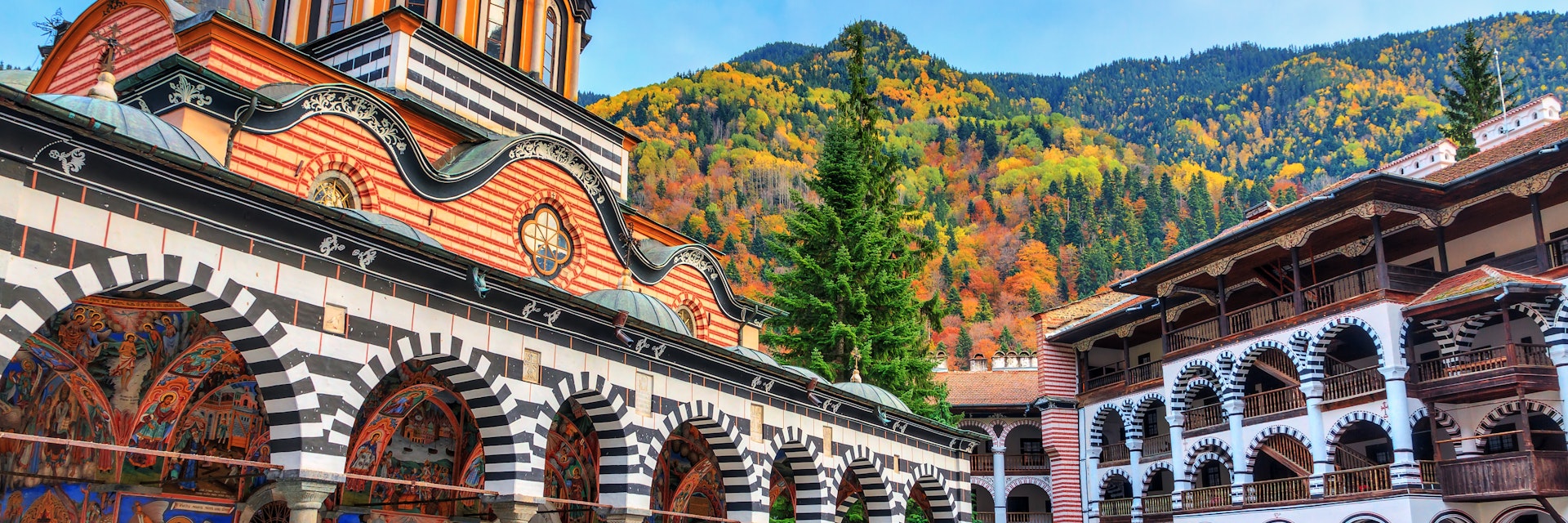
©Dennis van de Water/Shutterstock
Soul-stirring mountains rival golden beaches, while cities hum with nightlife and art. Within Bulgaria’s beguiling blend of nature and history, unforgettable adventures are guaranteed.

Attractions
Must-see attractions.
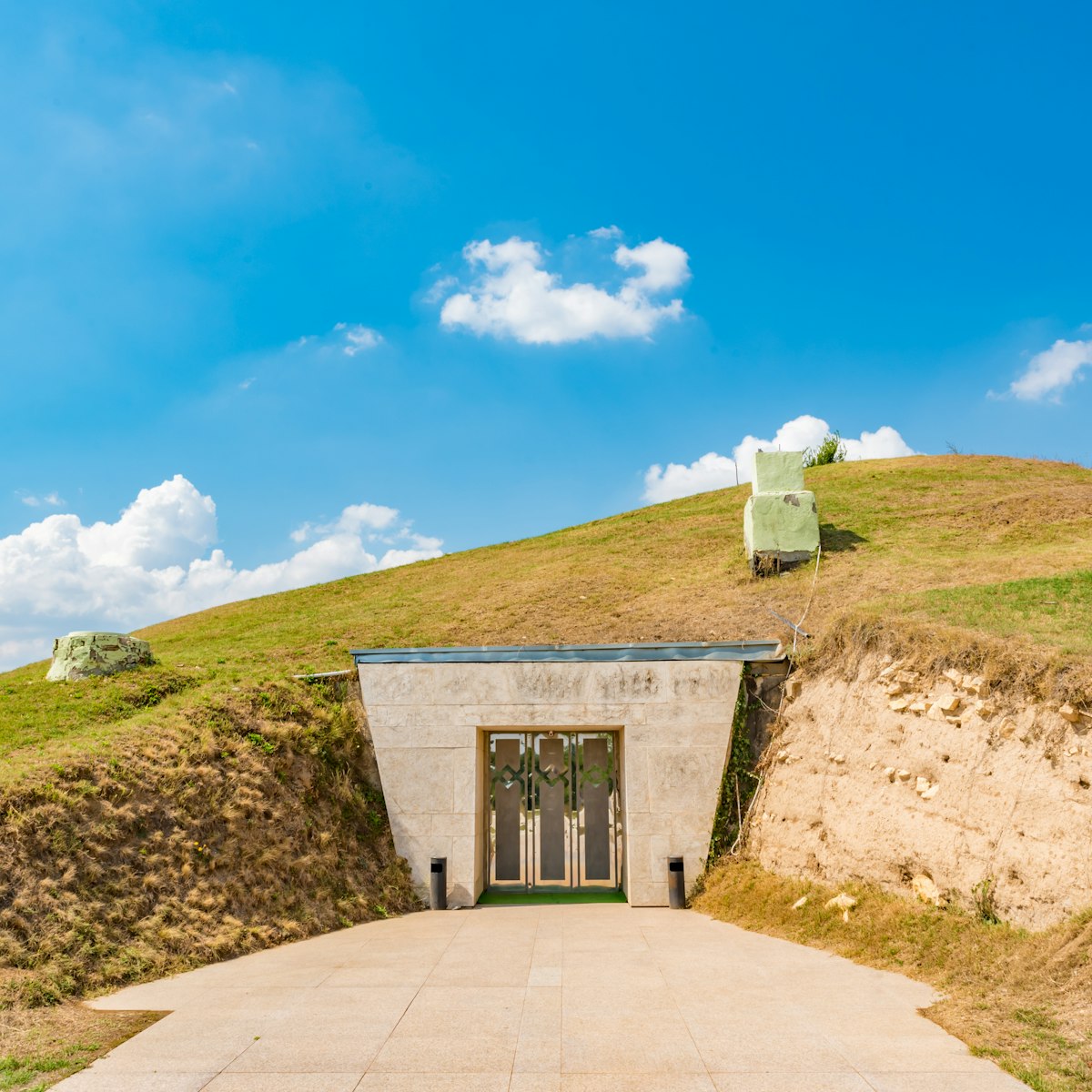
Thracian Tomb of Sveshtari
The highlight at this Unesco-protected Thracian settlement is a nearly perfectly preserved three-chamber burial tomb from about 300 BC. The high quality…

Archaeological Museum
Exhibits at this vast museum, the best of its kind in Bulgaria, include 6000-year-old bangles, necklaces and earrings said to be the oldest worked gold…
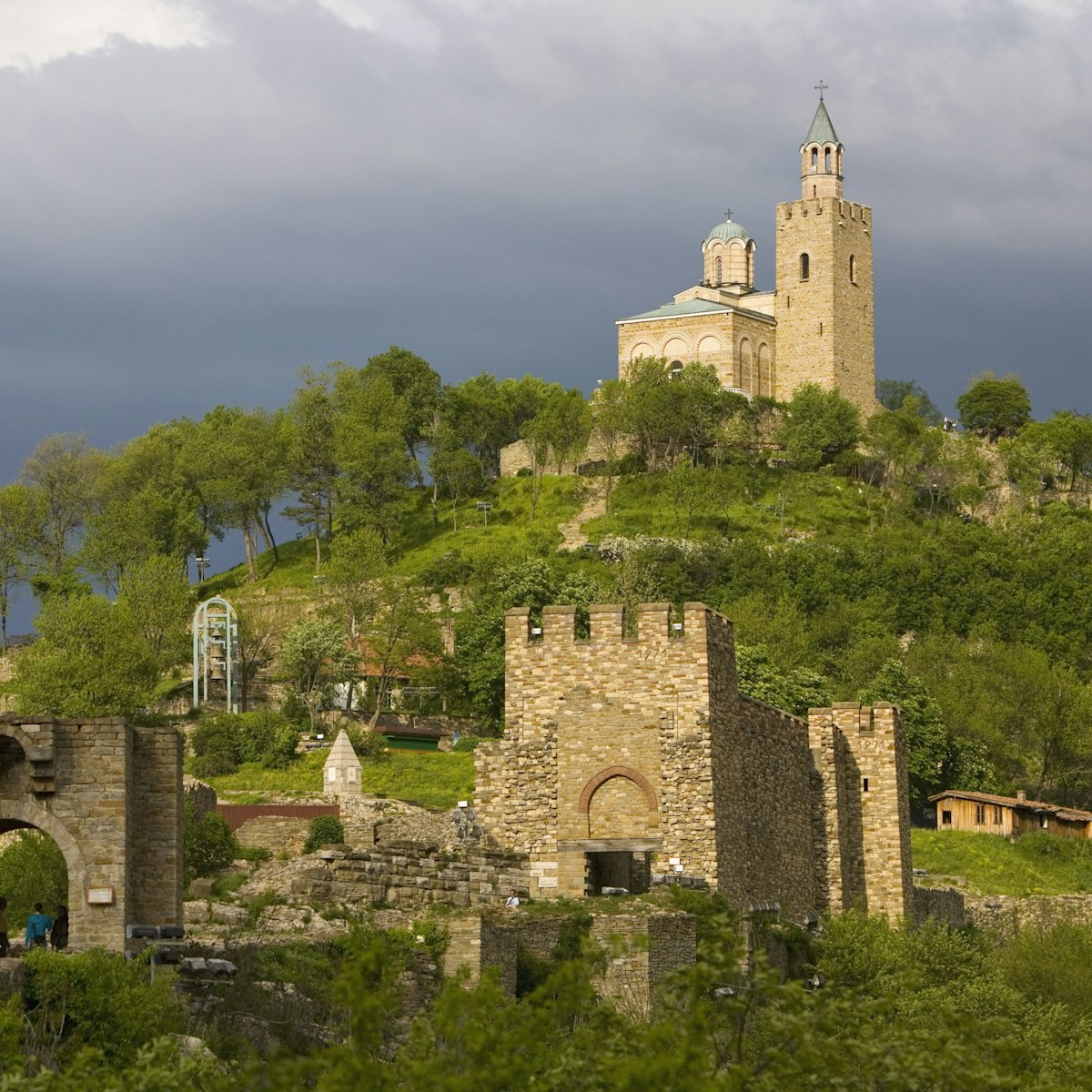
Tsarevets Fortress
Veliko Târnovo
The inescapable symbol of Veliko Târnovo, this reconstructed fortress dominates the skyline and is one of Bulgaria’s most beloved monuments. The former…
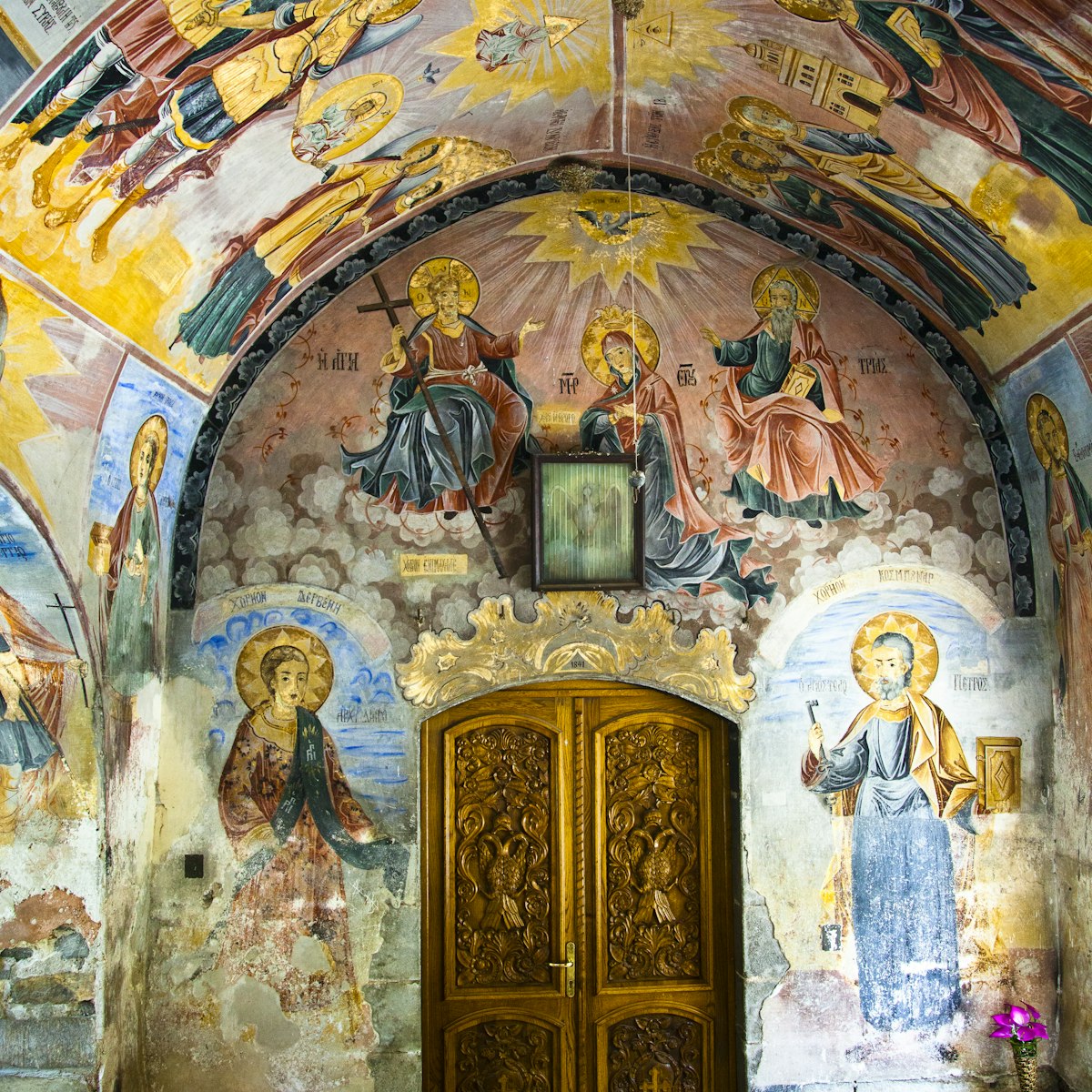
Bachkovo Monastery
Plovdiv & Southern Mountains
About 30km south of Plovdiv stands the magnificent Bachkovo Monastery, founded in 1083. Most of the complex dates from the 17th century onwards, with the…
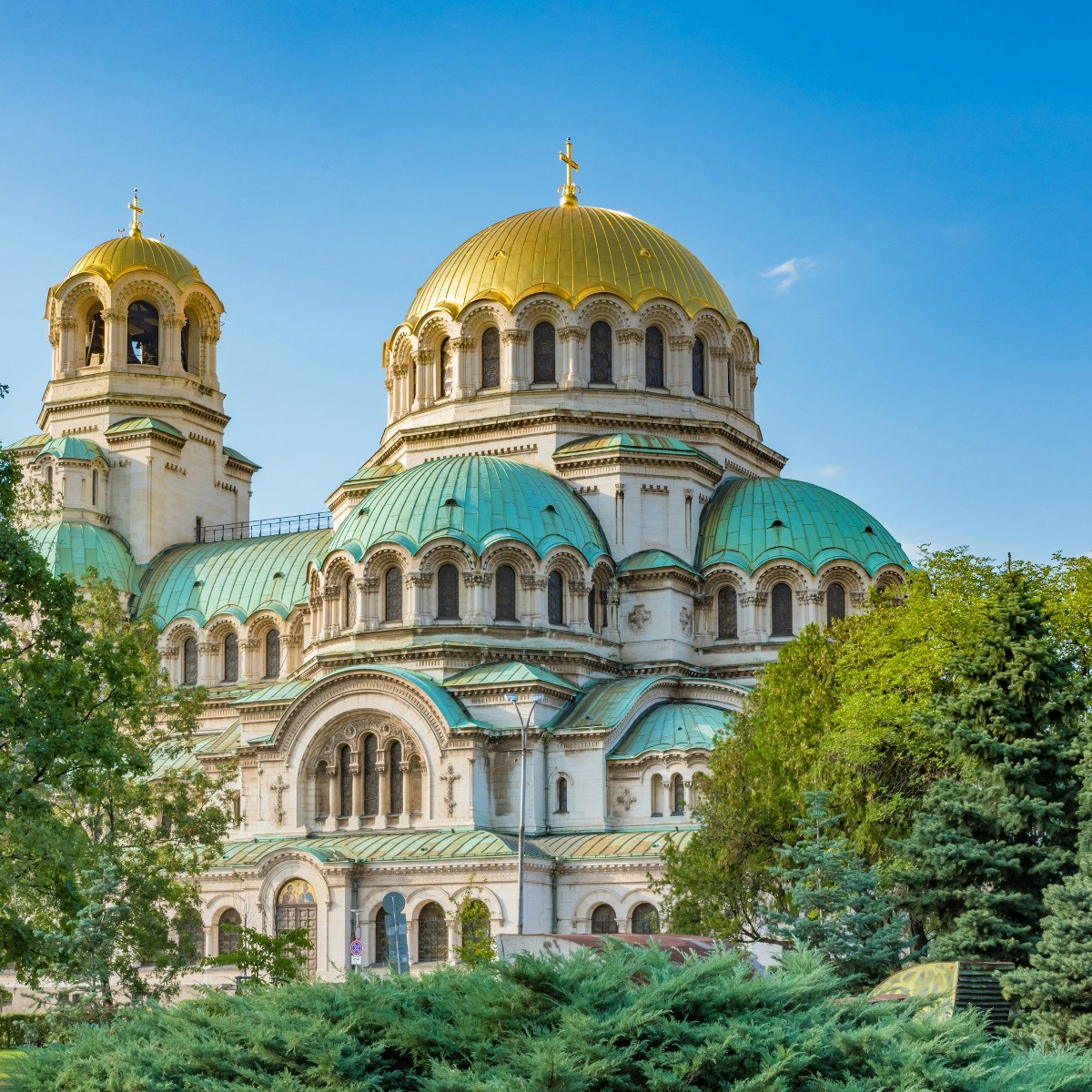
Aleksander Nevski Cathedral
One of the symbols not just of Sofia but of Bulgaria itself, this massive, awe-inspiring church was built between 1882 and 1912 in memory of the 200,000…

Etâr Ethnographic Open-Air Museum
If ambling down cobbled lanes with a stick of halva in hand sounds like an agreeable foray into Bulgaria's past, a day in Etâr will delight. Nearly 50…

Dryanovo Monastery
A history of destruction and revolution, as dramatic as its cliff-backed location, entices visitors to Dryanovo Monastery. Originally founded in the early…
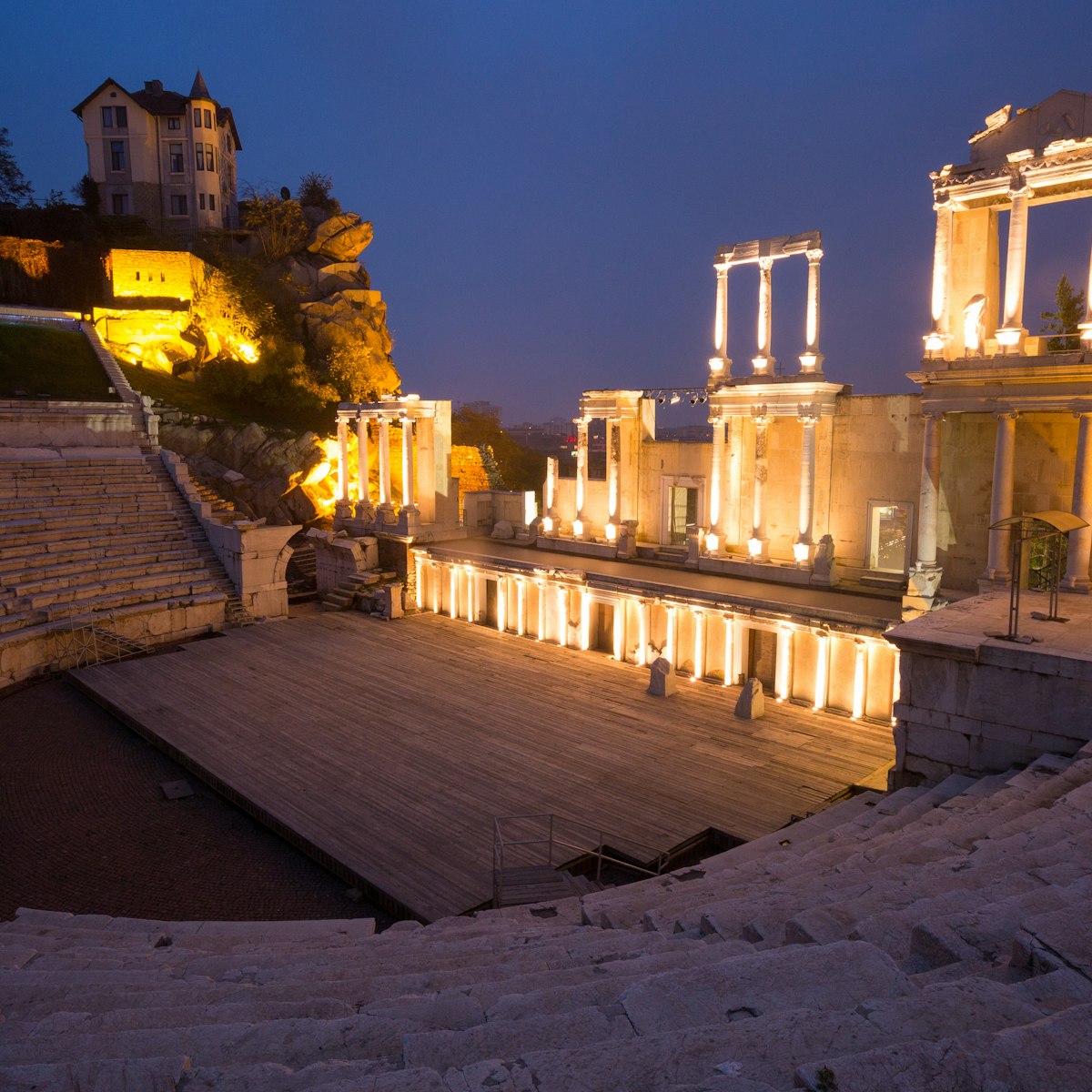
Roman Amphitheatre
Plovdiv’s magnificent 2nd-century AD amphitheatre, built during the reign of Emperor Trajan, was uncovered during a freak landslide in 1972. It once held…
Latest stories from Bulgaria
Filter by interest:
- All Interests
- Adventure Travel
- Art & Culture
- Beaches, Coasts & Islands
- Food & Drink
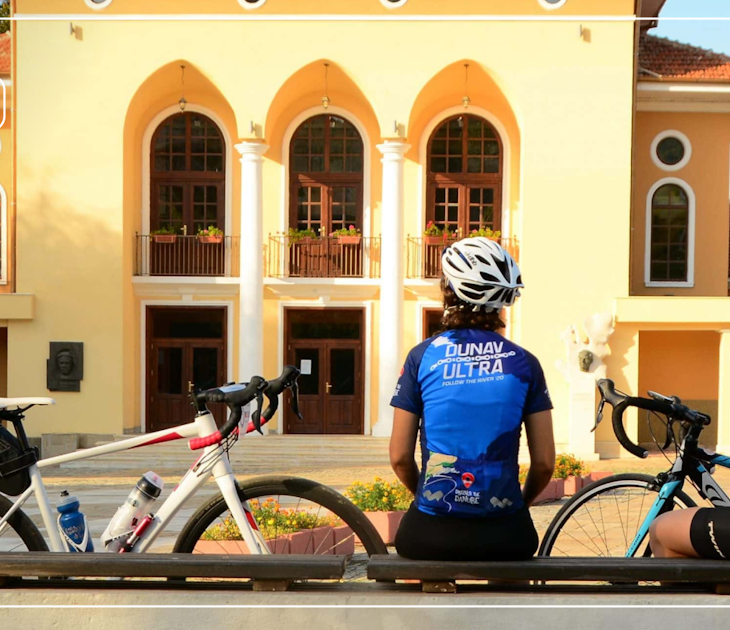
Oct 20, 2023 • 8 min read
This 460-mile ride along the Danube through Bulgaria is one of Europe’s least known long-distance routes. Here’s how to tackle it.
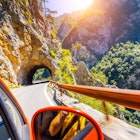
Feb 1, 2021 • 5 min read
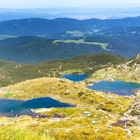
Feb 20, 2020 • 3 min read
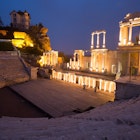
Jan 30, 2020 • 4 min read
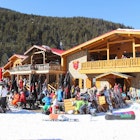
Jan 7, 2020 • 6 min read
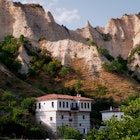
Dec 4, 2019 • 5 min read

Dec 4, 2019 • 3 min read

Nov 8, 2019 • 2 min read
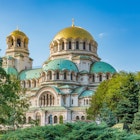
Oct 13, 2019 • 4 min read

Aug 20, 2019 • 2 min read
in partnership with getyourguide
Book popular activities in Bulgaria
Purchase our award-winning guidebooks.
Get to the heart of Bulgaria with one of our in-depth, award-winning guidebooks, covering maps, itineraries, and expert guidance.
Bulgaria and beyond


20 Gorgeous Places to Visit in Bulgaria
Bulgaria offers very varied trips. The Mountain slopes of Bansko and Pomporovo attract skiers in the winter, and the Black Sea beaches draw crowds in the summer months. It has a unique charm all of its own. Here are my favorite beauty spots in this extraordinary country…
1. The Black Sea Beaches
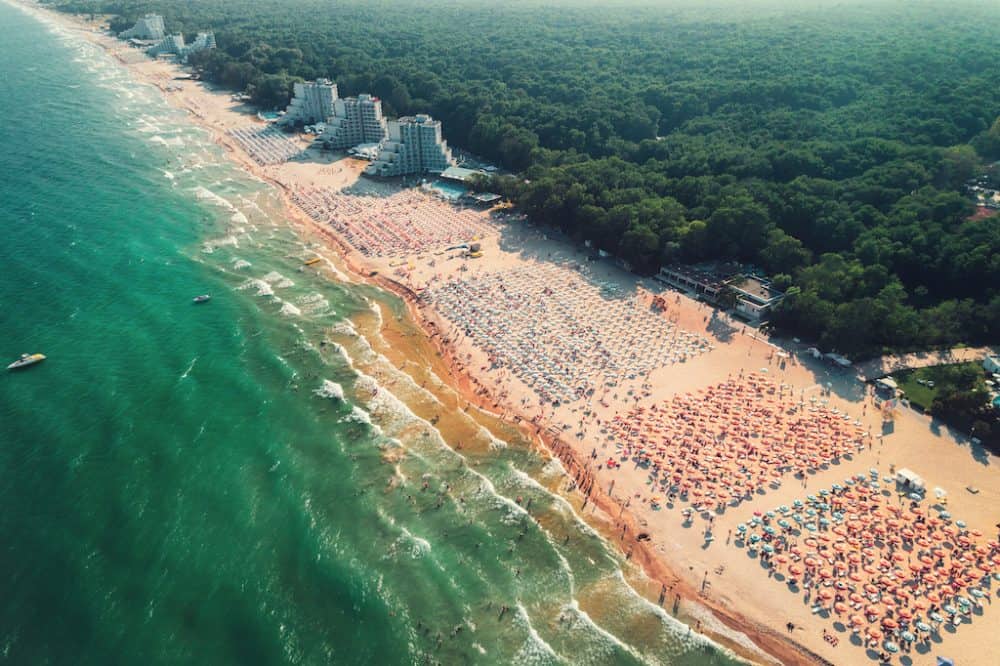
In my opinion, an excellent place to start is the country’s famous coastline. Bulgaria is known for its Black Sea coastline, with long sandy beaches dotted with hotels, traditional fishing villages, and historical sites.
Tourists flock to the glitzier resorts of Sunny Beach and Golden Sands, but I personally believe the city beaches in Varna and Burgas are just as beautiful.
Book A Trip!
We can book your trip hopping around Bulgaria’s beautiful places through our free, top-rated travel planning service !
2. Nessebar

Often referred to as the Pearl of the Black Sea, the historic town of Nessebar dates back to antiquity when it was founded as a Thracian settlement known as Menebria. Greeks, Romans, Byzantines, Bulgarians, Crusaders, and Ottomans all took turns fortifying the ancient town and the narrow peninsula on which it is located.
Today, a stroll on its cobblestone streets will bring you to remnants of 40 brick churches dating back to the 5th century. The beautiful town is such an important site, and UNESCO recognizes it as a World Heritage Site .

One of the oldest towns on the Black Sea coastline, Sozopol is a famous fishermen’s village and seaside resort.
Located 35 kilometers south of Burgas, Sozopol was known in the 6th century BC as Apollonia, complete with a temple dedicated to Apollo. The town is small enough for a casual stroll.
You can walk along the quays as the day’s catch is unloaded or through the old town, with its wooden houses desperately calling out for repair. If the sea is too deep or rough for swimming, you can always sunbathe on the rocks along the shore!
4. Rila Monastery
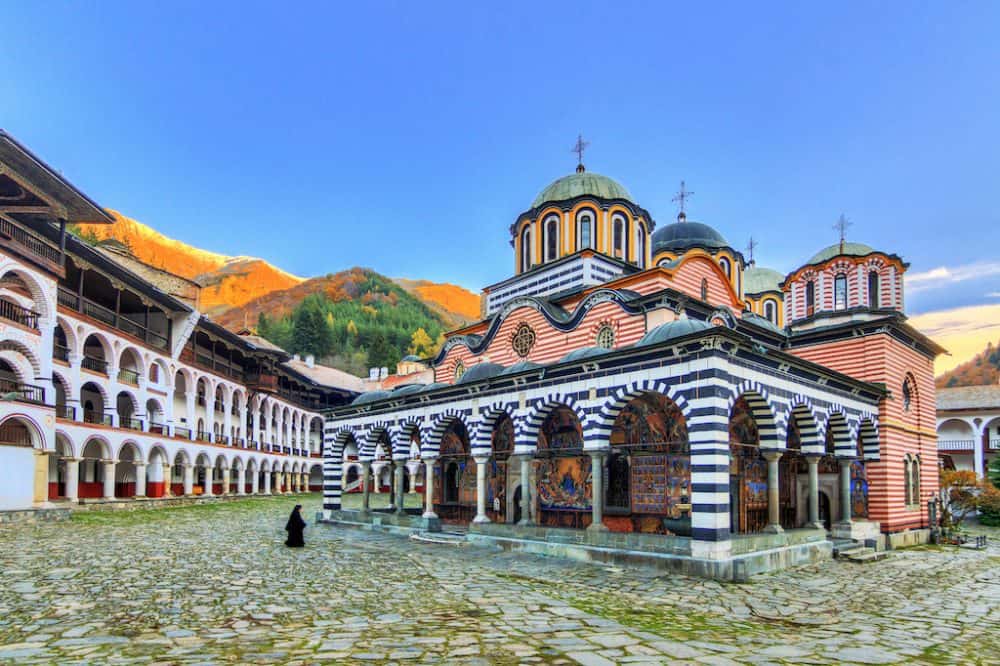
Known as the Jerusalem of Bulgaria, this picturesque Eastern Orthodox monastery in the forested mountains less than two hours south of Sofia is worth a pilgrimage visit.
Named for St. Ivan of Rilski, a tenth-century hermit who lived in a nearby cave, the monastery has been built, burnt, and rebuilt over the centuries, with the latest construction dating to the 1800s.
Enter the courtyard, and you will be stunned by the perfect harmony of the church, with its graceful arches in bold stripes of black and white set under a row of sculpted gargoyles, tiled roofs, and five domes reaching towards the sky.
In the distance are the peaks of the Rila Mountains, complimenting an oasis of serenity perfect for religious hermits and modern visitors alike.

Varna is one of the major tourist destinations in the country. It is easy to see why, in my opinion, it’s a beautiful city with fantastic beaches, excellent restaurants, and lovely green spaces. Varna is often referred to as the sea capital of Bulgaria , as many locals flock to the city in the warmer months.
Varna has many picturesque beaches with fine golden sand and crystal-clear water. A few good surf breaks are also available if you prefer to surf or bodyboard.
Rapongi Beach is perhaps the best beach in Varna, as it is well-maintained and doesn’t get too crowded. You can also travel north to the resort of Sunny Day or Sirius Beach, both stunning locations popular with tourists.
There are plenty of other activities to enjoy in the city, including many excellent clubs, restaurants, and bars along Kraybrezhna Aleya. This part of the city is charming and beautiful at night.
6. Plovdiv Old Town
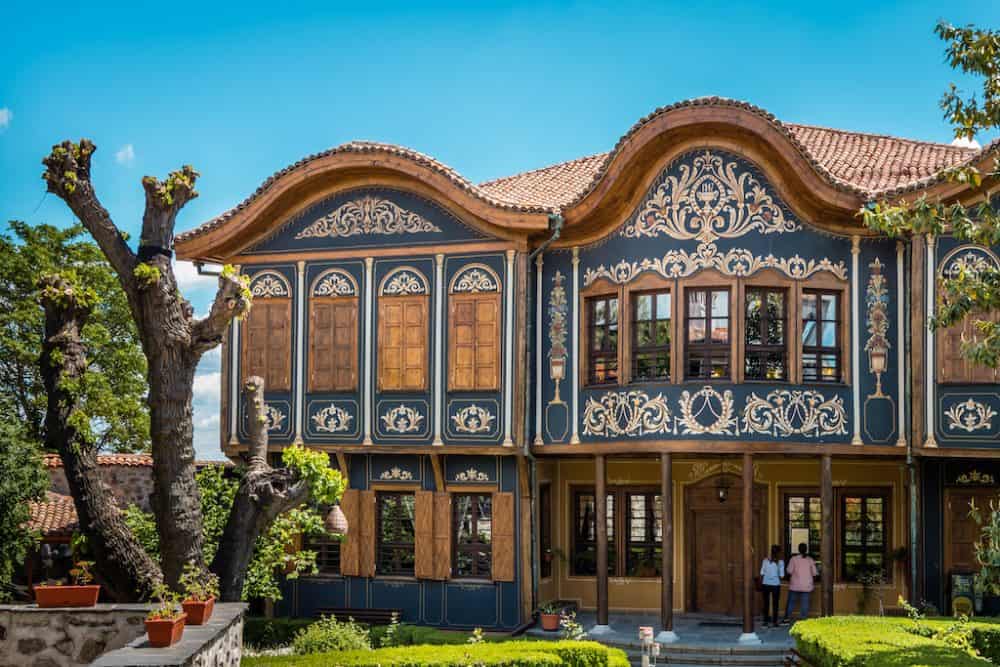
Plovdiv, the second-largest city in the country, has something that Sofia does not – an old town on a hill. The city was founded some 6,000 years ago and developed on seven hills, but one was destroyed at the beginning of the 20th century.
The Old Town towers over the city centre with structures from different eras, including a remarkably well-preserved Roman amphitheatre.
The Old Town is best known for its Bulgarian Renaissance architectural style, with colourful houses displaying the National Revival’s unique exterior characteristics on every corner. Walking up the hill is a delight, with the many galleries and house museums all worth a visit.
7. Belogradchik
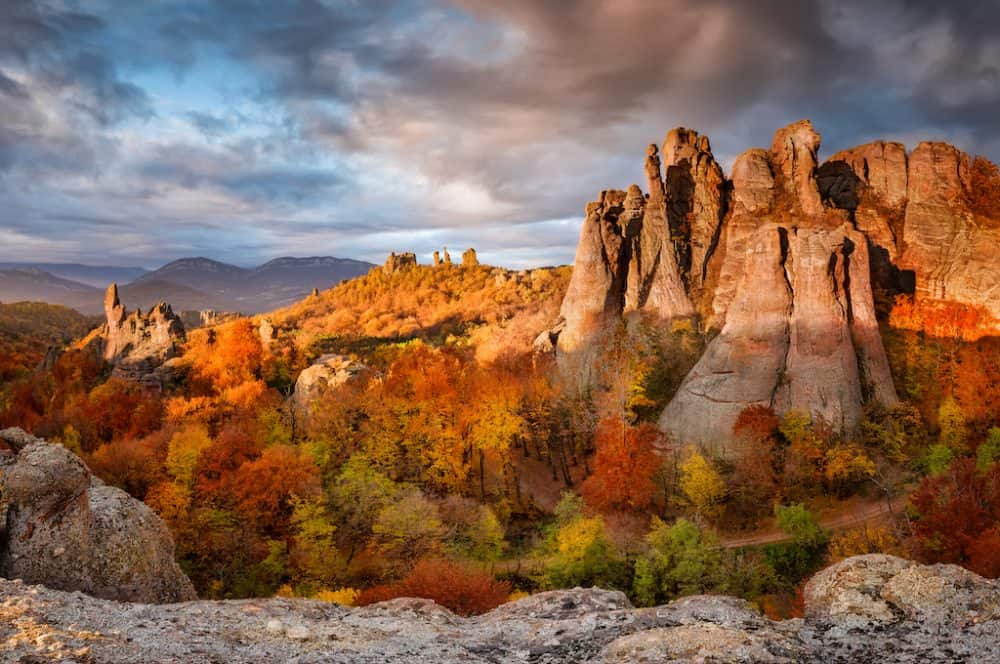
Belogradchik Fortress is an artificial construction set against a stunning outcrop of rocks. The combination is so unique and picturesque that it seems lifted from a Disney fairytale. What’s even more unique than the fortress is the surrounding countryside.
The Belogradchik Rocks, named in 2009 as Bulgaria’s candidate to be selected as one of the New Seven Wonders of Nature, is a stunning arrangement of strange-shaped sandstone and conglomerate rock formations.
8. Lake Atanasovsko
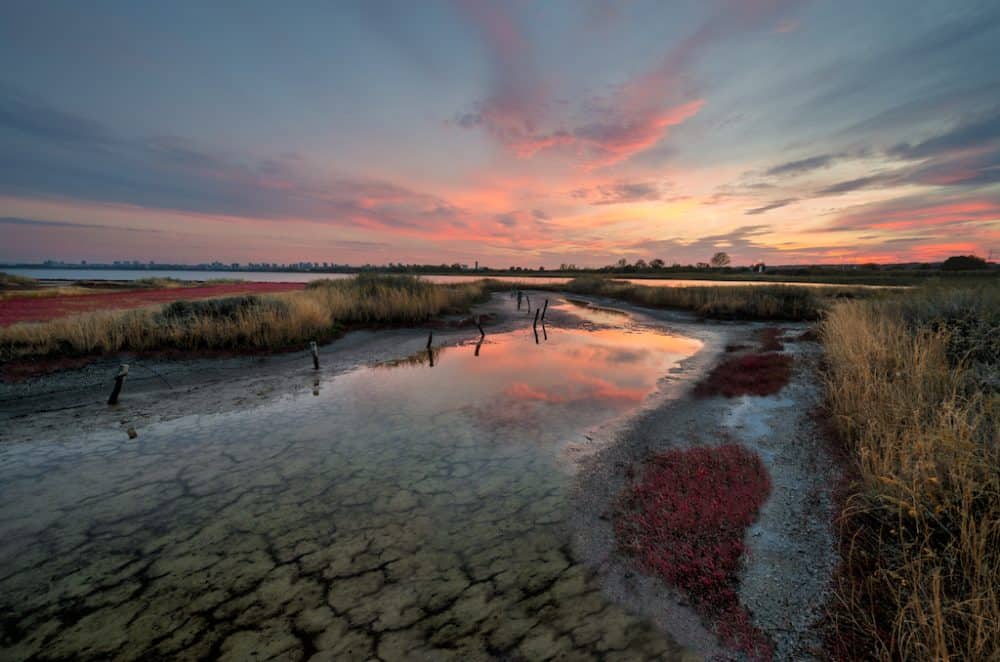
Lake Burgas is a beautiful bright pink lake just west of Burgas. Unlike most other pink lakes worldwide, the lake’s colour is not solely caused by high salt levels.
Although there is a lot of salt in the lake, it is also influenced by the farming of brine shrimp in the water. The lake’s colour tends to vary depending on where the fishermen and salt miners are currently active. Multiple basins in the middle of the south side of the lake are used for salt mining.
These basins often have the most vivid colours, ranging from dark red to soft pink. Unlike other pink lakes, it is possible to swim in Lake Burgas.
It is encouraged because the mud the lake contains is said to have medicinal properties. Some locals believe it has anti-ageing properties and can heal specific ailments; because of this, it’s a well-known wellness attraction.
9. Koprivshtitsa

Walking the narrow alleyways of the village of Koprivshtitsa, some two hours east of Sofia, you’ll feel transported back to the momentous months of 1876, when the locals bravely fought against their oppressive Ottoman rulers.
Inside the colorful houses, representatives of Bulgarian National Revival architecture of the 19th century, local patriots plotted their rebellion leading up to the first shot in the unsuccessful April Uprising.
The village contains memorials and museum houses displaying ethnographical treasures, old weapons and farm implements, national costumes, artwork, and jewelry.
10. Veliko Tarnovo
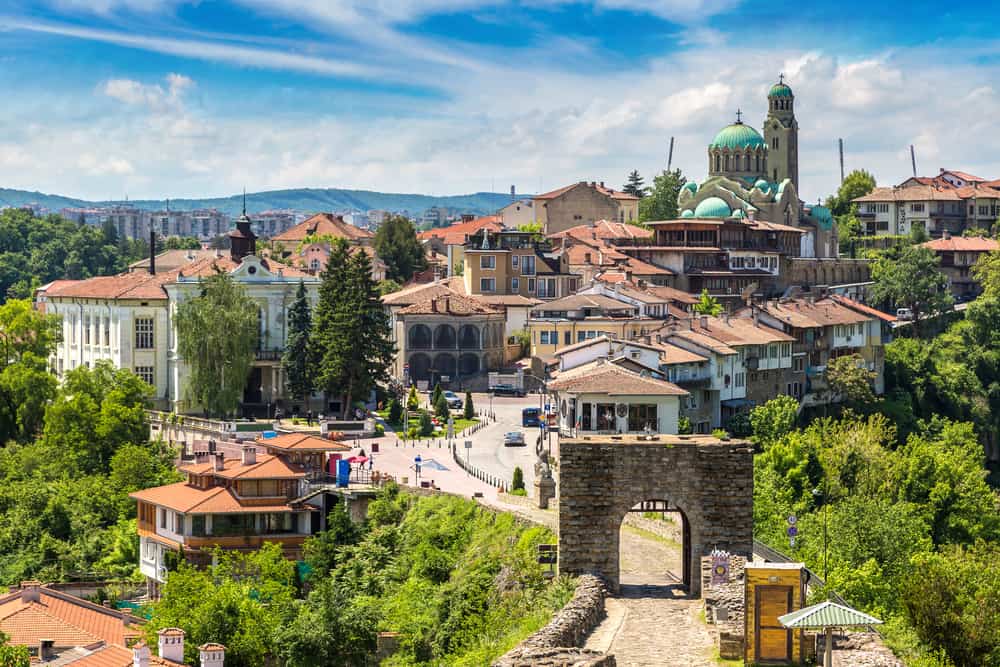
Veliko Tarnovo was the historic capital of the Second Bulgarian Empire between the 12th and 14th centuries. It is located in the centre of the country and is a popular tourist attraction.
The reconstructed Tsarevets fortress bears no resemblance to the medieval palaces of the tsars who ruled from the hilltop until their defeat by the Ottomans in 1393. Still, you can almost sense the country’s former greatness when walking through the gates of this picturesque stronghold!
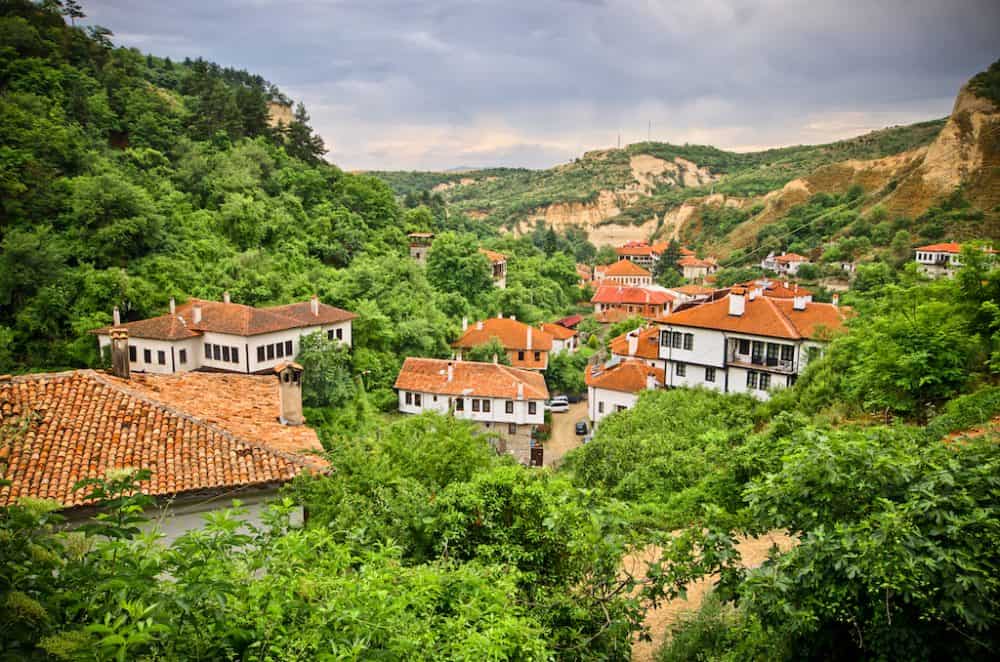
Melnik is known for two things. It is the smallest city in Bulgaria and is home to some of the country’s best wineries.
It will take you minutes to walk up the town’s one main street, but you’ll sit for hours at a local tavern, your head spinning under the intoxicating spell of the rich red wines.
If you get up from your seat, the nearby pyramidal Melnik Rocks and the Rozhen Monastery are worth a visit.
12. Pomorie
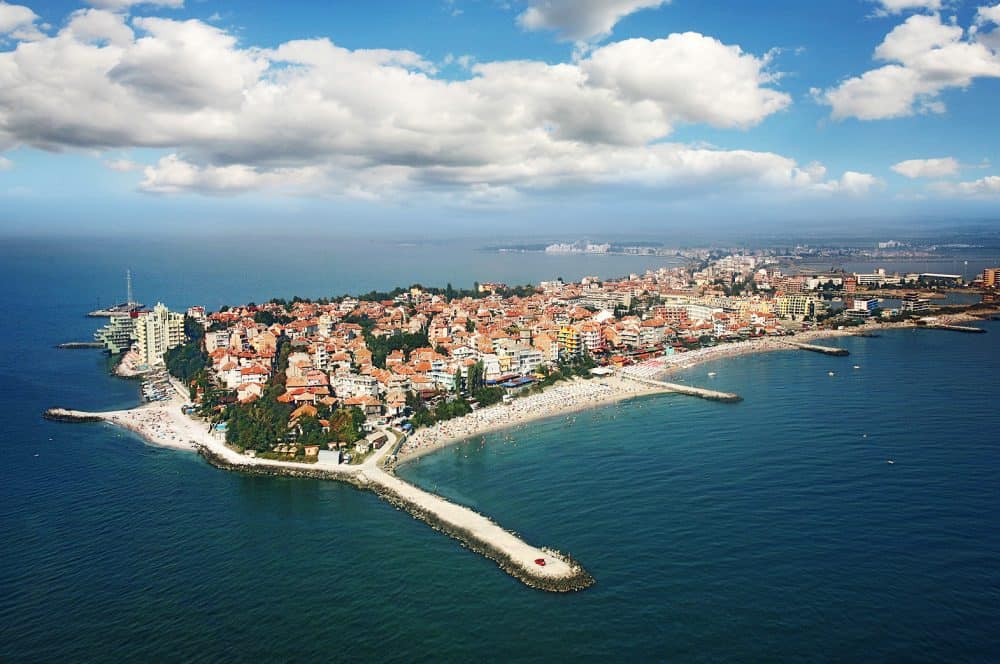
Pomorie is a picturesque coastal resort town in Burgas Bay on the eastern seaboard of Bulgaria. Easily one of the most beautiful places to visit in Bulgaria, the city sits on a narrow rocky peninsula with spectacular views of the coastline to the north and south.
While it attracts many Bulgarian tourists yearly, it is a secret that most foreign tourists don’t know about. The town has two distinct sections — the old town center to the east and the newer, more touristy section to the west/southwest.
The senior town center is charming, with many small hotels, authentic shops, and restaurants. The eastern tip of the peninsula has several small beaches that are usually less crowded than those to the north or southwest.
Sunset Resort is located to the southwest of the town. It is a modern resort adjacent to South Beach, the largest beach in the city. This is a more touristy part of the town, but it is a fantastic location if you want a resort with modern amenities. Pomorie Lake is one of the “must-see” locations in Pomorie.
Located to the north of town, it is a stunning saline coastal lagoon home to dozens of bird species. Medicinal mud is produced at the lake, and visitors can enjoy a refreshing mud bath.
Other attractions in the area include the Museum of Salt, the Pomorie Museum of History, and the street markets in Kableshkovo (held every Thursday). Two local wineries worth visiting are Winery Messembria and Stratsin Winery.
13. The Evksinograd Residence
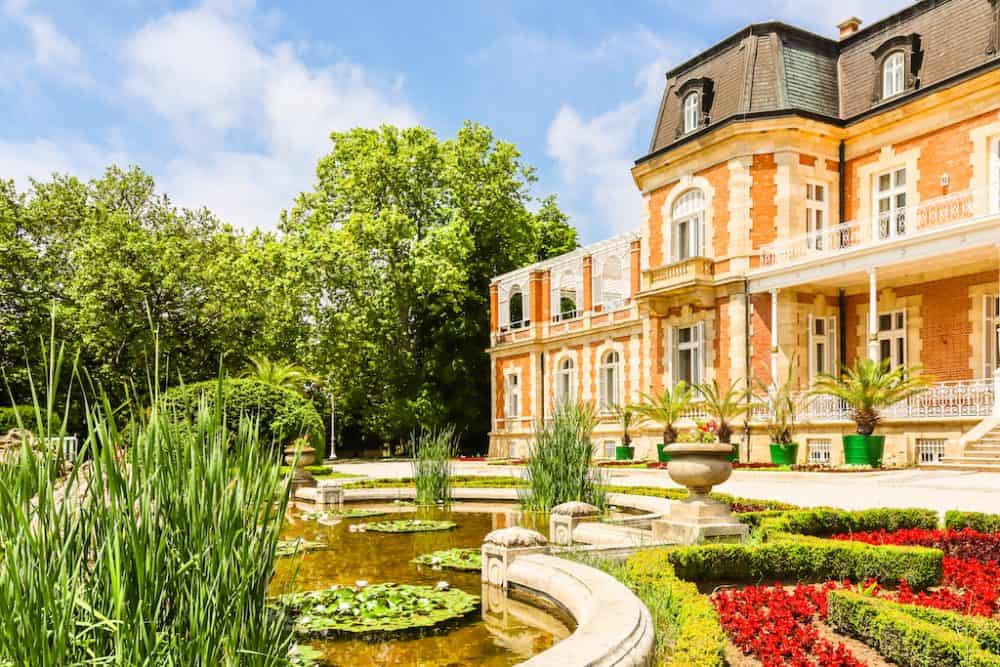
The Evksinograd Residence is one of the most romantic buildings in Bulgaria. Located 8 kilometres north of Varna, this 19th-century palace was often used as a holiday home for royalty.
The mansion’s exterior is very similar to French mansions of the 18th century. It is ornate, romantic, and quite beautiful. The interiors are luxurious, with marble fireplaces, French chandeliers, large dining halls, antique furniture, and rare paintings. Expect to see a lot of gold and silk!
The grounds surrounding the park are no less decadent. French park architects were designed to lay out the 800-acre park. They planted many rare species of plants, some of which are alive today.
At one stage, there were more than 500 species of flowers in the grounds and greenhouses. A winery was added to the palace in 1891, and excellent wines are still produced today. It produces Chardonnay, Riesling, Traminer, Muscat Ottone and Vratsa Muscat wines.
Tourists can visit the palace, explore the parks, and even sample the wines. They can also stay in the palace complex, which has a restaurant on the grounds. It is a beautiful building that is sure to delight.
14. Seven Lakes

This group of gorgeous glacial lakes is located high in the Rila Mountains. The appropriate time to visit the lakes is in the summer, as even in June, the lakes can be frozen, with the terrain alternating between deep snowdrifts and patches of brilliant wildflowers.
The lakes are located one above the other in a mountain valley, interconnected by streams and waterfalls. Access to the lakes is difficult, although riding a ski lift shortens the distance up the steep mountainside.
Legends say the lakes were formed by the tears of a female giant, crying for her beloved! Aw!
15. Belogradchik Fortress
Belogradchik Fortress is an old fortress in northwest Bulgaria on the northern slopes of the Balkan Mountains. It’s close to the Bulgarian town of Belogradchik, home to about 5,000 people.
The fortress was established as a surveillance post when the Roman Empire controlled the region. In the 14th century, the Bulgarian tsar Ivan Stratsimir extended it to include fortified garrisons.
The Ottomans captured the fortress in 1396, making it even more important for repelling the Hajduk insurrectionists in the area.
The way the fortress runs between the vast sections of natural rock is awe-inspiring, with some incredibly scenic views from the top of the defence.
16. Tevno Vasilashko Lake
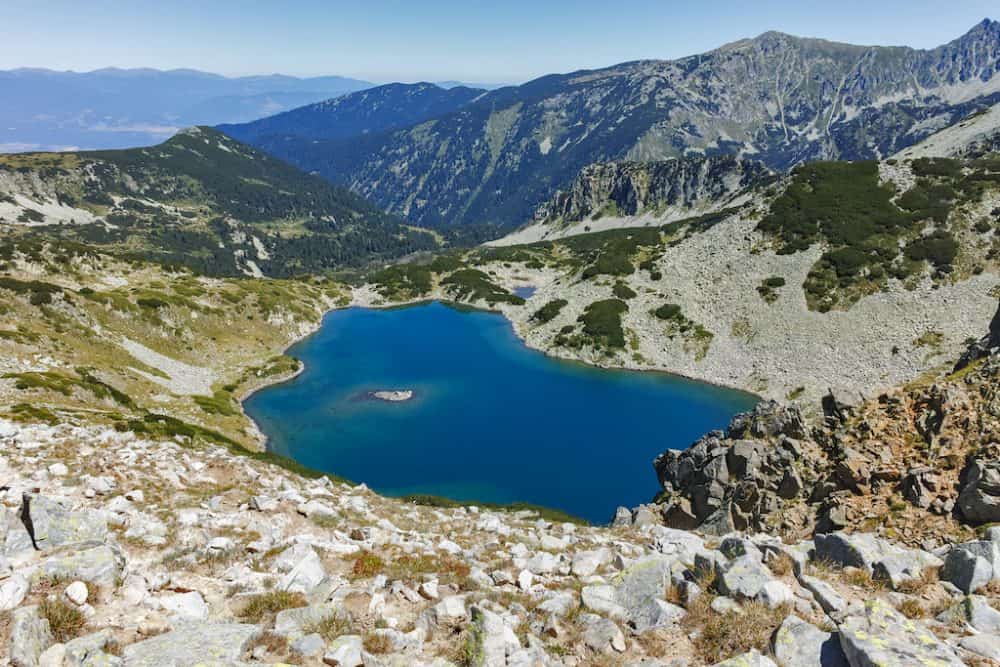
Tevno Vasilashko Lake is one of the most spectacular locations in Europe. It is a magnificent glacial lake surrounded by rugged mountain peaks in Pirin, Bulgaria.
The lake’s unique, saturated blue color reflects the vast mountains nearby. Tevno Lake is the largest of a series of glacial lakes in the Vasilashko Lakes area.
The other lakes are Fish Vasilashko Lake, Upper Vasilashko Lake, Rainbow-shaped Vasilashko Lake, and Upper Todorino Lake. They are all beautiful lakes, but Tevno Vasilashko Lake is the most impressive.
There are tour operators who offer one-day trips up the Vasilashki glacial valley, visiting three or four of the lakes. It is a magical journey that showcases an incredible part of this unique country!
17. Best For Alpine Village
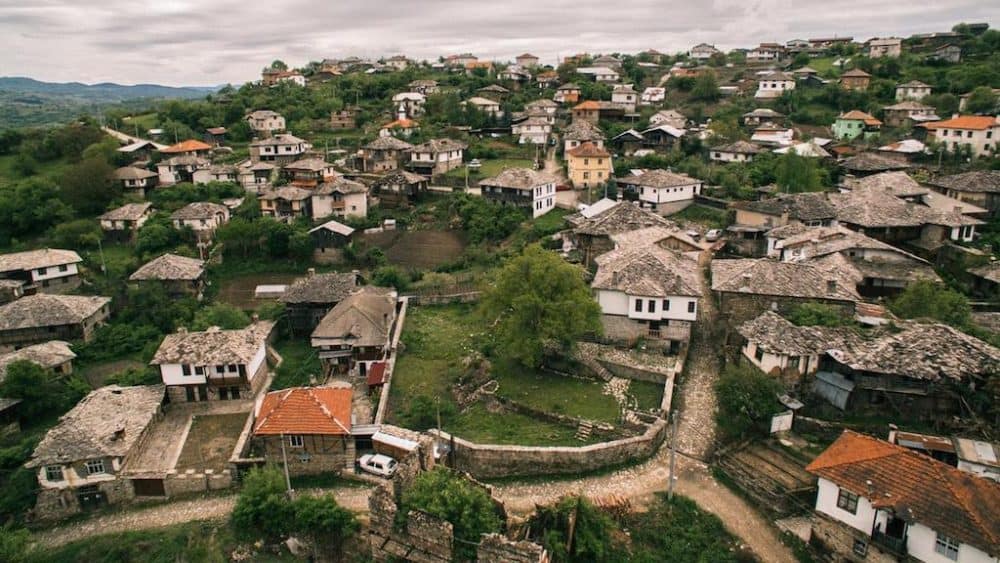
Dolen Village is an alpine village in the western Rhode Mountains (about 26 km from Gotse Delchev). It is one of the most romantic villages in Bulgaria, with narrow cobblestone roads, stone walls, and authentic buildings designed in the Bulgarian Revival style.
The village was founded in the 16th century by Bulgarians escaping the Ottomans who had invaded the country. It flourished in the 18th century as multiple industries in the area became prosperous.
Many houses have stone foundations, timber walls, and overhanging top stories. Inside, there are usually ornate ceilings and elaborate carpentry on display.
The locals have added wonderful gardens to most homes, so walking the streets is like being a part of a beautiful fairy tale. It is an experience you won’t forget.
18. Pirin National Park
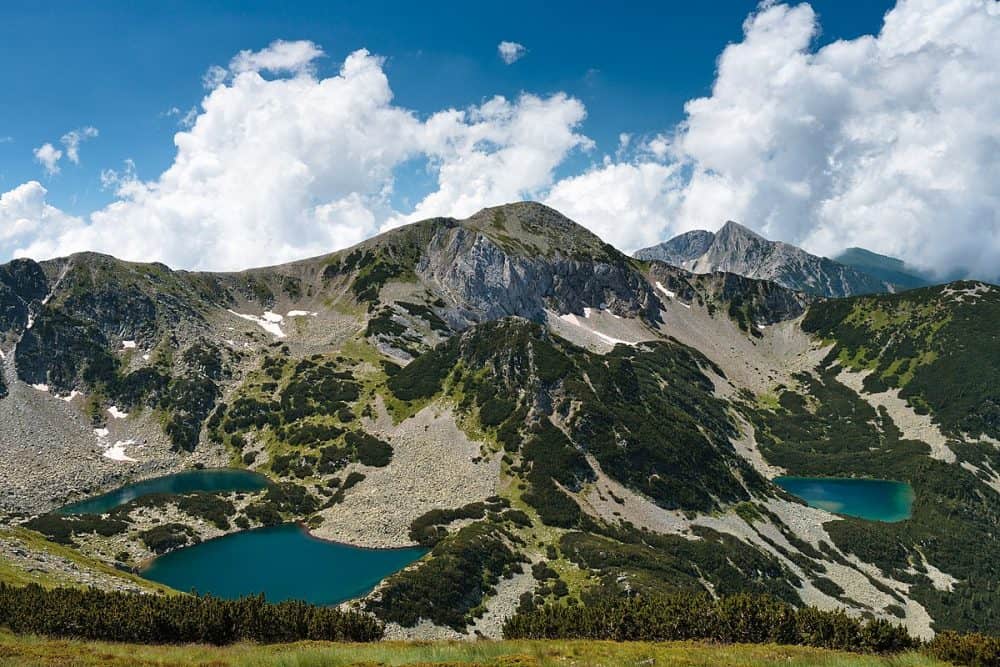
Most travellers don’t realize how picturesque Bulgaria’s natural environment is until they see the Pirin National Park . It is a 403.56 km2 park in southwestern Bulgaria. It encompasses most of the Pirin Mountains, a vast mountain range covering the southwest part of the country.
Pirin National Park was declared a UNESCO World Heritage Site in 1983 and is part of the World Network of Biosphere Reserves. The park is home to over 100 glacial lakes, the largest being Popovo Lake. Many stunning glaciers are also located throughout the mountains.
The park has hundreds of animal species, including the beautiful boreal owl, white-backed woodpecker, fire salamander, agile frog, red deer, and Eurasian three-toed woodpecker.
If you are lucky, you might glimpse one of the park’s rarer animals, such as the lesser spotted eagle, golden eagle, or peregrine falcon!
19. Kamchia Biosphere Reserve
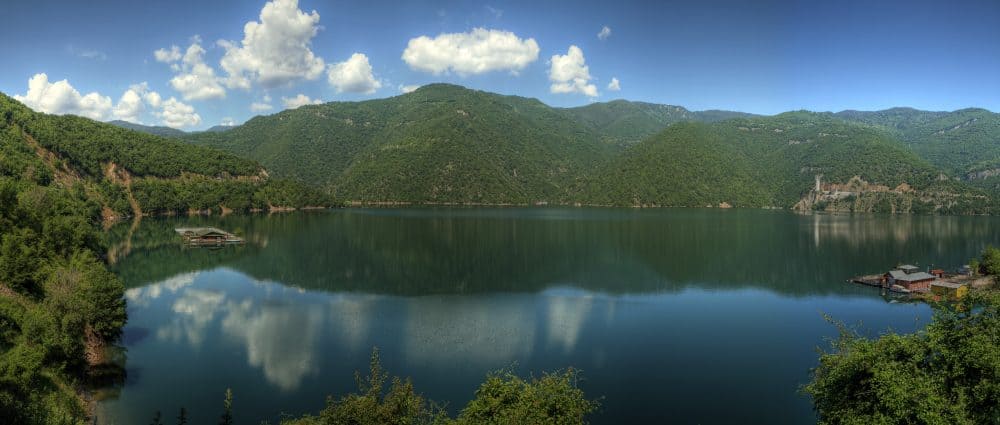
The Kamchia Biosphere Reserve stands out as a National Park because of its massive size and pristine natural environment. This reserve is a 1,200-hectare (2,965-acre) UNESCO-listed biosphere located on Bulgaria’s northern coastline.
It has a varied landscape ranging from vast floodplains at the mouth of the Kamchia River to long beaches adjacent to the Black Sea coastline.
Established in 1977, it contains many ancient forests and spectacular natural waterways. The reserve is located 20 km south of Varna and is surrounded by the villages of Bliznatsi, Staro Oriahovo, and Shkorpilovtsi.
Kamchia is the perfect location for hiking, camping, boating, or relaxing on one of the many vast beaches.
20. Zheravna
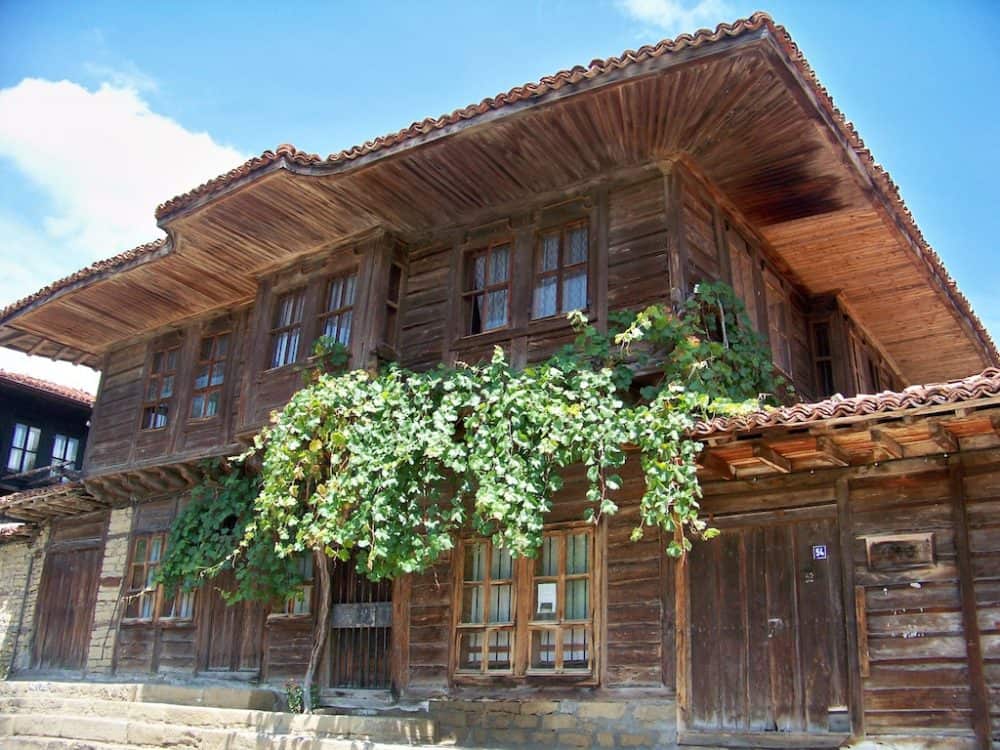
Located in the rolling hills of the Balkan Mountain Range is the magical village of Zheravna. The town is an architectural reserve consisting of more than 200 houses built during the Bulgarian National Revival period in the 18th and 19th centuries.
I love that walking through the village feels like travelling back in time! You will marvel at the beautiful buildings’ detailed red ceramic roof tiles and elaborate timber decorations. Many of the buildings have been converted into guest houses, so it is possible to stay in the town.
The interiors of the guest houses are just as lovely as the exteriors, featuring wooden carvings and ornate carpentry performed by artisans hundreds of years ago. Plenty of nature walks surround the village, plus several museums and an art gallery, all of which I’d recommend visiting!
Beth Pinches - writer and photographer Beth was born under a wandering star, with drama in her veins and ink in her pen. After stints studying theatre in Dublin and Utrecht she used her creative streak to see as much of the world as she could on as little money. She toured Italian Schools with a children’s theatre troop, lived as an au pair in both Rome and Washington DC, explored the British countryside, worked her way through much of Europe, Salsa danced in Cuba and road-tripped down America’s west coast where she discovered her spiritual home; Portland, Oregon. Other places she loves include Croatia, Finland, Japan and India. In between adventures, travel writing and performing she resides peacefully with her family, cats and ukulele. Find Beth on Linkedin or Facebook . Hotel Reviewing Experience - Asked by many tourist boards and many high-profile travel brands to formally review hotels including Visit Jersey , Visit Sweden , and Israel Tourist Board. Also travelled around the world scouting out and reviewing all the most unique hotels in the world, check out our Instagram page for photos . Listed as a top UK travel journalist . Portland Reviewing Experience - Lived in Portland for 6 months and spent many months scouting out all the coolest spots.
32 thoughts on “20 Gorgeous Places to Visit in Bulgaria”
soooooooooooooooooooooooooooonnn 🙂
Great list. Bulgaria is the best choice for the traveler on a budget.
Your post recall my old memories. when I was 17 years old. My father got a Bulgaria family trip from his office. I visit so many places in Bulgaria. Like parks, restaurant and many other. But Back sea beach is very beautiful all over the Bulgaria. Thanks for recall my old memories.
I will travel to Bulgaria for first time where do you recommend I visit? Traveling in Feb/Mar…
Thank you for a wonderful article on Bulgaria my birthplace My home now is NYC for a little over 20 years and unfortunately for me I have lost touch with some of Bulgaria unique places to visit that I have never been even close to except the Black Sea;( I’m planning a very short 3 day trip to surprise my mom for her birthday in July and after seeing the wonderful pics I have made a decision to spend a day in Melnik with my family;) Thank you for sharing with us your experience in BG and I’m glad it’s been a great one ☝️
Im starting to feel that Bulgaria is way misunderstood pertaining to the Engineering and political influence it has had on the world. I think that Ancient Bulgaria could be the birth place of all modern humans and relegious thought. Every ancient discovers in Bulgaria predates all other civilizations! I,m even starting to think that the Dorians , that migrated to the southern Helens in 1200 BC, may have been the Ancient Tracians of Bulgaria. If, my new book is ever puplished, I will definitly spend a lot of ti
When you are on the north of the Black Sea Coast you may made some trips around: the mussel farm Daboka, Balchik with his gorgeous Botanical Garden and Queen Maria’s Castle, Varna with the amazing night life.
Nice article, Bulgaria is very beautiful country! 🙂
Thanks, Bulgaria its a beautiful country
The Bulgarian town Nessebar is one of the oldest settlements in Europe. It has a long and rich history and offers excellent conditions for an unforgettable romantic seaside vacation.
I’m Bulgarian born and bread and I love my country so much and I never tire of its wonders. These photos are beautiful.
Great post! I am bulgarian and Sozopol is a favourite of mine. Thanks for bringing me back 🙂
I’d disagree about the Sofia not being the most attractive city, I liked it’s variety of architecture, as well as its proximity to Mount Vitosha and theamount of greenery in the city itself.
Our friend Ellis has really done a great job highlighting some of the “must-see” spots around the country.
Seven Lakes’s picture stolen my heart. Bulgaria this summer for mr for sure!
Wow I didn’t know there were so many places to explore in Bulgaria. I quite liked Sofia when I was there in 2011, some funny and quirky things about the city, and I would definitely go back to Bulgaria again.
Some fabulous photos of yet another Eastern European destination that remains under the radar..but that only makes it more appealing! Great post.
Great article! I know where I can go for my next beach holiday now 😉
Great article I’ve never really thought of visiting but these places definitely look very beautiful.
Great photos! We were so close to going to Bulgaria when we were in Turkey last year…and now I wish we had! Maybe next year we’ll make our way there.
Cheers for the great post!
I’m planning to visit Bulgaria this summer between my Brussels and Holland voyages and you guys made me wanna go there even more! The Black Sea beaches simply rock!
Agness my friend! I wish I was still in Bulgaria to show you around.
Yes! I haven’t been to all the places mentioned, but I agree…Bulgaria is gorgeous. Melnik is one of my favorite memories of the whole trip. The best thing about Bulgaria other than the beauty and the people….the food! Delicious!
Melnik is a wonderful destination. And yes, the food in Bulgaria is very, very good. I am glad you enjoyed visiting Bulgaria and stopped by to read this article and remember. You’ll just have to go back again to visit the places you missed.
Thank you, Ellis, for doing so much for Bulgaria. Your persistence as a foreigner to portray the best we have here is amazing. Great job!
Thanks Ivan. Coming from you, this is a real compliment!
Wow, I never knew Bulgaria was this pretty! We’re in the very early stages of planning a europe trip and I just added Bulgaria to the list 🙂
Angela, I hope you do get to visit Bulgaria very soon! (Go there now before too many tourists discover this amazing destination).
Bulgaria is pretty low on the travel radar for me, but these places look so beautiful. I think it may be worth a visit.
I would never have considered visiting Bulgaria, until the day my job was relocated to Sofia. Now I am really thankful that I had a chance to live, and work, and travel in Bulgaria!
Wow, waht a gorgeous pictures and such an interesting post! I sure want to go back to Bulgaria to visit some of the above places. I have only visited Sofia once, for a week, and we loved it! Indeed, even Sofia is totally under the radar of travelers. It deserves better! The only difficult thing for us was the Cyrillic handwriting on streetnamesigns and so on….;-)
Hey Curly Traveller,
I’m glad you had a chance to visit Sofia. That was our home for two years. After awhile, you begin to understand the Cyrillic texts on street signs and stores. Even dealing with menus is a talent that you can pick up, but it’s a challenge!
Leave a Comment Cancel reply

Touropia Travel
Discover the World
12 Top Tourist Attractions in Bulgaria
By Becky Griswold · Last updated on October 3, 2023
Bulgaria is a country of diverse landscapes and a depth of history which results in a nation filled with natural beauty and cultural richness that dates back to ancient times.
With high rocky peaks home to picturesque mountains, huge national parks where endangered animals roam wild, and swathes of sandy beaches that hug the Black Sea, along with relics of the Soviet rule, there is something for everyone to discover in the bold and this beautiful Balkan country . Here’s a look at the top tourist attractions in Bulgaria:
12. Alexander Nevsky Cathedral [SEE MAP]
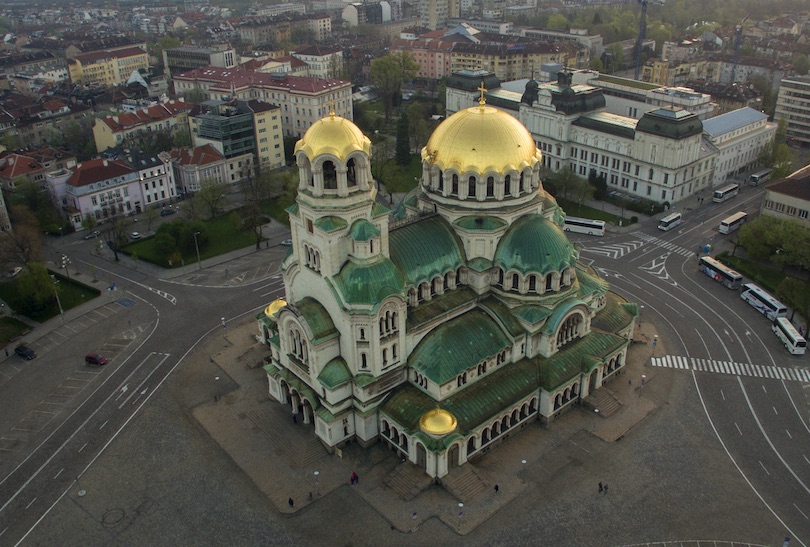
Situated in the heart of the stunning city of Sofia is the iconic symbol of Bulgaria: the Aleksander Nevsky Cathedral. Paid for by the people of the city and built between the years 1882 and 1912, the cathedral was constructed to honor the lives of the 200,000 Russian soldiers who were killed fighting in the Russo-Turkish war for Bulgaria’s freedom from the rule of the Ottomans.
The cathedral itself is ornately detailed, with a decadent 45-meter high, gold-plated dome. Inside, you can walk among the many intricate mosaics, meaningful murals and depictions of saints and angels; huge chandeliers hang low, dripping in decadent gold, whilst the solid wood of the altar and pews is delicately carved.
11. Krushuna Waterfalls [SEE MAP]
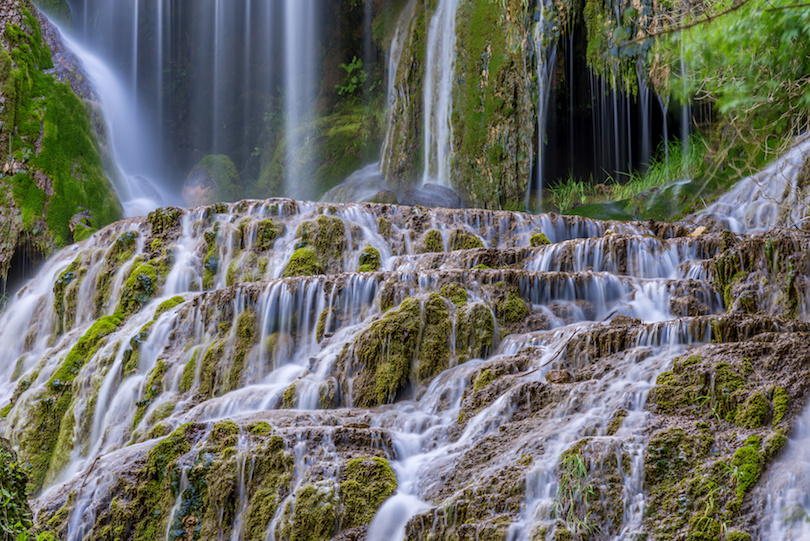
Close to the village of Krushuna, nested in a lush forested landscape among the many karst rock formations, are the Krushuna Falls. The tallest of the falls is 20 meters high, where the turquoise water then splits into smaller falls and cascades over hunks of limestone, forming gentle pools and curious curves in the rock.
It is easy for visitors to reach the waterfalls and explore the surrounding area over bridges and steps. One pathway leads to a hidden cave where the source of the waterfall can be found – the spring is said have health benefits and is still a popular spot for locals from the nearby village.
10. Koprivshtitsa [SEE MAP]

Walk along the old winding road of Koprivshtitsa town, past the tricking streams and the colorful buildings, and be taken back to a Bulgaria of the past. Set in the heart of the Sredna Gora mountain range, historic Koprivshtitsa town was once a center for the fight against Ottoman rule and still today remains a place of Bulgarian pride.
The town is now popular with visitors and is an open air museum; its many mansions and houses are fantastic examples of the Bulgarian National Revival that occurred during the 19th century.
9. Buzludzha Monument [SEE MAP]
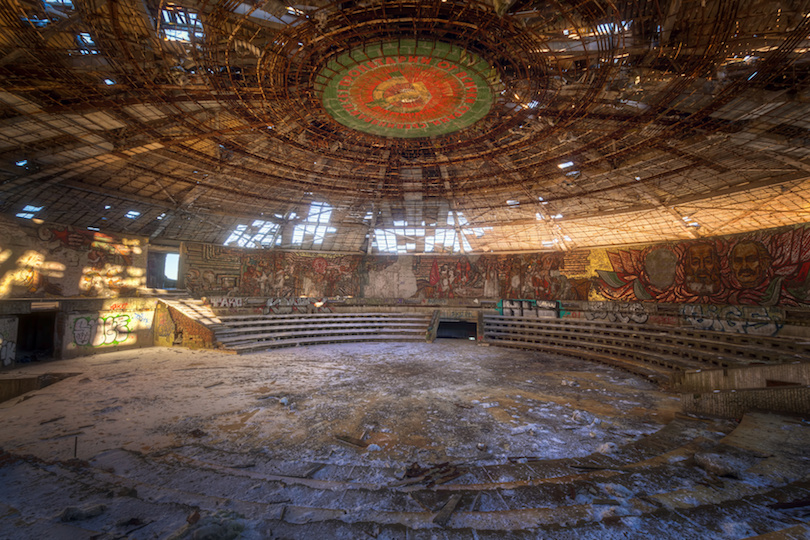
An icon of brutalist design and a masterpiece of Soviet proportions is the now abandoned Buzludzha Monument. Built in 1974 by the Bulgarian army, the monstrous monument was designed by various artists and creatives in charge of statues during the era.
The monument stands on the spot of a battle between the Turks and the Bulgarians which took place in 1868 and is where Dimitar Blagoev, along with other socialist leaders, outlined Bulgaria’s revolution into a communist state.
The stoic structure is now covered in political graffiti and has huge depictions of Lenin and Marx as well as lettering across the facade. The huge flying-saucer-shaped shrine to socialism was left to ruin after the fall of the Soviet Union but has become an unusual attraction for those interested in the history and striking design of the era.
8. Vitosha Mountain [SEE MAP]
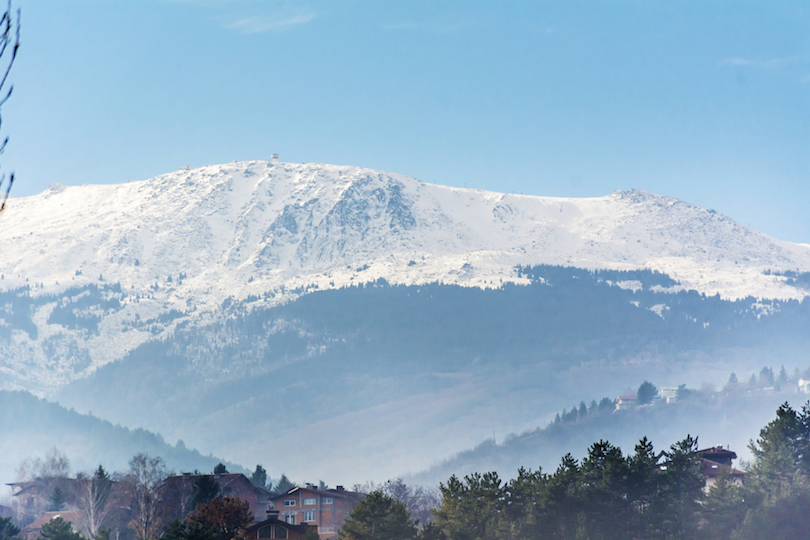
The classic dome shape of Vitosha Mountain sits close to the urban sprawl of the city of Sophia and is where people go to take a break from the city and enjoy nature. With its own ski resort, pleasant hiking routes and fantastic panoramic views of the city below, the mountain is easily accessible from the city and can be reached by bus, on foot, and ropeways.
Vitosha Mountain’s highest point is 2,290 meters high and attracts visitors all year round who are drawn there to explore the Vitosha Nature Park, which is actually the oldest in the Balkans, and covers most of the mountain, as well as the mineral springs in the foothills.
7. Thracian Tomb of Sveshtari [SEE MAP]
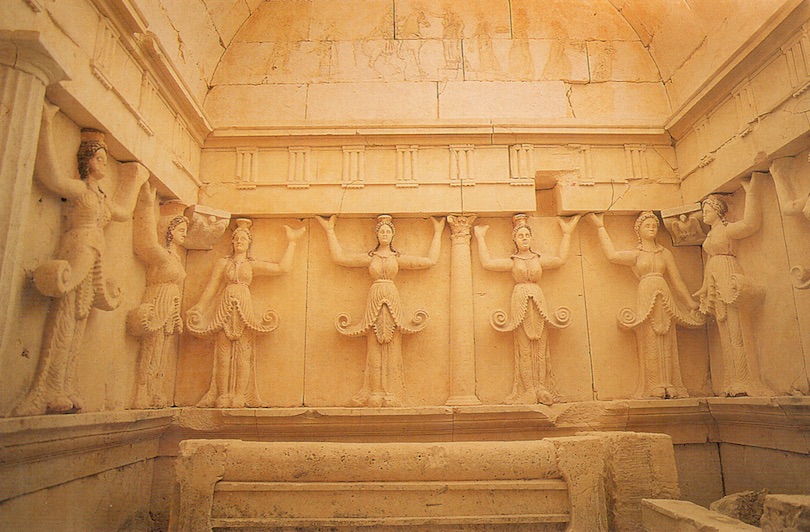
The ancient Thracian tomb of Sveshtari was only discovered in 1982 when archaeologists uncovered the impressive site underneath a mound. The tomb is thought to have been built for a royal couple from the Thracian tribe of the Getae and dates back to the 3rd century BC.
The tomb is wonderfully well preserved; its ornate interior reveals impressive carvings and murals of half-female, half-plant figures which appear to be holding up the ceiling. The tomb is thought to be unique as there has been no other Thracian tomb discovered that has Sveshtari’s combination of astonishing architecture, sculpture and paintings.
6. Tsarevets Fortress [SEE MAP]
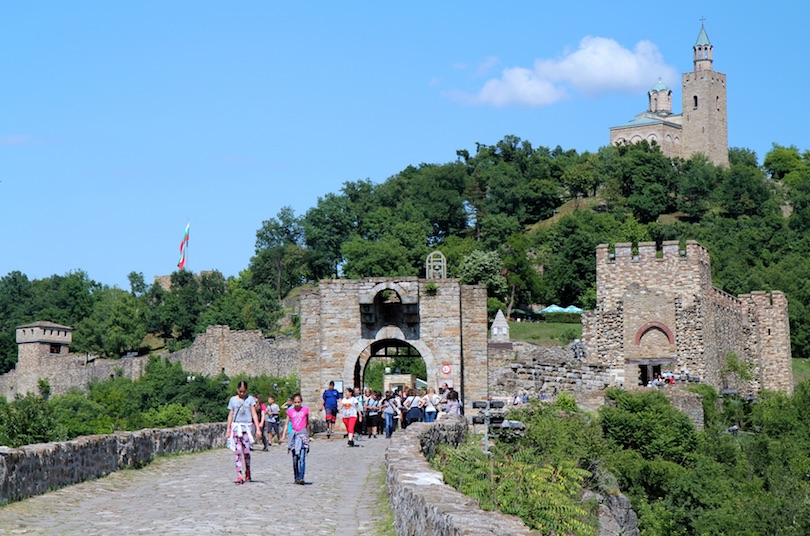
A symbol of Bulgaria’s past greatness, Tsarevets Fortress is built on the spot where the palace of the medieval tsars once stood 800 years before when Tarnovo was its capital. Explore the ancient rambling ruins and stumble across the remains of over 400 houses and innumerable churches.
The panoramic views of the surrounding landscape reveal how the location of the fortress was strategically placed, 206m above sea level, to protect the kingdom from invasion for hundreds of years. Visiting the stronghold involves a lot of walking up steep slopes, but because the only access to the fortress is on foot you can wander the grounds and climb the old walls in peace.
5. Sunny Beach [SEE MAP]
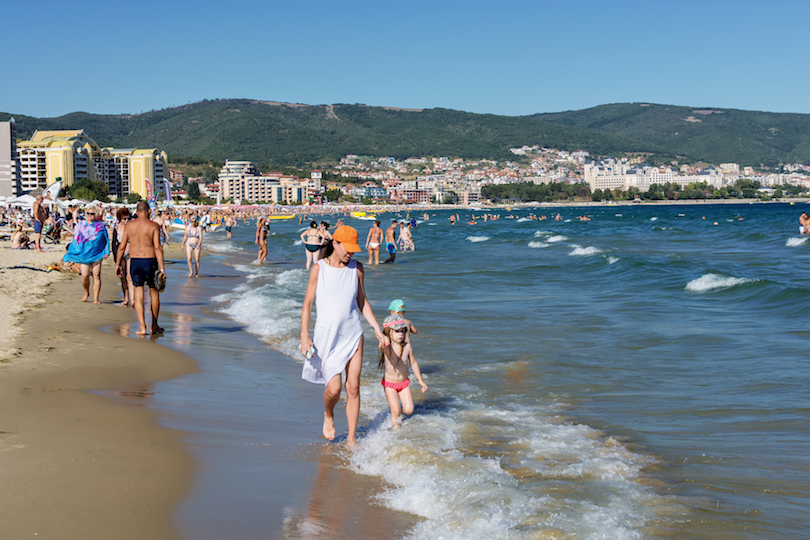
Sunny Beach is famous for long stretches of soft, sandy beaches that slope into the Black Sea and also for its numerous tourists who visit the resort town to enjoy its lively nightlife. The golden beaches stretch for eight kilometers along the coast and offer the perfect spot to spend time soaking up the sun and taking a swim.
The beaches in the area are clean and are sheltered from the elements, meaning the sea is perfect for swimming, whilst the plentiful hotels along the coast are also reasonably priced and family-friendly. This is the place to visit if you want to spend a few days relaxing in the sunshine and exploring the surrounding area, such as the ancient town of Nessebar.
4. Plovdiv Roman Theater [SEE MAP]
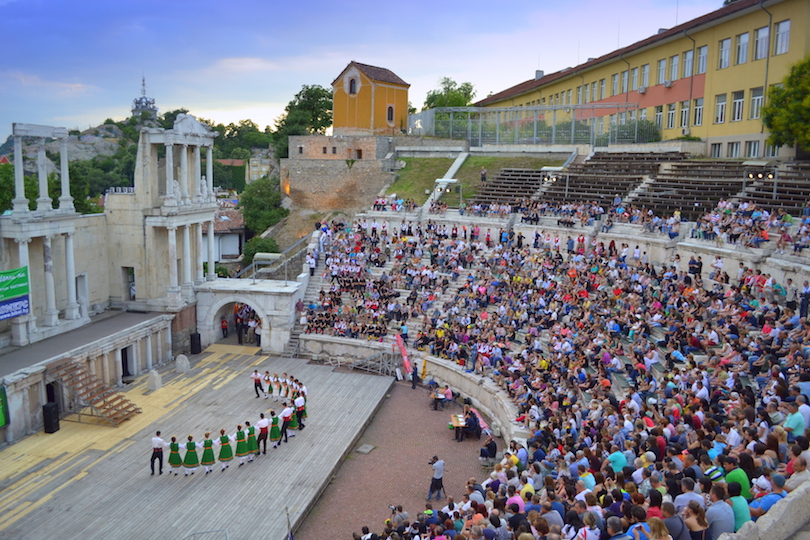
In the center of Plovdiv Old Town is one of the world’s best preserved ancient theaters. Discovered in the 1960s, the spectacularly striking structure dates back to the 1st century AD and is thought to have been built under the rule of the Roman Emperor Domitian.
The site would have played an important role in the ancient communities: this was where theatrical performances and famously ferocious gladiator fights would take place, as well as local government meetings and big gatherings.
The theater itself is still in use for opera and musical performances and holds an impressive 7,000 people. Amble along the old cobbled streets of the town and up the hill to the ancient theater, sit among the rows of sloping seats and soak in the silence and take in the uninterrupted views of the surrounding landscape.
3. Pirin National Park [SEE MAP]
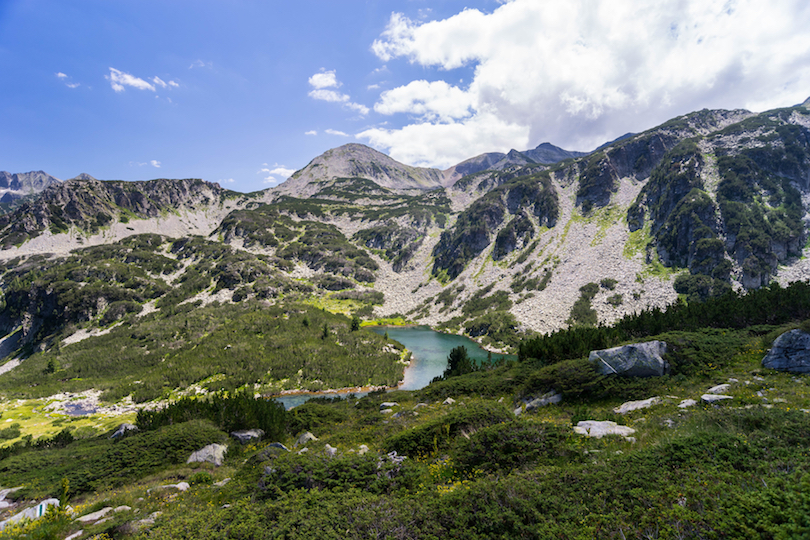
Home to more than 70 glacial lakes, old forests and soaring 2,915-metre peaks and ridges, the Pirin National Park is a Bulgarian national treasure. The National Park is a safe haven for many different types of rare species that use the Balkan mountain range for shelter. Large animals still roam the slopes, from brown bears and wild boar to gray wolves and jackals; this is a remote and wild area that is under threat from development by ski resorts.
Spend your time visiting the unimaginably beautiful park by hiking the numerous paths, cycling among the alpine meadows or fishing alongside waterfalls. You can even stay overnight in Pirin’s huts, and find the famous Baykuchevata Macedonian pine tree that is said to be approximately 1,350 years old!
2. Old Nessebar [SEE MAP]
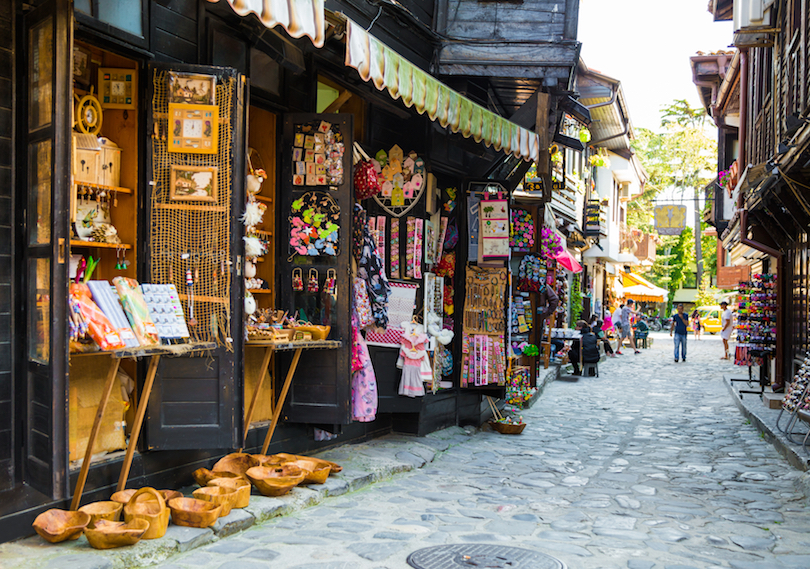
Nessebar has been charming visitors for the past 9,000 years and it keeps on enchanting people to this day. Set on a craggy peninsula that is connected to the mainland by a causeway, the charming old Nessebar town is an open-air museum packed full of pretty squares, churches and cobbled streets. The town’s history and monuments span the Roman and Byzantine eras, and remains of the old town walls can still be seen.
This fascinating town is packed full of character: take a look in the traditional timber houses built on sturdy rock foundations, sit and watch the windmill on the bridge between the old and new towns, and step silently in the stunning churches and chapels.
1. Rila Monastery [SEE MAP]

Take a trip to Rila Monastery and soak in the serene surroundings among the Rila mountains. Founded in the 10th century, and held in high esteem as being an important historic and cultural monument, the Eastern Orthodox Rila Monastery is an architectural icon.
Labelled as the Jerusalem of Bulgaria, it is the biggest monastery in the country and is home to compelling religious iconography, including wall paintings, carvings and historical artifacts.
The ancient monastery is still active and is home to around 60 monks who still live and work in the tranquil peace of the monastery inside its ornate buildings. The striking stripes of the exterior and gently curved arches, along with the crowning domes, set the monastery apart from the surrounding tree-covered mountainous landscape.
Share this post:
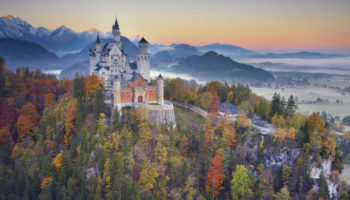
25 Top Tourist Attractions in Europe
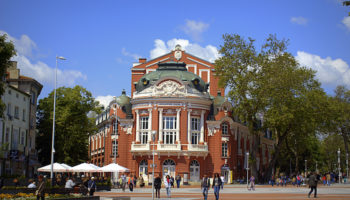
10 Best Places to Visit in Bulgaria
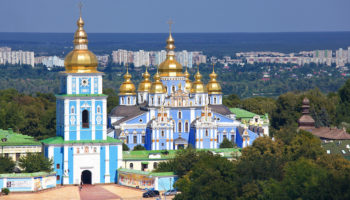
25 Best Places to Visit in Eastern Europe
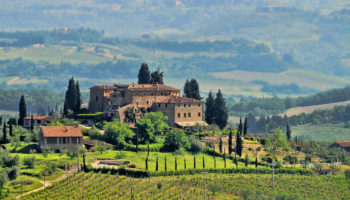
6 Most Beautiful Regions of Europe
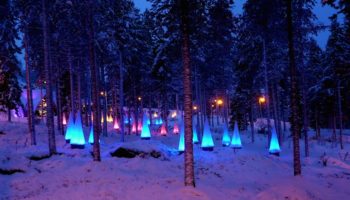
10 Best Places to Visit in Finland
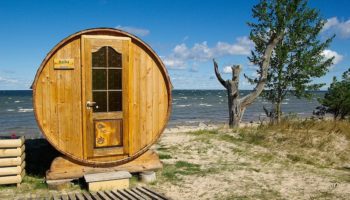
10 Best Places to Visit in Latvia
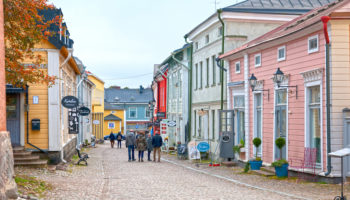
15 Best Cities to Visit in Finland
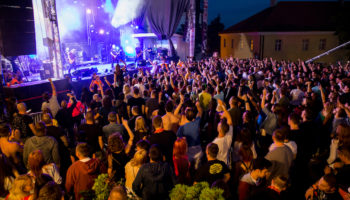
19 Best Things to Do in Serbia
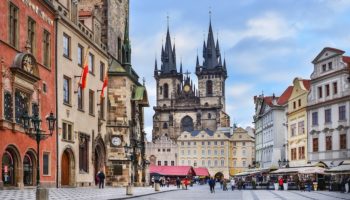
25 Most Photographed Cities in Europe
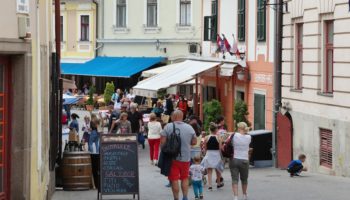
12 Best Cities to Visit in Hungary
Reader interactions, leave a reply cancel reply.
Your email address will not be published. Required fields are marked *
This site uses Akismet to reduce spam. Learn how your comment data is processed .
15 Things to Know Before Visiting Bulgaria
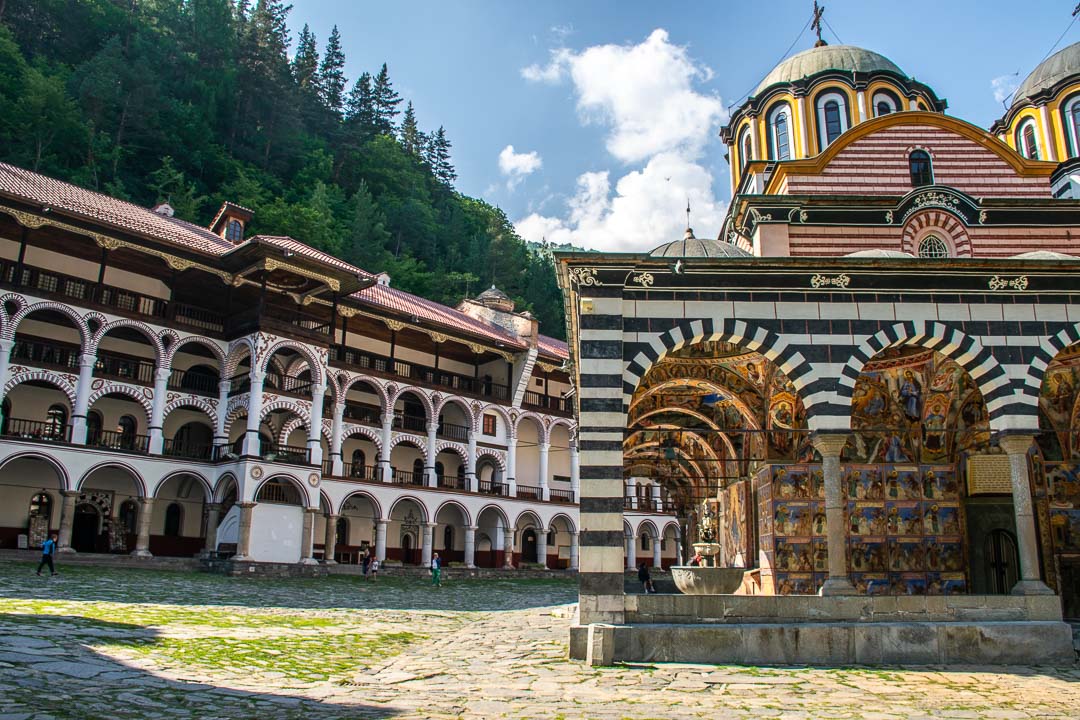
Disclosure: This post (probably) contains affiliate links. If you click on one, I may make a small commission. Of course, this will come at no extra cost to you and helps keep this site running.
If you don’t know what to expect when visiting Bulgaria, you’re not alone. I had no preconceived ideas about the country when I first went and my planning was honestly very limited. At that time, Bulgaria felt like it wasn’t on people’s radar. Visiting more recently, it still feels that way.
Yes, Bulgaria is fairly popular as a seaside destination in summer, but even that’s not on the same scale as its Mediterranean and Adriatic cousins. All this is to say that visiting Bulgaria was eye-opening, as I began to learn more about the history, culture, and people of this extraordinary country.
My return to Bulgaria may not have always gone as planned, but even then it was a joy to further explore this little corner of Europe. For those thinking of travelling to Bulgaria, here is my Bulgaria travel advice with what I think you need to know for your visit.
Table of Contents
1. Look Past Bulgaria’s Coast
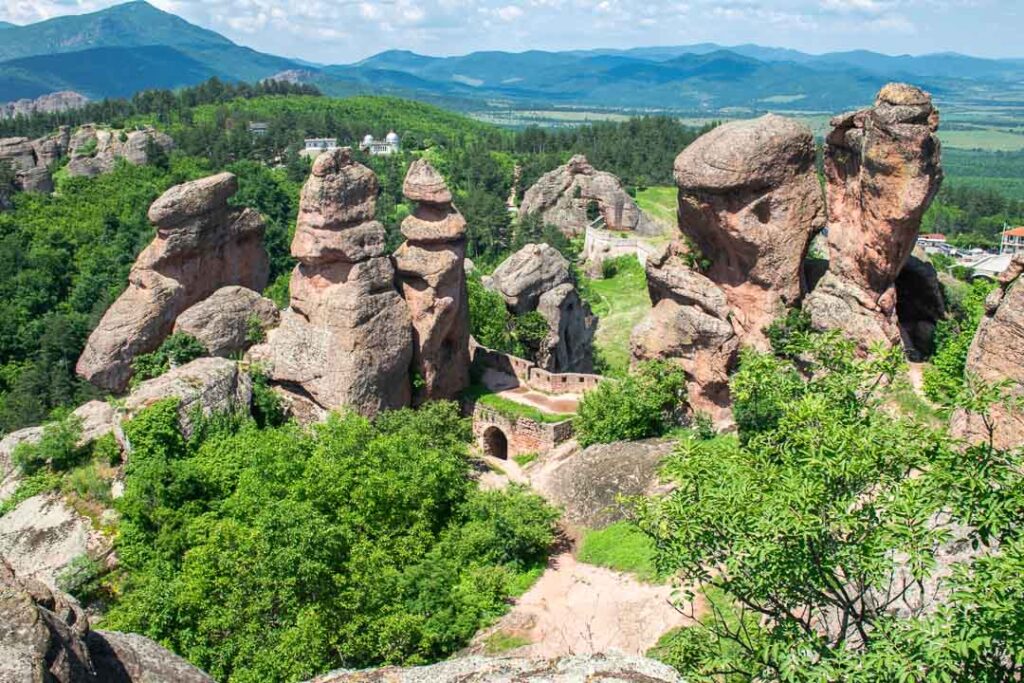
Since Bulgaria’s coast is where the country is most popular with tourists, let’s start there. If you’re seeking an affordable beach vacation, places like Sunny Beach and Sozopol are worth the trip. And the historic port towns on the Black Sea are also worth visiting on their own.
But it pains me that people don’t realise how many other fascinating places there are to visit on a vacation to Bulgaria. The capital Sofia is a good starting point , with its complex history and socialist relics. Look even just a little deeper and you quickly find other cities in Bulgaria to go to, from the immensely cool city of Plovdiv to the former royal capital of Veliko Tarnovo .
Bulgaria’s mountains cover much of the country’s interior and not only are they really fun to explore, they hide lots of great smaller destinations as well. Visiting the Monastery of Dryanovo and the unique Sand Pyramids of Melnik were two highlights of my first visit . Seeing the Rila Monastery and Belogradchik Fortress , two of the most famous Bulgarian attractions, on my return trip was just as memorable.
2. Bulgaria Visa Requirements for Entry
While Bulgaria is part of the European Union, it is not yet part of the Schengen Area that allows free movement between countries, something many EU countries currently benefit from.
This means that when entering Bulgaria you will go through passport control and visa requirements vary. For information on Bulgaria travel requirements , here is one place to start . At the time of writing, travellers from Australia, New Zealand, USA, Canada and most of Europe did not require visas for stays under 90 days.
Crossing the border from Turkey to Bulgaria, our train was stopped and border police came aboard. They collected passports, took them away and then returned them. Don’t be alarmed that people would take off with your passport without saying anything – it is fairly common practice in Eastern Europe and the Balkans.
3. Public Transport in Bulgaria

One of the biggest challenges of travelling in Bulgaria is getting around. The country’s mountains tend to get in the way a lot, especially since so many popular things to do in Bulgaria are found in or near them.
There are also drawbacks to public transport in Bulgaria. I’ve yet to travel by train in Bulgaria, aside from the overnight train from Istanbul, but do not hear good things about its reliability. The travellers I’ve talked to who used it encountered significant delays and were told by locals that they often don’t use it.
Travel by bus has always been my go-to in Bulgaria. An extensive bus network of various companies crisscrosses the country, but Sofia is certainly a major hub. I think the buses are good value, especially for how cheap tickets are, and mostly punctual.
One thing to keep in mind is that most major cities have multiple bus stations, so do check which stations you are departing from and arriving at. Information can be found online at Bgrazpisanie or Balkan Viator , but it always pays to check at the station in case of a rare error.
Once you’ve arrived, most cities and towns have local bus networks that are pretty straightforward to use. When I first went in 2016, buses in most cities still had ticket ladies who sold tickets onboard, often for only 1 lev. That’s certainly not the case now in Sofia. Their metro/bus system lets you just use your bank card, it’s that easy.
4. Best Time to Visit Bulgaria

Timing is everything when you visit pretty much any place in Europe and Bulgaria is no different. Go to Bulgaria in summer and you’re met with hot and humid weather, except for the Black Sea coast. Travel to Bulgaria in winter and the chances of snow are pretty high. Did I mention all of the mountains?
So when is the best time to visit Bulgaria? Well, it depends on why you’re going. If you want beach weather, June through August should give you that. Those just looking to visit Bulgaria’s cities benefit from more flexibility as the shoulder season should work just fine.
You’d think the hiking season would line up with beach weather, but actually most of June isn’t great for hiking as there still may be lots of snow in the mountains. Instead, try visiting between July and September when the mountain trails are clear. As for skiing in Bulgaria, January to March should offer the best conditions to hit the slopes in the mountains.
5. Local Customs to Know
Part of the fun of travel is learning local customs and quirks, but they can definitely lead to confusion at first. The big one for me in Bulgaria is that they nod for No and shake their head for Yes.
Non-verbal communication in a country where you don’t speak the language is super important. English is spoken a little in Bulgaria, mainly with younger people and it is growing. But there are still going to be times where you need to rely a lot on gestures and body language.
That means, simple gestures like nods and head shakes become even more critical. If you ask a bus driver “Bansko?” and they shake their head, I guarantee your first instinct will be to keep looking. I know I did. This will take some time to adjust to during your visit, but I found it always helps to rethink what answer you were given to ensure you understood it properly.
6. Language and Reading Bulgarian
The language of Bulgaria is – you guessed it – Bulgarian . The language is heavily Slavic, but with enough twists to distance it from most other Slavic languages, eg. Czech, Russian, Croatian. It’s not the easiest of languages for English speakers to swiftly pick up.
English is generally spoken in the tourist-heavy parts of the coast, particularly in Sunny Beach, but it’s far from guaranteed. Away from the coast, younger people are the ones more likely to know some English. As for second languages, Russian is definitely the most common across the country, with German probably next.
The other major hurdle for tourists in Bulgaria is that they use the Cyrillic Alphabet . While probably best known for its use in Russia, Cyrillic was actually developed in Bulgaria in the 9th century. That knowledge won’t help you read it any better, but Bulgarians are very proud of that fact.
When trying to read Cyrillic, I tend to sound it out one letter at a time like a little kid. It takes some getting used to, but it helps that the following letters are the same as they are in Latin: ‘ A’, ‘E’, ‘K’, ‘M’, ‘O’, ‘T’ . It’s also useful that the following translates easily: a Cyrillic ‘P’ is Latin ‘R’, ‘C’ is ‘S’, ‘H’ is ‘N’, ‘X’ is ‘H’ . With that little language lesson, you now know the first 4 letters of ‘HOTEL’ in Cyrillic are “XOTE”. Good luck with the rest!
A few basic Bulgarian phrases to help you get by include Dobŭr den which means ‘Good Day’; Blagodarya for ‘Thank you’; Molya te for ‘Please’; and Da and Ne for ‘Yes’ and ‘No’.
7. Managing Your Money

Bulgaria is another Eastern European country where your Euro is not of much use. The national currency of Bulgaria is the Lev (BGN) . Thankfully, the Lev seems to have a fixed rate against the Euro at 2 lev to 1 euro, making the mental currency conversion pretty easy.
For those out on the coast, you may not even need to do your own arithmetic as many signs and restaurants are also shown in Euros or Pounds.
But currency conversion shops are widely found around Bulgaria, especially in places like Sofia and the coast. They mainly exist to convert back and forward between Euros and Lev. While you always want to be wary of the rates you’re getting, my experience in Sofia was surprisingly good.
Now if you’re getting cash out of ATMs, a word of warning. Across the country, you’ll find Euronet ATMS – and I highly recommend not using them . While using my Wise card, I used this guide on ATM fees to avoid extra fees.
While having some cash in Bulgaria is useful, you can use your credit card in Bulgaria for a lot of things. Just make sure it’s a card that doesn’t slam you with currency conversion fees or bad exchange rates.
8. Is Bulgaria Safe to Visit?
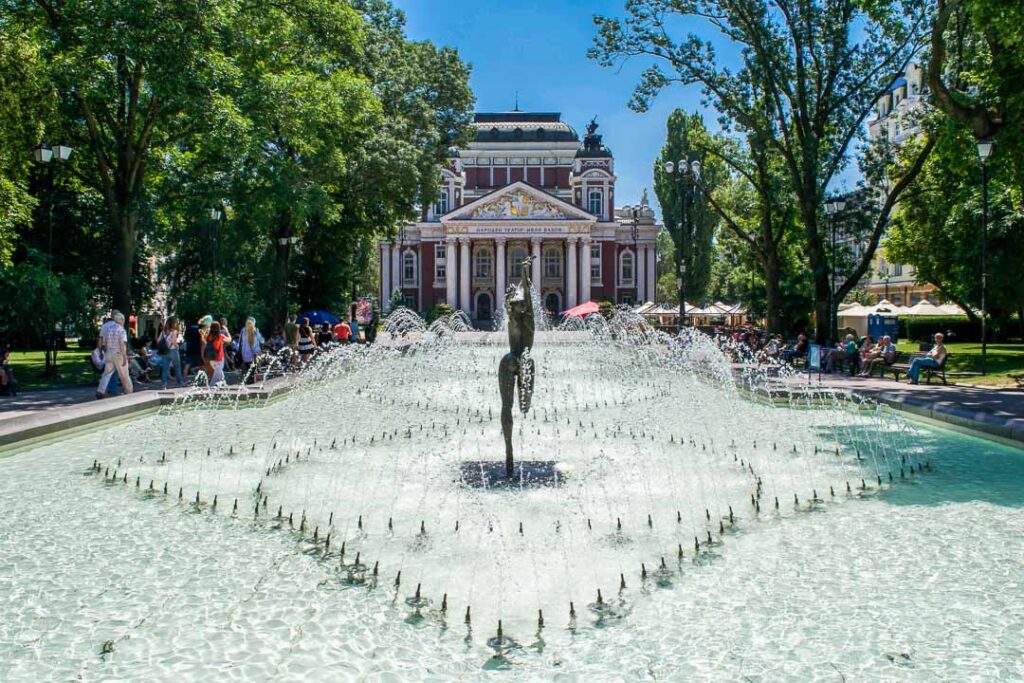
Yes, in my experience, Bulgaria is a safe place to visit. I’ve travelled across the country in public transport and even hitched rides with people and never encountered problems.
The closest I’ve come to feeling unsafe is when a crowd of loud football fans moved through the centre of Sofia after a game, and that can happen anywhere that loves the sport. That said, I don’t tend to go out drinking/partying or be out in the middle of the night, so my exposure to certain risks is lower.
Safety is always going to be a concern for travellers but it’s also deeply specific to individuals. I’m a white male travelling in a European country, so my experience and feeling of safety in Bulgaria doesn’t necessarily mean that all travellers will feel safe. This is true anywhere.
9. Fading Socialist Reminders

One aspect of tourism in Bulgaria that seems to appeal to many international tourists are the remnants of Bulgaria’s era under socialist rule. During the latter half of the 20th century, the country saw a lot of monuments and buildings created in the very Brutalist style that was in vogue under the socialist republic.
The fall of the People’s Republic of Bulgaria in 1990 still wasn’t that long ago so there are plenty of examples around Bulgaria you can still see today. Buzludzha Monument may be the most iconic of these landmarks, but the capital Sofia has more than a few monolithic, Soviet-looking sights of its own.
Visit the Socialist Art Museum in Sofia and you’ll see all sorts of sculptures and statues from this time period. There’s also the popular Communist walking tour , which lets you learn more about the history and how it affected the people of Bulgaria.
Veliko Tarnovo is another city with its fair share of relics from this period. Look no further than the brutalist Interhotel by the river or the incredibly unusual secular church atop Tsarevets Fortress. Further afield, I’ve heard of abandoned bunkers and the like for those who are into urban exploration.
10. So Much History to Explore
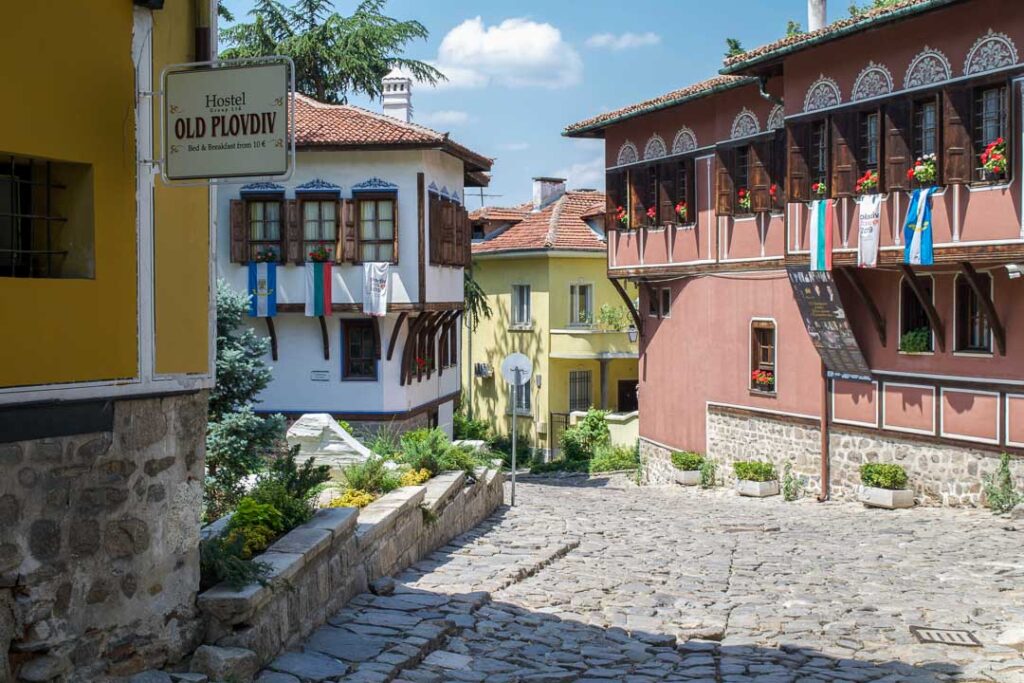
If you said you don’t know the history of Bulgaria, I don’t think anyone would hold it against you. And I’m not just talking about the country’s period of socialism. The good news is that there are plenty of places to visit in Bulgaria that show you the country’s history.
Did you know that you can find Roman ruins in Bulgaria? Plovdiv is home to several ancient Roman landmarks, including a large amphitheatre. Skip ahead and you have landmarks from the middle ages and Bulgaria’s imperial days, such as the Tsarevets fortress in Veliko Tarnovo. There are also plenty of Ottoman landmarks too, many of which are mosques.
Bulgaria’s historical side doesn’t just have to be informative though; it can also be extremely picturesque. From Plovdiv to Veliko Tarnovo and Nesebar, you’ll find gorgeous buildings in the style known as Bulgarian Revival . This architectural style comes from the Bulgarian National Revival movement of the 18th and 19th centuries which also led to Bulgaria regaining autonomy from the Ottoman Empire in 1878.
11. Hiking in Bulgaria

One of my favourite things to do in Bulgaria has been hiking in the mountains there. Now, Bulgaria isn’t one of Europe’s classic hiking destinations, but you’re not going to be disappointed with it if you go.
Most of my hiking in Bulgaria has been around the Rila and Pirin Mountains. But these mountains in the country’s southwest are just two of the main mountain ranges in Bulgaria. You also have the reasonably remote Rhodope Mountains to their east, and the more accessible and extensive Balkan Mountains through the heart of Bulgaria.
Even though it was mostly cold, wet, and foggy for my hiking trip to Bulgaria, I still had a great time. Both when I was meandering around the Pirin Mountains and heading up to the Boyana Waterfall outside Sofia, I loved having the country’s pristine nature practically to myself. I am glad that the weather held up for my Seven Rila Lakes hike though, as the views on that hike are next level.
You have plenty of options for hiking here, both in terms of location, but also whether you want to do a longer hiking trip or just day hikes. For me, I’m still waiting to tackle Musala, the highest mountain peak in Bulgaria.
12. Bulgarian Foods and Drinks
Looking back, I don’t think I’ve been all that adventurous with my food habits when visiting Bulgaria. That’s probably because it’s never hard to find typical Bulgarian restaurants and common Balkan dishes such as kebapche and kufte.
But there are some Bulgarian staples I’ve tried during my visits. Despite their overwhelming volumes of sirene cheese, I’ve had my share of shopska salad and banitsa (pastry filled with cheese). And one of my go-to orders is kavarma , a kind of meat and vegetables served in a clay vessel.
I will admit though I’ve avoided Bulgaria’s famous yoghurt, ayran , simply because I’m lactose intolerant. But if you’re not, don’t skip this popular drink that you can find *everywhere*. Drinks I haven’t shied away from have been Bulgaria’s various beers, Shumensko, Kamenitza, and Pirinsko to name a few.
One thing I only learned about Bulgaria by visiting is that the country is quite a major wine producer. Mavrud, a red wine grape, is probably the best known variety from Bulgaria and is worth trying if you see it on a menu when in Bulgaria. Visit Melnik and you can also explore the town’s fruit wines, which I quite enjoyed.
13. Is Bulgaria Cheap to Visit?
Yes, Bulgaria is an affordable destination to visit and I’d say it’s one of the cheapest countries to travel in across Europe. The Balkans is a generally affordable region for international travellers to visit and I think Bulgaria is somewhere in the middle relative to the rest of the region.
The most expensive places to visit in Bulgaria are going to be the Black Sea Coast and then Sofia. Prices in these places weren’t that high during my first visit to Bulgaria, but accommodation in Sofia was definitely more expensive in 2023. Looking at prices for the coast as well, they also seem to have risen considerably.
Expenses in Bulgaria for things like food, attractions, and public transport are quite reasonable in my opinion. Filling dinners at basic restaurants for one person can comfortably cost 10-15€, while coffee typically only costs 1-2€. Entry to museums and attractions in Sofia typically cost around 5€. Public transport around Sofia for a day cost me less than 3€. A 3-hour bus ride from Sofia to Bansko costs 10€.
14. Is Bulgaria Friendly to Tourists?
As is so often the case with questions like this, it’s hard to say that everyone in Bulgaria is going to be completely friendly to you as a tourist. So many things affect this, from language barriers to perceptions of race/gender/orientation.
Across my Bulgaria travel experiences, I’ve met plenty of welcoming people in the tourism sector (guides, hotel staff, etc.). Then there have been friendly locals like the man that offered to provide suggestions of where to go when I hiked up to Boyana waterfall.
Of course, I’ve also experienced people that have been standoff-ish. And that’s true of most countries I’ve been to in Europe, especially places that are less accustomed to foreign tourists. But in Bulgaria at least, I can’t recall anyone being rude or offensive.
I think if your expectation of “friendliness” is big broad smiles, people greeting you on the street, and endless enthusiasm to help you, you’re going to be disappointed. Basically, don’t expect “American hospitality”.
15. Bulgarian Martenitsa
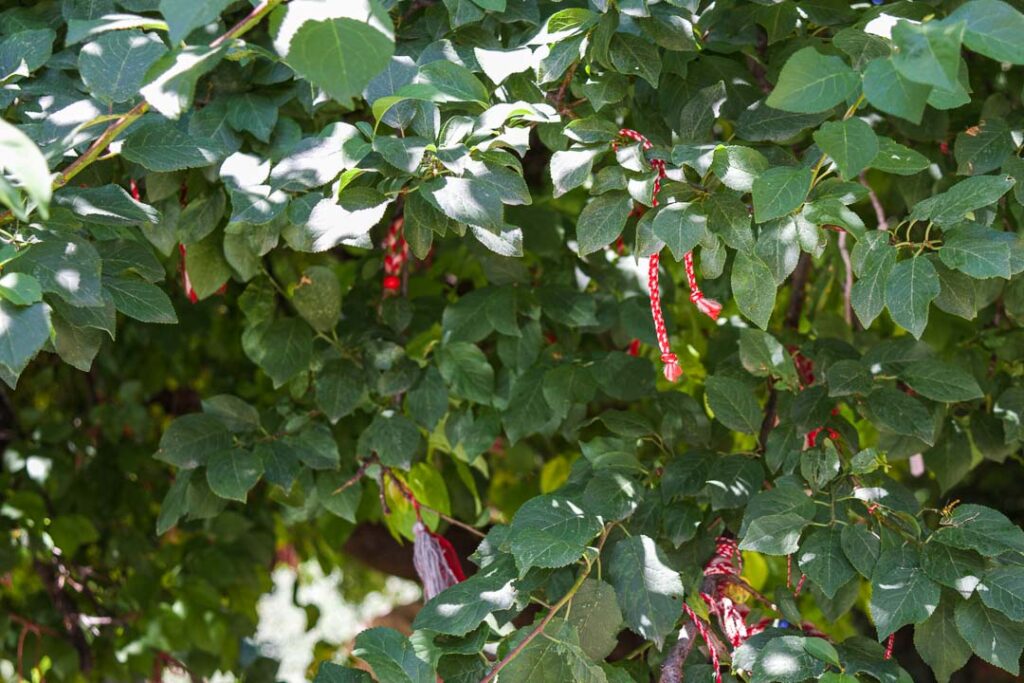
The bracelet’s colours represent vitality and purity, representing a wish for the wearer’s health in the coming year. Locals wear the bracelets until the first sighting of spring blossom, swallows or storks.
At this point, people take the bracelets off and tie them to trees, passing the wishes of vitality onto the tree. During my visit in July, you were still able to find many trees decorated with Martenitsa.
Resources for Visiting Bulgaria
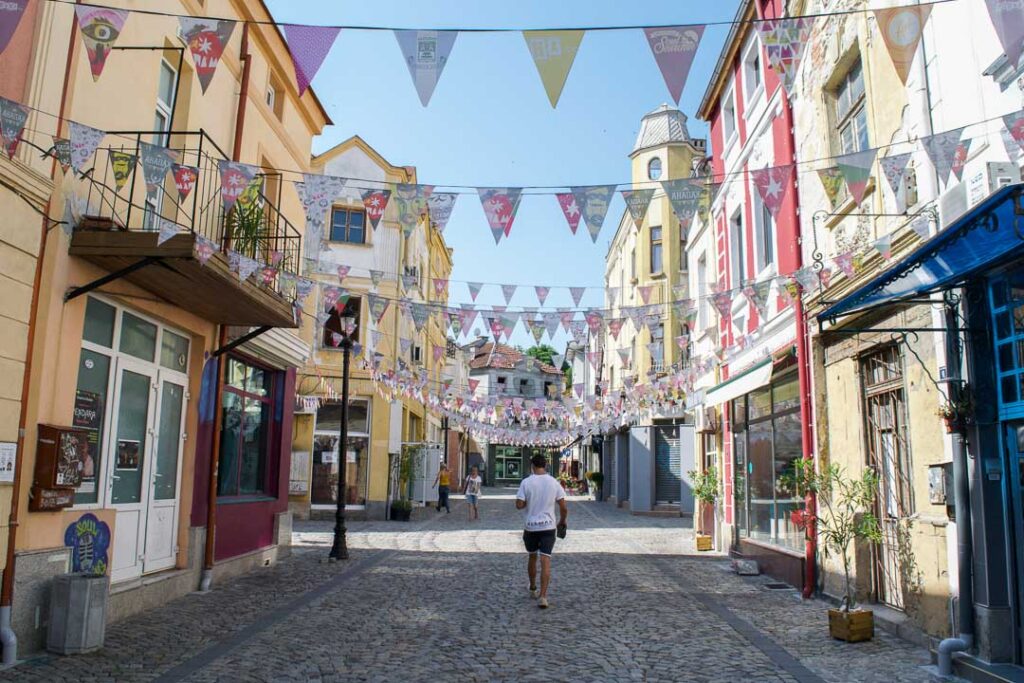
- Getting There: To find the cheapest and most convenient flights to Bulgaria make sure to check Kayak .
- Accommodation: Here you can find hotels, apartments and guesthouses for across Bulgaria, plus don’t forget Airbnb.
- Tours: There are countless day trips, cruises, and sightseeing tours available in Bulgaria.
- Car Hire: If you want to travel more independently, consider renting a car to drive yourself about.
- Guide Books: Lastly, take a Lonely Planet Guide book if want a physical guide.
What other things would you like to know before visiting Bulgaria? Have you visited Bulgaria and have other insights to share? Please share them in the comments below.
David is the author behind the Travelsewhere travel blog and is always on the search for the quieter, less-visited corners of the world.
You may also like
Where to stay on bulgaria’s coast, see the monumental wonders of veliko tarnovo, bulgaria, visiting plovdiv, an ancient city with youthful spirit, hiking to rozhen monastery from melnik, bulgaria, 21 photos to inspire your first bulgaria trip, the southern border crossing to north macedonia, 23 comments.
This was definitely helpful! We had our big honeymoon planned for Italy at the moment but at 80% sure that we are going to cancel it and do a huge 2 week road trip through the Balkans hitting up Montenegro, Macedonia, Bulgaria and Romania mostly. Keep an eye out because I might be contacting you for recommendations, if you don’t mind! 🙂 I’ve already used your blog for a lot of info!
Glad to hear it Lorelei! I’m such a big fan of the Balkans so more than happy to help if you have questions or need recommendations. Have a great time!
Thank you! I’m just getting started on research so I’ll hit you up if/when I have questions. 🙂
Don’t miss out on Albania if you are doing a Balkan road trip. IMO the most interesting country to visit in the Balkans.
Don’t worry, we WILL visit one day, most likely as it’s own trip! I’m dying to visit!
great tips! I might use them one day:) #wanderfulwednesday
That nodding/shaking your head means the opposite from what we understand of it is definitely new to me! I’ll have to keep that in mind if I ever get to visit Bulgaria. I certainly don’t understand or speak Russian, let alone Bulgarian… 😉
Martenitsa sounds like a lovely custom. Enjoyed reading about it.
Unfortunately in Norway Bulgaria is synonym with party people, so I’ve never wanted to go. Know I should see beyond 🙂
These are great tips. The only thing I really know about Bulgaria is where to locate it on a map. I eventually would like to visit but it’s not high on my list. #wkendtravelinspiration
Haha that’s ok Allison, that’s probably more than many people can. I totally understand the perils of having a long list of places you want to visit. I hope you reach that far down the list one day 🙂
Great tidbits of information! I’ll definitely remember that nodding means no and that shaking your head is yes…wowzers! Bulgaria is on my radar since I’m living in Moscow now. 😀
The former eastern block countries fascinate me. I hope to visit Bulgaria and Romania someday.
We did a great road trip in Bulgaria, and although the roads are not the best, we had a fabulous time. We did see the bracelets on many trees in the church yards. Good article.
I know a few people from Bulgaria and friends who visited really enjoyed it for the culture and low prices compared with other parts of europe. nice reminder of what it’s worth visiting the less touristy parts of the world. #wkendtravelinspiration
Like you, I have no preconceived ideas about Bulgaria. It was good to learn more from you about this country. I am nodding my head, or am I shaking it 🙂
One of the things that intrigues me most in Bulgaria and other former Soviet Bloc countries is the Communist remnants. Particularly architecture and public works. Amazing in their own way, and still historically important. Also, that Bulgarian Revival architecture is great! Looks like another country we’d enjoy just wandering through and admiring! As always, great post!
Stay away from the coast. Party time is not educational.
I think you can still enjoy the coast if you don’t like partying. I know I did.
Bulgaria has become really popular for skiing, if you are a fan of winter sports, Pomporovo or Bansko in the winter will rock your expectations!
This was a very interesting and informative article but let me tell you this . I am Bulgarian myself . I was born and raised in Varna and then later in my life moved to Canada. There is a lot of misinformation floating out there such as the ” shake your head for NO and nod for YES” Simply not true unless they do that in some small high mountain village somewhere there it is absolutely NOT TRUE the rest of the country. Anyhow useful article never the less. Enjoy and happy travels everyone.
Thanks for commenting Ivo. That’s interesting to hear, perhaps it’s a regional thing. I definitely experienced it first hand in the west and know other people who experienced it as well
Visiting Bulgaria in the Winter can be really a great journey. I can say Borovets is one of the most popular destinations for this.
Leave a Reply Cancel reply
This site uses Akismet to reduce spam. Learn how your comment data is processed .
Nomadic Matt's Travel Site
Travel Better, Cheaper, Longer
Bulgaria Travel Guide
Last Updated: August 30, 2023
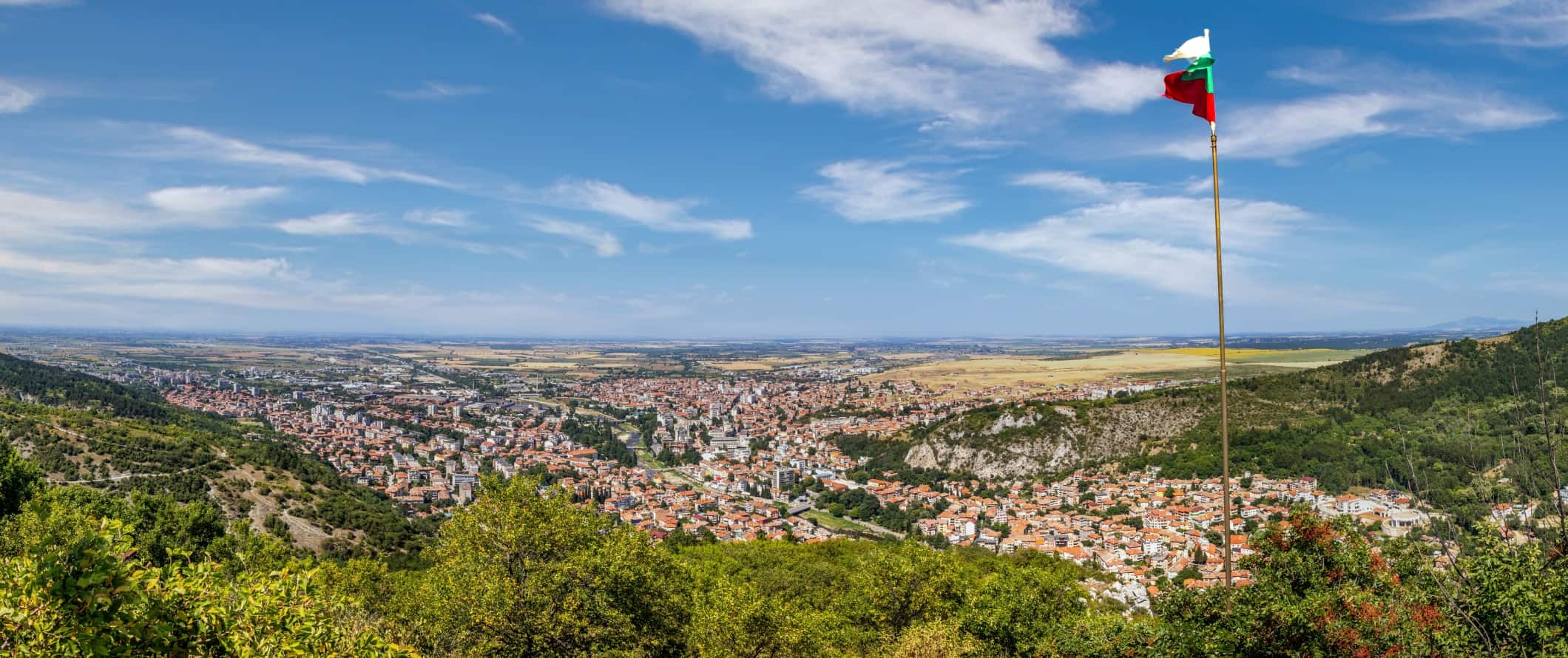
Often overlooked by travelers, Bulgaria is actually one of my favorite countries in Europe .
Because it’s under the radar, here you’ll find few crowds and plenty of affordable activities. I arrived with few expectations and was blown away by the country’s affordability, incredible history, mountainous landscapes, Black Sea beaches, and wild nightlife.
Bulgaria’s long history is evident everywhere, from ancient Neolithic settlements to mysterious Thracian tombs to fortresses left behind by powerful tsars. Even some of the smallest, most nondescript churches have elaborate religious artwork inside, including paintings of saints and vivid murals.
And, if you’re a nature lover, there are several mountain ranges throughout the country offering all kinds of stunning hikes.
In short, Bulgaria is amazing and I can’t speak its praises enough. Don’t speed through the place. There’s a lot to see and do here.
This travel guide to Bulgaria can help you plan your trip, save money, and make the most of your time here.
Table of Contents
- Things to See and Do
- Typical Costs
- Suggested Budget
- Money-Saving Tips
- Where to Stay
- How to Get Around
- How to Stay Safe
- Best Places to Book Your Trip
- Related Blogs on Bulgaria
Click Here for City Guides
Top 5 things to see and do in bulgaria.
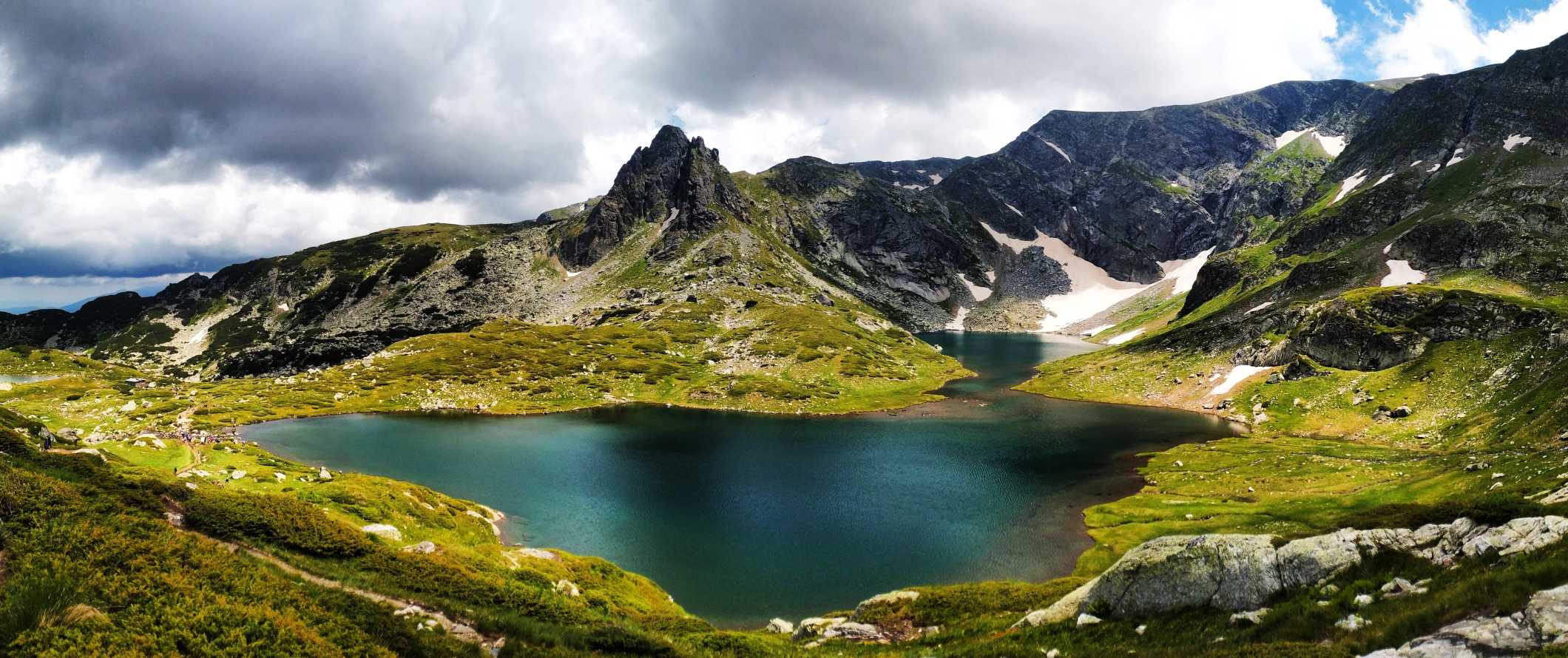
1. Explore Sofia
Sofia is Bulgaria’s dynamic capital city full of museums, Eastern Orthodox churches, communist architecture, and trendy galleries, restaurants, and clubs. The city has thousands of years’ worth of history and dates to the 8th century BCE when it was inhabited by the Serdi tribe. One of the oldest buildings is a brick rotunda that was built in the 4th century by the Romans. It was originally used as a bath but later became a church – and it’s survived almost completely intact. Don’t miss the Alexander Nevski Cathedral, built in the 1880s in the Neo-Byzantine style. It’s massive and has enough room for 10,000 people inside (you can even explore the crypt which is full of unique religious icons). Museums like the National Art Gallery, the National Historical Museum, and the National Institute of Archeology are all worth a visit and feature unique cultural and historical exhibits.
2. Relax in Varna
Varna is a major tourist destination during the summer when its beaches fill up with visitors. Like most of Bulgaria, the area has a rich history. Archeological remains of early settlements have been uncovered at over 30 sites, the oldest of which dates back to the Stone Age. Modern Varna was established in the 6th and 7th centuries when the Slavic people gained power in the Balkans, and the city emerged as an important hub for trade due to its prominent location on the Black Sea. Now it’s known as one of Bulgaria’s most popular seaside resort towns thanks to its beautiful beaches. I had a lot of fun wandering the streets, visiting the Roman Baths, walking through the big central park, and relaxing by the beach. Make sure to check out Aladzha Monastery, which is one of the oldest in Bulgaria (it dates back to the 4th century) and offers stunning views of the city.
3. Visit Plovdiv
Plovdiv is the second-largest city in Bulgaria and is the oldest continuously inhabited city in Europe (archeologists have discovered evidence of settlements dating back to the Neolithic period in 6,000 BCE). Over the years, Plovdiv has been ruled by Greeks, Romans, Celts, Huns, Slavs, Bulgars, Thracians, and Ottomans. You can explore ruins spanning the centuries on a walk-through Old Town with cobblestone streets and architecture from the Middle Ages and the Bulgarian Revival. The city is the cultural hub of Bulgaria and was named the European Capital of Culture and is part of the UNESCO Global Network of Learning Cities. Be sure to visit the Roman Amphitheater, see the Archaeological Museum, and relax under the leafy trees in the Tsar Simeon Central Garden.
4. Go to Veliko Tarnovo
Once the capital of the Bulgarian Empire, Veliko Tarnovo is now a charming university town. Much of the city is perched on the cliffs with white houses and iconic red roofs spanning the hillsides. For excellent photo opportunities visit the Sky Walk which overlooks the city and the river winding through the cliffs. Not much happens here, but I loved the cobblestone streets, the historic castle ruins, the little cafes, and the nearby mountain hikes. Like any university town, there are some eclectic spots to grab a drink like the Hipster Art Bar which has a fun atmosphere and is a great place to meet people.
5. Explore the Rila Mountains
The Rila Mountains are the highest mountain range in the Balkans, with Mount Musala towering over 3,000 meters (10,000 feet). Most of the mountain is protected within Rila National Park and the rest falls within the Rila Monastery Nature preserve, so it’s a hotspot for biodiversity and nature enthusiasts. You can trek to the top on a day hike or take on some of the less challenging hikes in the mountains. During the colder months, the Rila Mountains become packed with skiers, and if you want to treat yourself there are some luxurious spas around the area. Other highlights include the Seven Lakes route, Skakavitsa Waterfall, and the Rila Monastery. The monastery is the largest in Bulgaria and was established in the 10th century by Saint John of Rila. It’s also a UNESCO World Heritage Site.
Other Things to See and Do in Bulgaria
1. check out the museum of socialist art.
This museum in Sofia showcases art from when the country was under Communist rule (1944-1989). A large outdoor sculpture park contains everything from a giant statue of Lenin that once stood in the center of the city to the red star that topped the socialist party headquarters. Inside you’ll find all kinds of propaganda, documentary videos, photos, and more. Admission is 6 BGN.
2. Hike the Balkan Mountains
This mountain chain is at the center of Bulgaria. It’s part of the epic European Long Distance Route (E3) following the chain’s main ridge to the Portuguese seaside, spanning a distance of 6,950 kilometers (4,320 miles). For shorter day hikes, find a base town like Apriltsi and trek from there. The Mount Botev summit and the hike to Vodnite Dupki are two popular hikes.
3. Hit the beaches on the Black Sea
This 402-kilometer (250-mile) stretch of Bulgarian coast lies along the Black Sea. About one-third of this coastline is covered in pristine, sandy beaches. Avoid Sunny Beach (it’s tacky and crowded) and check out some of the quieter beaches instead, like Pomorie Beach or Sinemorets Veleka Beach.
4. Unwind in Balchik
Balchik is a small coastal town on the Black Sea. The area used to serve as the summer residence for Queen Marie of Romania (1875-1938). You can tour her Balchik Palace on the seaside promenade and admire the interesting blend of Gothic and Islamic architecture. There are not very many rooms, but they all contain original furnishings and paintings by Queen Marie herself. There’s also a botanical garden with over 600 species of plants. Admission is 15 BGN.
5 Go skiing
Bansko, Borovets, and Pamporovo are the three biggest resort towns in Bulgaria. Most people prefer Bansko because its resort has the longest ski runs and it’s doable as a day trip from Sofia. There are several hotels and budget accommodations within Bansko (although Bansko isn’t the prettiest of towns). A one-day ski pass is 90 BGN in Bansko and 85 BGN in Borovets and Pamporovo.
6. Stop and smell the roses in Kazanlak
Bulgaria is one of the biggest producers of rose oil in the world and the town of Kazanlak has hosted the Festival of Roses since 1903. During the first weekend of June, the local community organizes this international event that attracts thousands of tourists. There are rose-picking rituals, events to learn about the rose distillation process, a street procession, acapella choirs, folklore concerts, art shows, exhibitions, and even wine-tasting. Best of all, most of the events are free!
7. Visit the Varna Archaeological Museum
The Varna Archaeological Museum is home to the Varna Necropolis, a prehistoric archaeological site that contains the oldest processed gold in the world (it’s 7,000 years old). The gold was extracted from 62 graves (it was custom to bury people with gifts at that time). On display, you’ll also find intricate jewelry and other artifacts, as well as oddities like Roman surgical tools and ancient Hellenistic headstones. Admission is 10 BGN.
8. Explore Stara Zagora
Stara Zagora is a smaller city located in the south of Bulgaria, famous for its annual linden-tree bloom (the whole city smells incredibly floral — like a combination of honeysuckle and jasmine). For me, the main attraction is Stara Zagora’s historical significance. Other than once being an important crossroad for the Romans, Ottomans, and Thracians, Stara Zagora also contains some amazing prehistoric relics, including ancient burial mounds dating back 8,000 years. The Neolithic Dwellings Museum sits on one of these prehistoric mounds, along with the remains of a home. It’s 5 BGN to visit and super informative!
9. Tour the Bachkovo Monastery
Just outside of Plovdiv is the Bachkovo Monastery, dating to 1083 (although most of it was built from the 17th century). The main attraction in the monastery is the Church of Sveta Bogoroditsa, which has an interior completely covered in colorful frescoes painted by Zahari Zograf in 1850. The refectory (dining hall) is also full of murals displaying the building’s history. Pilgrims often come to the church to pray in front of the Madonna, which is encased in gold and silver. It’s free to visit the monastery, but the onsite museum costs 2 BGN and the refectory is 6 BGN.
10. Visit the Etâr Ethnographic Open-Air Museum
The Etâr 19th-century ethno-village in Northern Bulgaria is a recreated Bulgarian town lined with cobblestone streets and dozens of traditional shops and workshops devoted to cobblers, furriers (someone who works with furs), glass workers, jewelers, leatherworkers, potters, bakers, and more. Costumed performers move between buildings, making it feel like you stepped back in time (or at least onto a movie set). You can poke around recreated traditional homes, and some of the workshops are still powered by running water. It’s a bit cheesy, but you can pick up neat handmade souvenirs here. Admission is 5 BGN.
11. Hike at Emen Canyon
If you’re visiting Veliko Târnovo, head west to Emen Canyon. Carved out by the Negovanka River between tall limestone cliffs, the canyon is home to deep creeks (perfect for swimming) and picturesque waterfalls. A two-hour hike on the Negovanka Ecotrail takes you along 90-meter-high (295-foot) bluffs, leading to viewpoints over the canyon and a 10-meter-tall (32-foot) waterfall. It’s a beautiful region to explore on foot!
For more information on specific cities in Bulgaria, check out these guides:
- Plovdiv Travel Guide
- Sofia Travel Guide
- Varna Travel Guide
- Veliko Tarnovo Travel Guide
Bulgaria Travel Costs
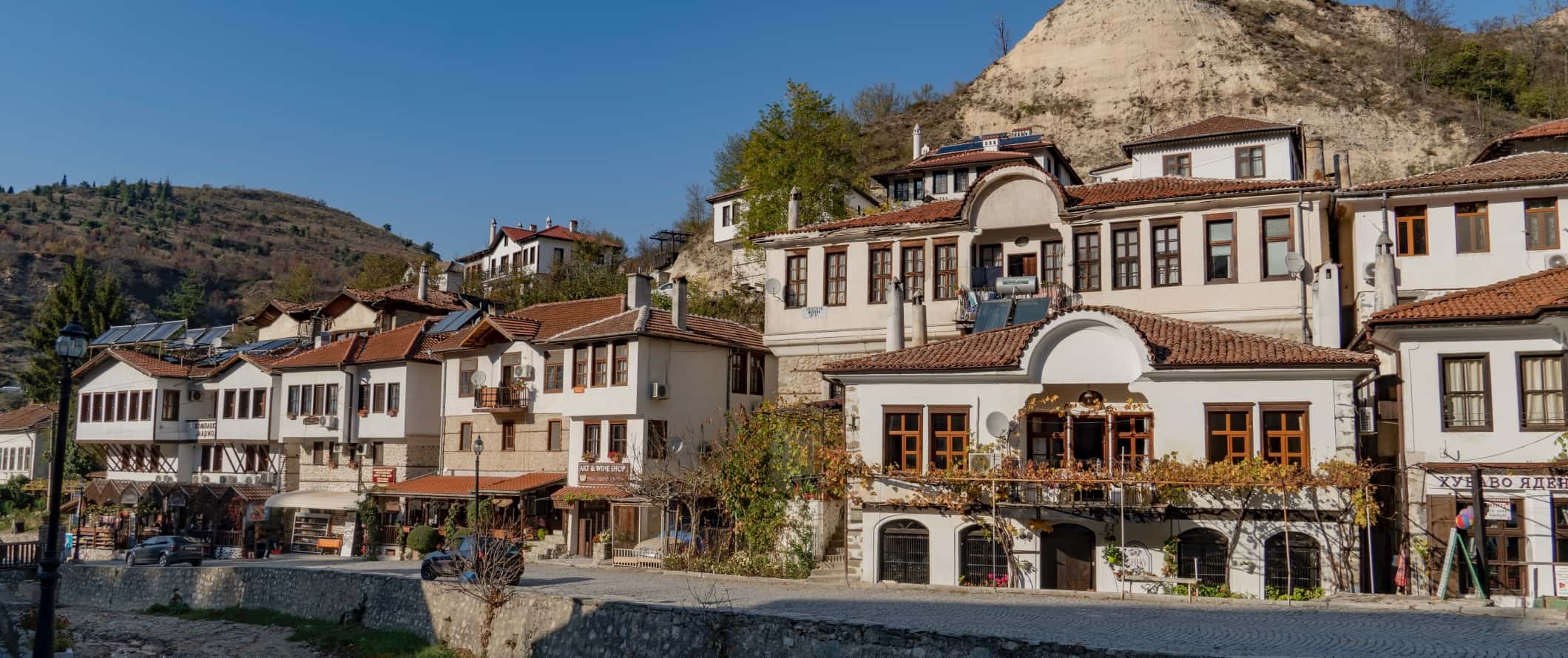
Accommodation – Hostel dorms with 5-8 beds cost between 15-25 BGN per night. Private hostel rooms cost 30-60 BGN per night. Free Wi-Fi is standard and most hostels also include self-catering facilities.
Budget two-star hotels range from 50-100 BGN per night. If you want to stay at one of the resort areas on the Black Sea, expect to pay double that amount during the summer.
Airbnb is available across Bulgaria, with private rooms ranging from 20-55 BGN per night. An entire home/apartment costs around 60-110 BGN.
For those traveling with a tent, there are also well-maintained campgrounds around the country, especially along the coast. Most tent sites start at 5-20 BGN per night for a basic pitch without electricity.
Food – Bulgarian cuisine is hearty and similar to that of its Balkan neighbors. Meaty stews with lamb, goat, or chicken are common, as are sausages and all kinds of yogurts (dairy products are big here). Popular dishes include kebapche (grilled mincemeat), shopska salad (a salad with tomato, cucumber, and cheese; similar to Greek salad), and moussaka.
Overall, food is very affordable throughout Bulgaria. Local street food eats like banica (cheese pastry) are as little as 1.50 BGN. You can pick up a hearty shopska or kebab for about 6 BGN.
For fast food (think McDonald’s), you can get a combo meal for about 12 BGN. A casual meal at a restaurant serving traditional cuisine costs around 14 BGN. A large pizza also costs around 10 BGN.
If you want to splash out, a three-course meal with a drink costs around 30 BGN.
Beer is 4 BGN while a latte/cappuccino is 3.50 BGN. Bottled water is around 1.50 BGN.
Grocery shopping is very cheap here, costing about 45-65 BGN per week for basic staples like rice, pasta, seasonal produce, and some meat.
Backpacking Bulgaria Suggested Budgets
If you’re backpacking Bulgaria, expect to spend about 55 BGN per day. On this budget, you’ll be staying in a hostel dorm, cooking most of your meals, limiting your drinking, taking public transportation to get around, and sticking to mostly free activities like hiking and going to the beaches. If you plan on drinking, add 5-10 BGN to your daily budget.
On a mid-range budget of 135 BGN per day, you can stay in a private Airbnb, eat out for most meals at cheap fast food joints, have a couple of drinks, take the occasional taxi to get around, and do more activities and tours like visiting museums or going skiing.
On a “luxury” budget of 200 BGN per day or more, you can stay in a hotel, eat out for all your meals, drink more, rent a car or take more taxis, and do whatever tours and activities you want. This is just the ground floor for luxury though. The sky is the limit!
You can use the chart below to get some idea of how much you need to budget daily, depending on your travel style. Keep in mind these are daily averages — some days you’ll spend more, some days you’ll spend less (you might spend less every day). We just want to give you a general idea of how to make your budget. Prices are in BGN.
Bulgaria Travel Guide: Money-Saving Tips
Bulgaria is one of the most affordable destinations in Europe. You can do a lot on a tight budget here as most of the country’s attractions (such as museums and historical sites) are cheap. You’ll find it hard to break the bank here unless you’re spending your time on the Black Sea coast during peak season and intentionally trying to splurge. Here are some ways to save money in Bulgaria:
- Avoid Sunny Beach – I don’t understand the appeal of a beach that’s overpriced and crowded with tourists. Hit up one of the other coastal beaches instead.
- Stay at Hostel Mostel – Staying at this hostel chain can lower your costs because they include free breakfast and free dinner. They have locations in Sofia and Veliko Tarnovo .
- Eat at the bakeries – Bakeries in Bulgaria have an inexpensive range of sweet and savory pastries that can fill you up. Two of my favorite snacks there are banica and krenvirshka.
- Stay with a local – If you plan ahead, you can usually find Couchsurfing hosts all throughout the country. This way, you not only have a free place to stay but you’ll connect with a local host that can share their insider tips and advice.
- Take free walking tours – Walking tours are a great way to get familiar with a city and its culture. Sofia, Veliko Tarnovo, and Plovdiv all have free walking tours. Just be sure to tip your tour guide at the end.
- Enjoy free events – Many of Bulgaria’s festivals are free to attend, and during the summer many city parks have free scheduled events and concerts. Ask your hostel or host what’s going on during your visit.
- Bring a water bottle – The tap water here is safe to drink so bring a reusable water bottle to save money and reduce your plastic use. LifeStraw is my go-to brand as their bottles have built-in filters to ensure your water is always clean and safe.
Where to Stay in Bulgaria
Bulgaria has lots of fun, affordable hostels around the country. Here are my favorite and suggested places to stay:
- Hostel Mostel (Sofia)
- Hostel 123 (Sofia)
- Hostel Mostel (Veliko Tarnovo)
- Hostel Old Plovdiv (Plovdiv)
- Yo-Ho-Hostel (Varna)
- Nomado Hostel (Varna)
How to Get Around Bulgaria
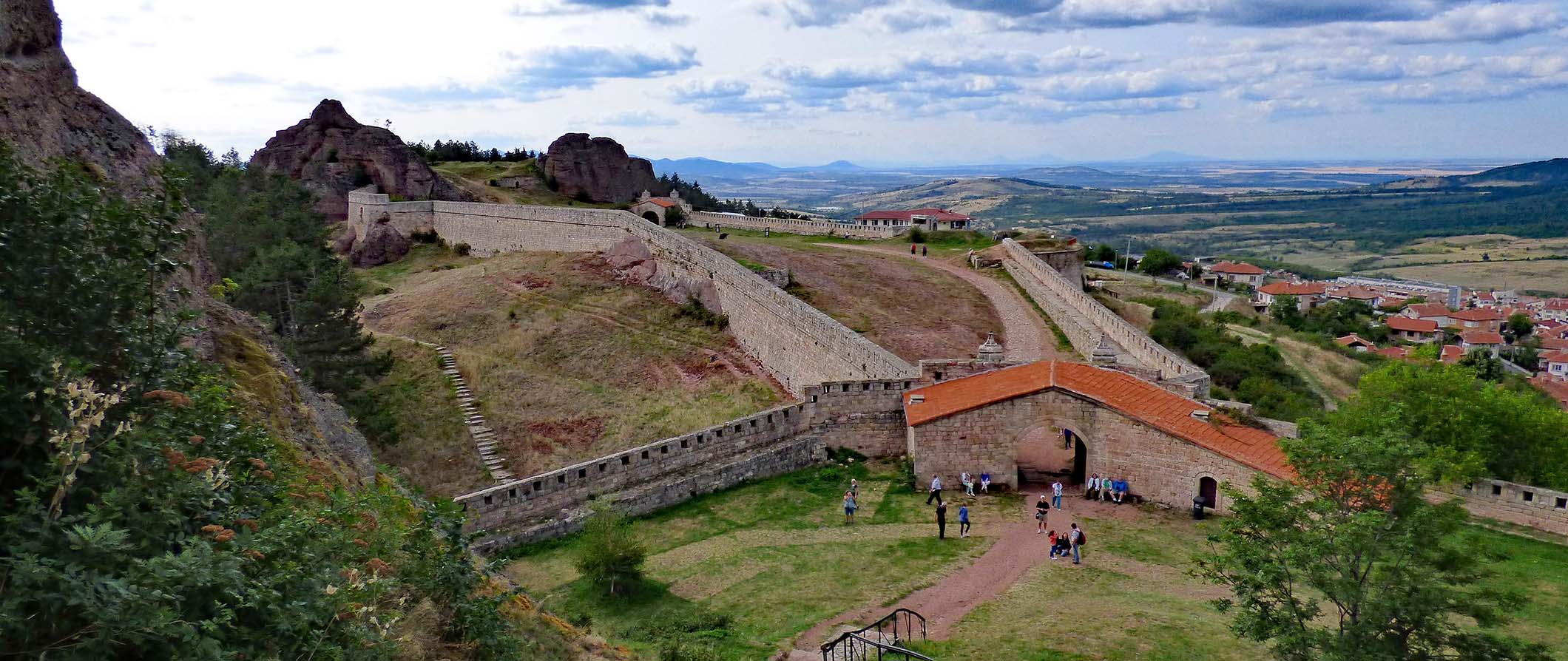
Public transportation – Public transportation in Bulgaria is very affordable. Sofia has a subway with two lines connecting the city center and the airport, as well as the central bus and train stations. Tickets are 1.60 BGN each.
In other cities, public buses are the most common mode of public transportation. Fares are usually between 1-2 BGN. Trolleybuses and trams are also common and generally cost the same.
Some cities, like Sofia, have a daily transportation pass for 4 BGN per day. A three-day pass is 10 BGN.
Taxi – Taxis are readily available everywhere, with rates starting at 2 BGN, costing an additional 1-2 BGN per kilometer. Always make sure your driver uses the meter so you avoid getting ripped off. Ridesharing like Uber is not available here.
Bus – Bulgaria has lots of private and public minibusses and coaches to get you between the smaller towns and cities. A bus from Sofia to Varna costs around 33 BGN and takes seven hours, while Varna to Plovdiv is 27 BGN and also takes seven hours. A three-hour journey from Sofia to Veliko Tarnovo shouldn’t cost more than 30 BGN.
Train – Train travel in Bulgaria is often cheaper than taking the bus, but it’s a lot slower. For example, the same Sofia to Veliko Tarnovo journey costs just 20 BGN but takes a little over four and a half hours by train (instead of three by bus). You can use the Bulgarian State Railways website (bdz.bg) to plan your trip.
Flying – There are limited domestic routes around Bulgaria, making this an inconvenient option for most travelers. That said, flying is affordable here. A one-way trip between Sofia and Varna costs about 160 BGN, while a one-way trip between Sofia and Burgas is about 106 BGN. Unless you’re pressed for time, though, I’d stick to the bus.
Car rental – Car rentals are super affordable here, costing as little as 25 BGN per day. If you have someone to share the ride with, this could be an affordable and flexible way to get around the country. Drivers need to be 21 years old and have an IDP (International Driving Permit).
To find the best car rental prices, use Discover Cars .
When to Go to Bulgaria
If you want hot weather and lots of time on the Black Sea coast, summer (June-August) is the best time to visit. Temperatures average 29-32°C (84-90°F) and the water is ideal for swimming. These temperatures are fairly consistent across the country, although the mountain regions can be cooler.
Spring and fall weather can change from day to day. Temperatures range between 5-21°C (41-70°F) in the spring and the weather can be quite foggy and cloudy, with not a lot of sunshine. But if you want fewer crowds and lower prices, this is the best time to come.
The fall months (September-October) are best for hiking as the autumn foliage is starting to show. Fall temperatures range from 2-21°C (36-71°F).
Winter can be frigid, with temperatures dropping as low as -5°C (23°F). The snow-capped mountains are beautiful during this time, and many people come here to hit the slopes. If you’re not coming here to ski or do winter sports, however, I’d skip a winter visit.
How to Stay Safe in Bulgaria
Bulgaria is a very safe country to visit. Violent crime against visitors is very rare. Scams and petty crime like pick-pocketing are the most common danger you’ll face when you’re traveling the country, but even those are rare.
That said, it’s always a good idea to keep your valuables secure and out of sight when out and about.
Solo female travelers should generally feel safe here, however, the standard precautions apply (never leave your drink unattended at the bar, never walk home alone intoxicated, etc.).
When taking taxis, always make sure the meter is on. A common scam is for taxi drivers to tell you that their meter is broken. Insist that you want a taxi with a working meter or negotiate the cost upfront.
You can read about common travel scams to avoid right here.
If you experience an emergency, dial 112 for assistance.
The most important piece of advice I can offer is to purchase good travel insurance. Travel insurance will protect you against illness, injury, theft, and cancellations. It’s comprehensive protection in case anything goes wrong. I never go on a trip without it as I’ve had to use it many times in the past.
Bulgaria Travel Guide: The Best Booking Resources
These are my favorite companies to use when I travel. They consistently have the best deals, offer world-class customer service and great value, and overall, are better than their competitors. They are the companies I use the most and are always the starting point in my search for travel deals.
- Skyscanner – Skyscanner is my favorite flight search engine. They search small websites and budget airlines that larger search sites tend to miss. They are hands down the number one place to start.
- Hostelworld – This is the best hostel accommodation site out there with the largest inventory, best search interface, and widest availability.
- Booking.com – The best all around booking site that constantly provides the cheapest and lowest rates. They have the widest selection of budget accommodation. In all my tests, they’ve always had the cheapest rates out of all the booking websites.
- HostelPass – This new card gives you up to 20% off hostels throughout Europe. It’s a great way to save money. They’re constantly adding new hostels too. I’ve always wanted something like this and glad it finallt exists.
- Get Your Guide – Get Your Guide is a huge online marketplace for tours and excursions. They have tons of tour options available in cities all around the world, including everything from cooking classes, walking tours, street art lessons, and more!
- The Man in Seat 61 – This website is the ultimate guide to train travel anywhere in the world. They have the most comprehensive information on routes, times, prices, and train conditions. If you are planning a long train journey or some epic train trip, consult this site.
- Rome2Rio – This website allows you to see how to get from point A to point B the best and cheapest way possible. It will give you all the bus, train, plane, or boat routes that can get you there as well as how much they cost.
- FlixBus – Flixbus has routes between 20 European countries with prices starting as low 5 EUR! Their buses include WiFi, electrical outlets, a free checked bag.
- SafetyWing – Safety Wing offers convenient and affordable plans tailored to digital nomads and long-term travelers. They have cheap monthly plans, great customer service, and an easy-to-use claims process that makes it perfect for those on the road.
- LifeStraw – My go-to company for reusable water bottles with built-in filters so you can ensure your drinking water is always clean and safe.
- Unbound Merino – They make lightweight, durable, easy-to-clean travel clothing.
- Top Travel Credit Cards – Points are the best way to cut down travel expenses. Here’s my favorite point earning credit cards so you can get free travel!
Bulgaria Travel Guide: Related Articles
Want more info? Check out all the articles I’ve written on backpacking/traveling Europe and continue planning your trip:

The Perfect 7-Day Croatia Itinerary

The 6 Best Hotels in Copenhagen

The 6 Best Hotels in Florence

The 7 Best Hotels in Madrid

The 6 Best Hotels in Vienna

The Best Walking Tours in Barcelona
Get my best stuff sent straight to you, pin it on pinterest.
- Where To Stay
- Transportation
- Booking Resources
- Related Blogs

12 Unique and Fun Things to do in Bulgaria (That You Probably Didn’t Know About)
Last Updated: February 16, 2022
*FYI - this post may contain affiliate links, which means we earn a commission at no extra cost to you if you purchase from them. Also, as an Amazon Associate I earn from qualifying purchases. Check out our Privacy Policy and Disclosure. for more info.
I’ll be honest with you: this list of fun things to do in Bulgaria was written begrudgingly.
Not because I don’t adore Bulgaria, or because there’s a shortage of things to lovingly dote on. Rather, it’s the opposite. Bulgaria is so great, I want to selfishly keep it as a my own travel secret.

Save this list of fun things to do in Bulgaria for later!
You’ll be very glad you did.
Let’s rewind a bit.
My love affair with this underrated Balkan powerhouse began over a year ago, when I first flounced from Sofia to Varna, discovering that Bulgaria was a country with not just limitless beauty by the bucketload, but incessant calories to keep energy (and weight gain) sky high.
And as I would soon discover, Bulgaria is unique.
Not only is it packed with peculiar, mindblowing, almost alien-like sights, it’s packed to the brim with photogenic gems that (in any other part of the world) would command literal mobs of Instagramming zombies.
Honestly, when it comes to the cool and offbeat, Bulgaria is the reigning king.
If there’s one thing you should take away from this post, it’s this: GO TO BULGARIA. JUST DO IT.
You’ll gain fifty pounds and contract “insufferable Bulgari-osis” which is a disease I just made up.
Symptoms include an incessant yapping about your Bulgaria trip and being terrible at parties, but it’s okay. *whispers* it’s all for Bulgaria.
Yikes. I’m starting to sound too much like a propaganda poster, so let’s jump right into the good stuff.
Tell me in the comments: what are some other amazing places to see in Bulgaria? I’ve tried my best to sum up the best of Bulgaria in this post, but after only two visits, I’m sure I’ve missed more gems! Feel free to share below 🙂
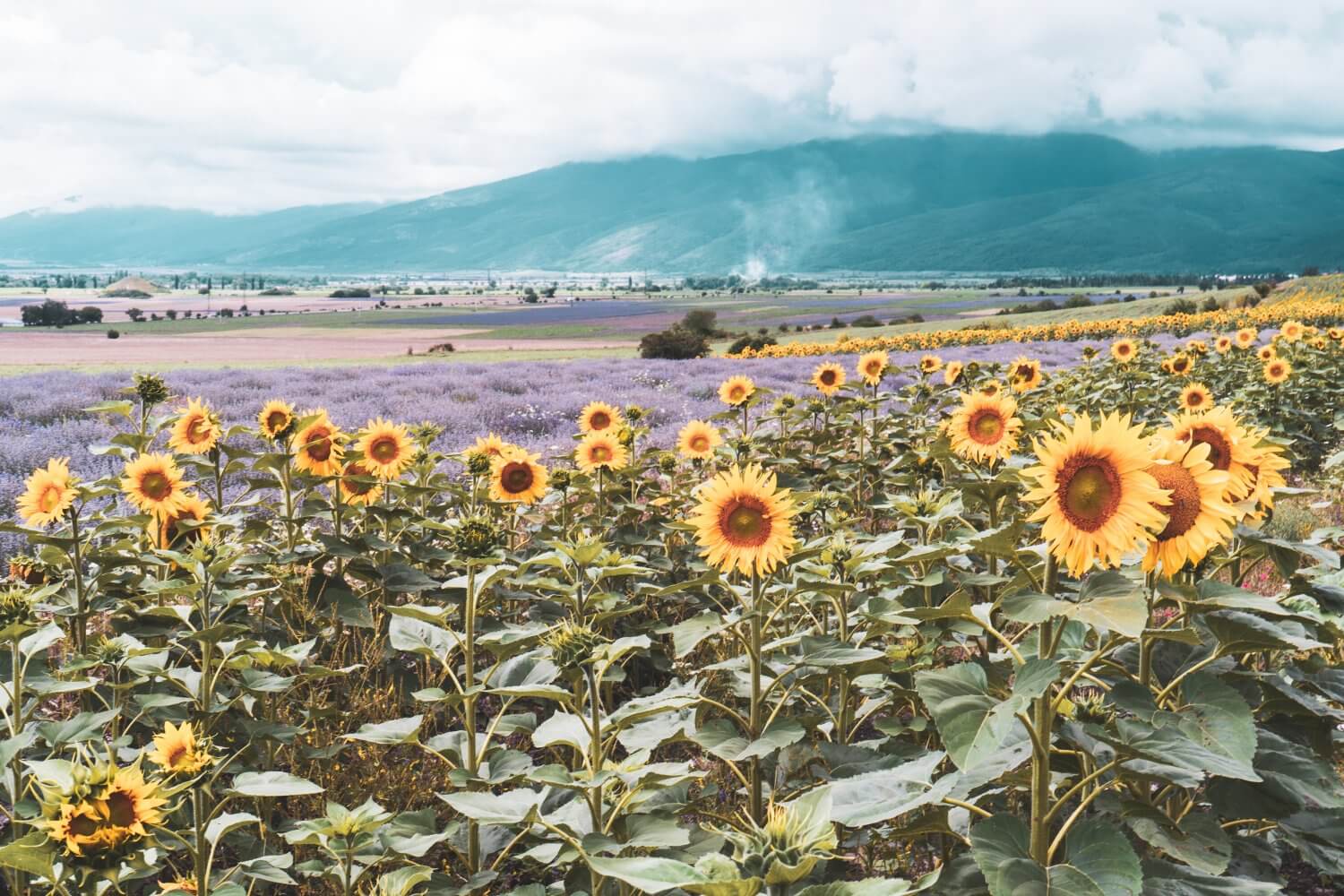
Unique Things to do in Bulgaria that will Make You Go “Whaaat?!”
If I sound a tad fanatical, it’s for good reason.
Take a shot of rakia and indulge me for a few minutes as you scroll through this list. I promise you’ll become a believer quicker than I can inhale a block of Bulgarian white cheese (which is fast, by the way).
PS: There are SO many interesting places to see in Bulgaria, I would probably be publishing a full-on encyclopaedia if I included them all. Instead, I’ve had to choose my favourites, and here they are.
Without further ado, if you’re wondering where to go in Bulgaria and what to do, here are some things that you can’t miss:
1. Explore the ruins of an abandoned UFO
Built as a communist meeting place in the 1970s, Bulgaria’s Buzludzha monument is an abandoned relic that sits ominously on a peak in the Stara Zagora province.
Nicknamed Bulgaria’s “UFO”, its imposing concrete structure and sporadic bouts of dense, white fog will make you feel like you’ve teleported to an eerie sci-fi movie.
As you navigate the hairpin turns that beam you up to this real-life flying saucer, you quickly start to feel like you’re travelling to the ends of the Earth.
Once upon a time, actually breaking into Buzludzha was one of the favourite things to do in Bulgaria for eager backpackers and modern Indiana Joneses.
These days, doing so is virtually impossible thanks to a security guard (who clearly hates his job a lot, but that’s another story). I’ve visited during both my Bulgaria trips and it has always been a highlight.
While the most exciting way is to rent a car and explore for yourself, you can easily book tours that take you there (especially through local hostels). If you prefer to book online in advance, click here for a tour!
RANDOM TIP: Don’t miss the stone monument that sits just below Buzludzha – it’s two massive fists holding up torches and looks really cool.

2. Frolic through incredible lavender & sunflower fields
We all know that lavender and sunflower fields are Instagram’s summertime crack.
That is, if you haven’t completely OD’d from cherry blossoms, tulips and wisteria.
But hey, if you are still alive and don’t have enough pics for #ThrowbackThursday, Bulgaria’s got you, boo.
Unlike flower field hotspots like Provence and Tuscany, the masses are still blissfully unaware of Bulgaria’s absolutely stunning flower fields which over large portions of the country, meaning (seemingly) endless stretches of sunflowers and fragrant purple lavender.
This is why if you’re coming in the summer, one of the best things to do in Bulgaria is rent a car and go field hunting.
Yes, you’ll even find fields where lavender and sunflowers are planted side by side… no Photoshop. (The photos below were taken near Kazanlak, though we saw tons of gorgeous fields while driving from there to Varna too!)
I mean, out of all the beautiful places in Bulgaria, these fields top the list in terms of sheer photogenic wonder 😉
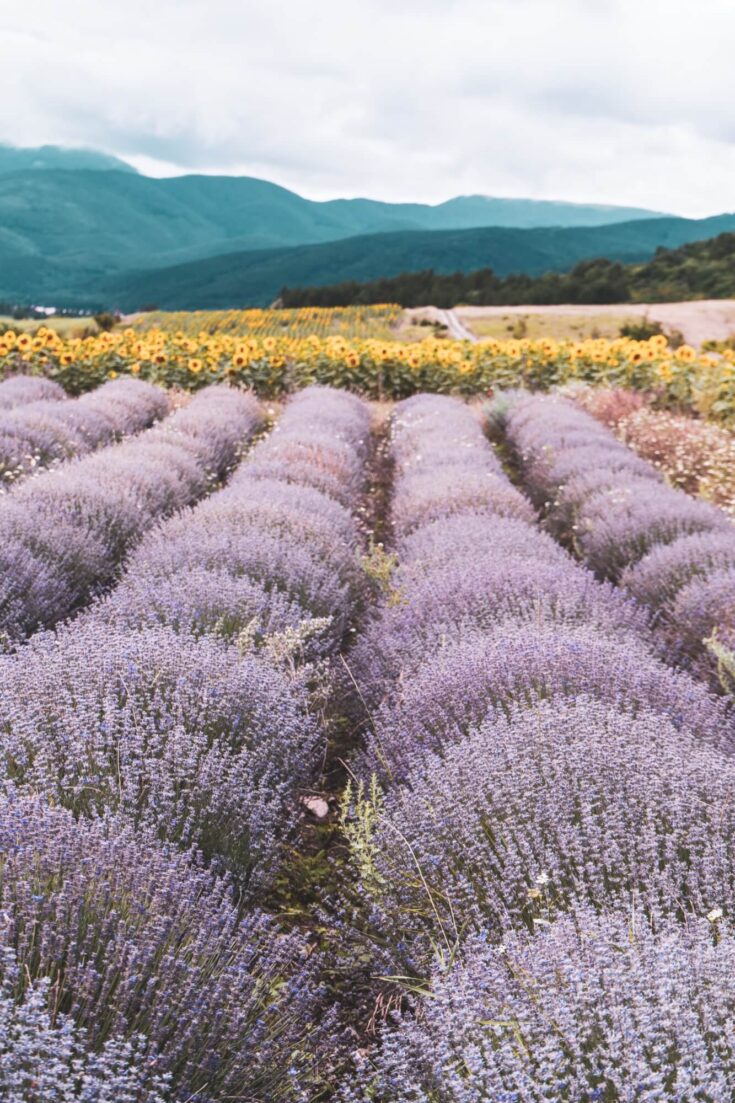
3. Check out Roman ruins at an H&M
I know, weird to think right? H&M – the usual safe haven of dirt cheap basics and bird shirts, home to Roman ruins? I feel like that’s one of those “only in Bulgaria” moments.
You can observe this super cool sight in Plovdiv, one of the top cities in Bulgaria for culture lovers and tourists. Plovdiv is the second biggest city in the country, and one of the oldest in all of Europe (some say it’s the oldest continually inhabited city in the entire continent).
Over the years, Plovdiv has therefore picked up a wide array of visually fascinating features, including Roman ruins, Bulgarian revival buildings and a modern hipster touch with cool cafes and bars.
Because of its status as one of the most historical places in Bulgaria, Plovdiv is one of the European capitals of culture for 2019, which I think clearly means one thing: that H&M is about to get REAL busy.
4. Soak in a pink lake
While compiling your list of what to visit in Bulgaria, I bet a pink lake wasn’t on that list… well, surprise! Bulgaria has its very own Pepto Bismol bath, AKA Lake Atanasovsko in Burgas.
Of course, like many things in Bulgaria, it beats the competition thanks to its sheer off-the-radar-ness, which means it’s one of the few pink lakes you can actually still swim in.
Slather yourself in rejuvenating mud like a local, or simply lurk like a walrus in the murky pink waters… like a local.
Downside: it’s not too easy to find. Click here for a detailed guide on how to find the pinkness for yourself. Serious Bulgaria travel goals.
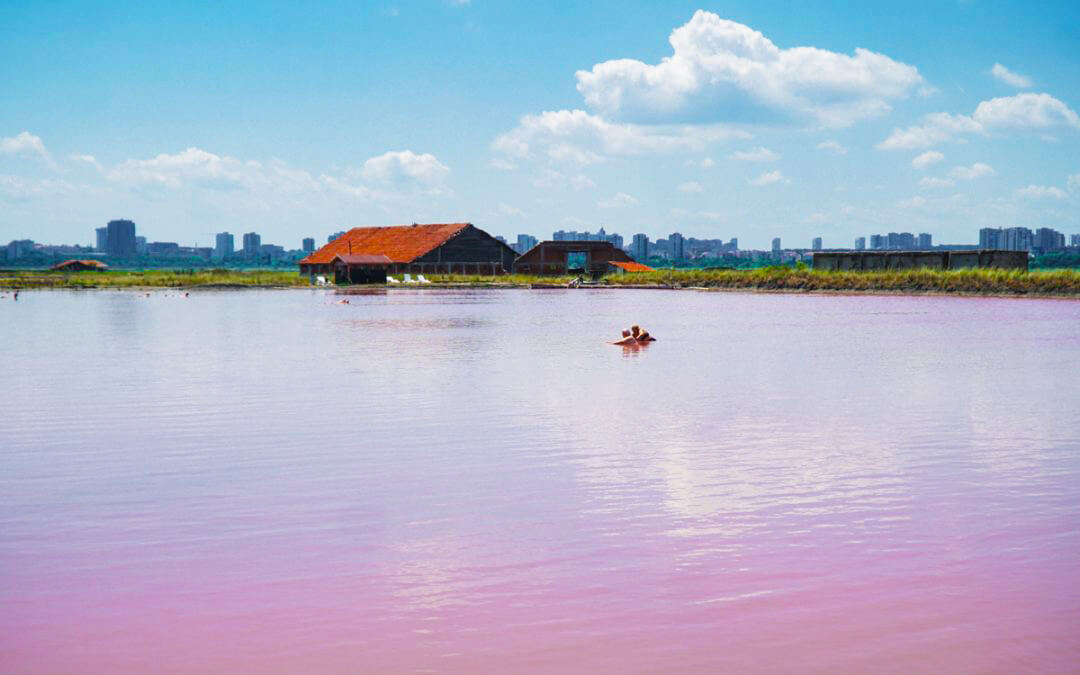
5. Take a dip in a free seaside infinity pool
Bulgaria’s Black Sea coast is one of THE preferred “wellness” getaway destinations in the Balkans, thanks to all its mineral water springs (and rock bottom prices compared to other wellness hotspots in Europe).
But guess what’s better than “affordable”? FREE!! And in Varna, the free public pool at “ Toplata voda ” offers up a warm, sulphur-rich bath all for the tidy price of zero dollars.
I was tipped off about this place by a backpacking friend who heard about it from her Couchsurfing host who heard about it from who-knows-who.
It’s very much a local spot, and you will get a lot of weird looks for coming here, but hey, it’s a free sulphur hot spring set right along the Black Sea, so I think you can deal with the odd looks. To find it, just type “Toplata voda” into Google Maps.
Will you be sharing with a bunch of mostly-nude Balkan men? Probably, but consider it a cultural experience.
Besides that, Varna is just one of the best cities in Bulgaria for a tourist. It’s definitely one of the top Bulgaria vacation spots for locals too. Click here to browse some of the awesome tours/activities you can do there.
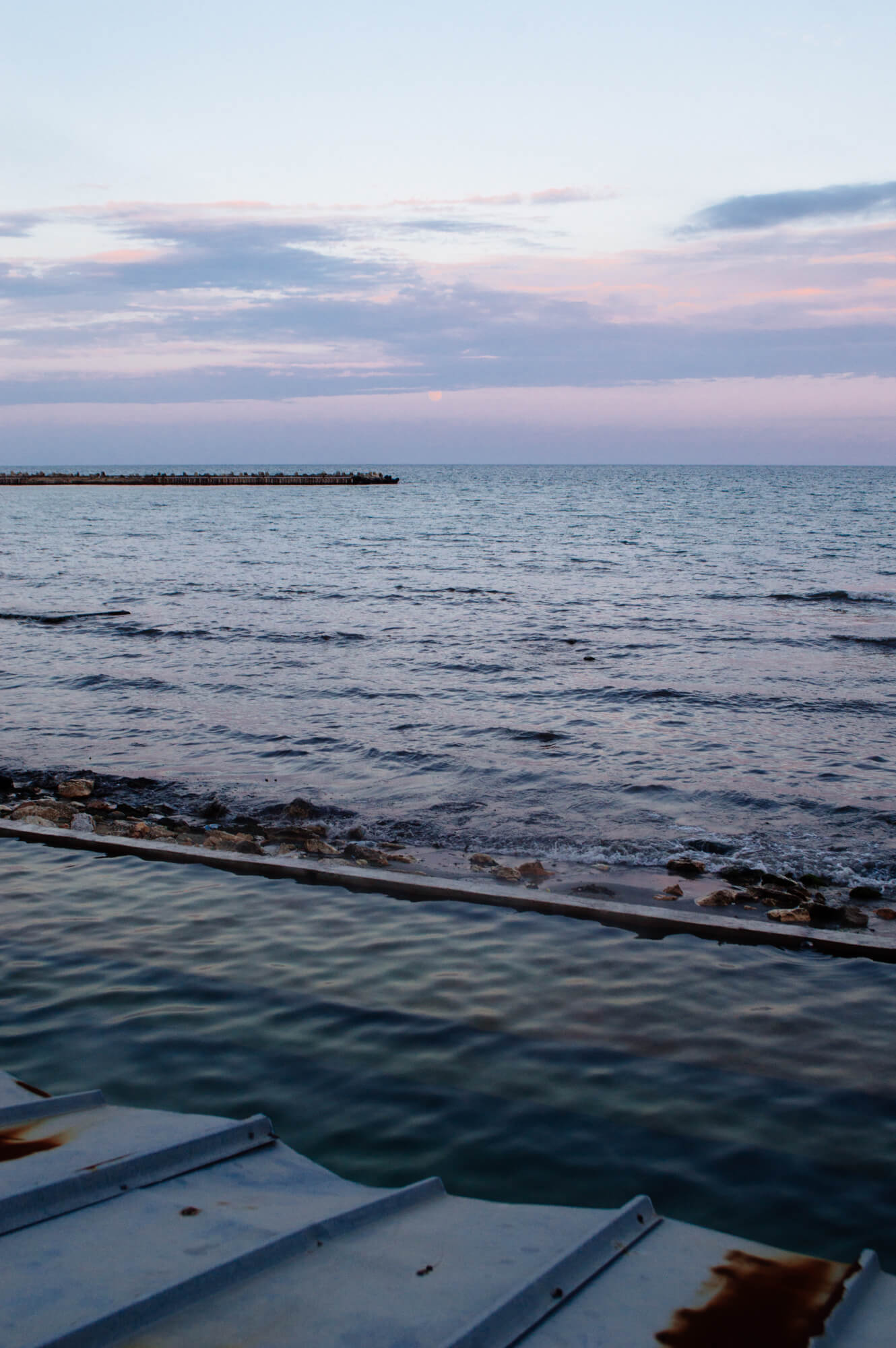
6. Visit Barbie’s dream Church
Of all the Bulgaria tourist places I stumbled across on my recent trip, the Shipka Memorial Church might just be my favourite.
Between the 53m church tower, the glittering gold domes and of course, the pretty pink colours, I might even say it’s one of the most beautiful places in Bulgaria.
Built in memory of the soldiers who died to liberate Bulgaria in the Russo-Turkish War, this dreamy church boasts a must-see exterior (with a surprisingly humble interior) and is a definite must-see when you visit Bulgaria.
7. Drink in a candle lit barn, drink in an apartment-themed bar, drink in a speakeasy hidden behind a secret door, drink in a…
Okay, so Bulgaria nightlife – let’s talk about it.
You just can’t go to Bulgaria without enjoying a drink or fifty, you know what I’m saying?
It therefore makes sense that one of THE things to do in Bulgaria is enjoy the cool nightlife.
So, when you visit Bulgaria, specifically Sofia, make time for some bar hopping. On my recent trip, I was lucky enough to have Allison from Eternal Arrival show me around her favourite places for a quick booze, and boy did she deliver. From The Apartment (ul. Neofit Rilski 68), a hipster bar that’s pretty much a walk-in house party to Hambara Bar (ul. 6-ti septemvri 2), a fully candle-lit barn tucked in the sketchiest alley, I was blown away by all the cool spots Sofia had to offer.
And if you don’t have a boozed up friend to show you around, you can also book lots of great bar crawls that take you to more offbeat spots. Here’s one you can book online for less than 15 euros, including some drinks & a guide.
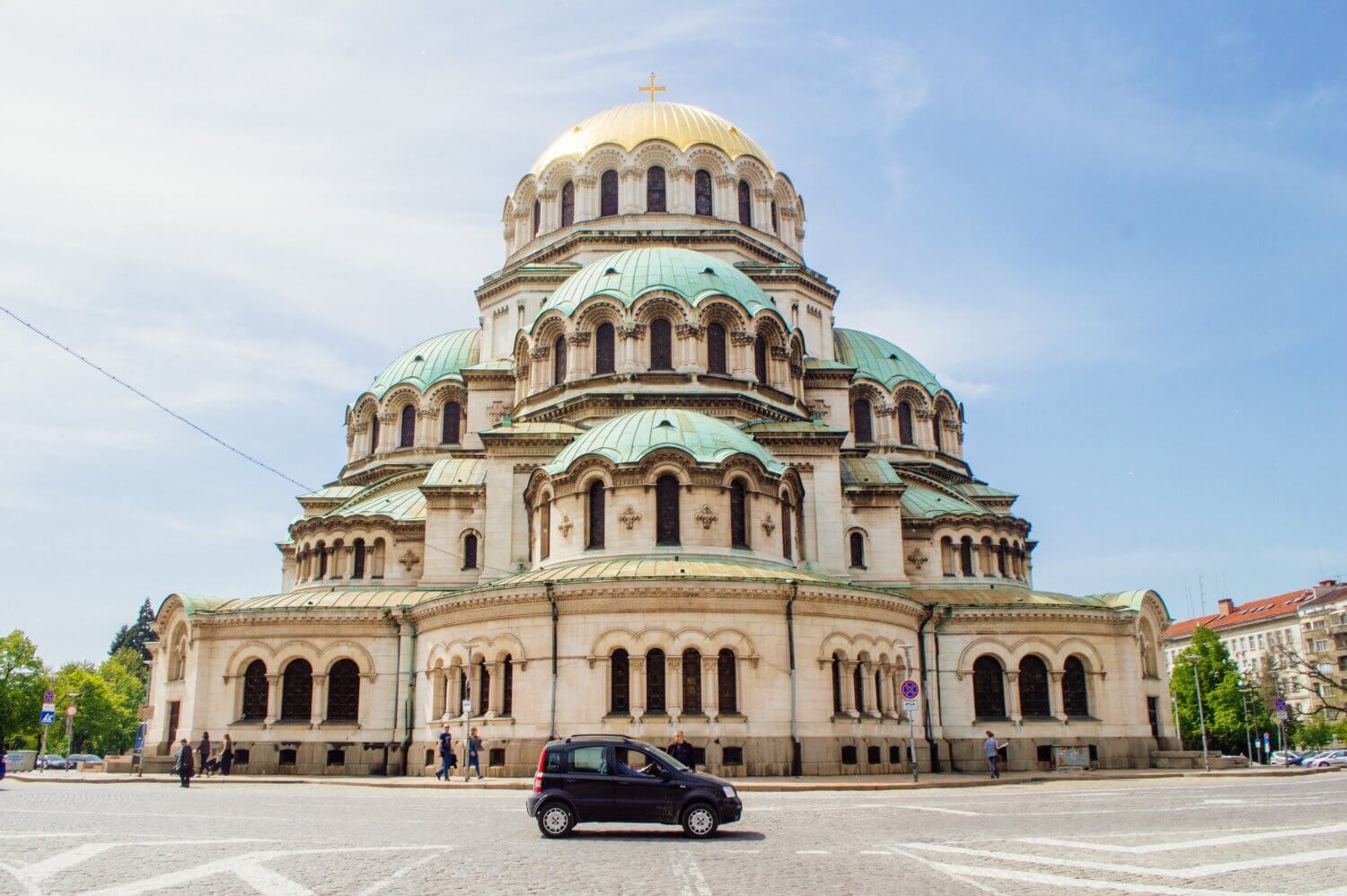
8. Stuff yourself on one of the world’s only FREE food tours
Okay, so while this one isn’t specifically about a destination, we’re already chatting about Sofia so I need a quick moment to gush about ALL THE FREE TOURS you can take in the city.
While most major cities will have a regular free tour that shows you the highlights, Sofia has free tours for sights, Communist history, street art, and yes, even food!
This abundance of free tours is naturally what makes Sofia (for me) one of the best cities in Bulgaria.
But let’s talk about the food tour, because naturally, one of the best things to do in Bulgaria is eat.
Free walking tours may be commonplace across Europe, but food tours? Not so much!
I highly recommend doing a Balkan Bites food tour while you’re in Sofia because you get the chance to sample lots of great local food, all for free (though obviously, tipping your guide is expected).
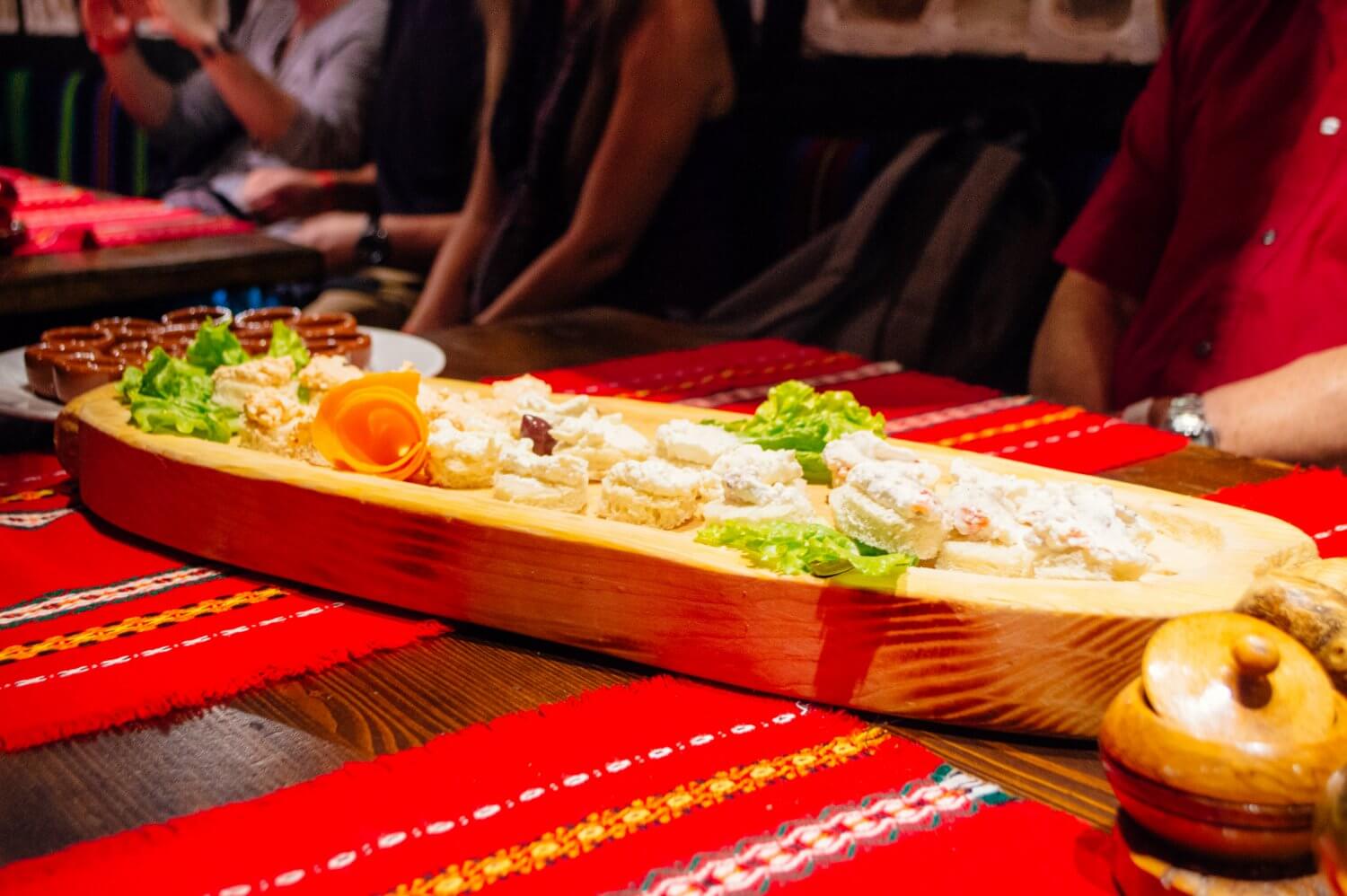
9. Ponder innuendos in a forest of phallic symbolism
I almost omitted Varna’s Stone Forest from this list, but quickly realized that would have been a dick move.
….. Ayyyyyy!
If my immature jokes haven’t made it clear already, Varna’s stone forest has a lot of um… phallic-y structures. Known as “ Pobiti kamani ” in Bulgarian, this forest is a short drive from Varna’s city center and consists predominantly of large limestone columns that take on a variety of ‘fun’ shapes.
While it’s not the most exciting attraction in the world (unless you’re a hardcore geology nerd), it’s just kind of a weird marvel of nature that’s cool because of its randomness and mysterious vibe… like Stonehenge but more penis-y, you know?
A worthwhile excursion from Varna for sure.
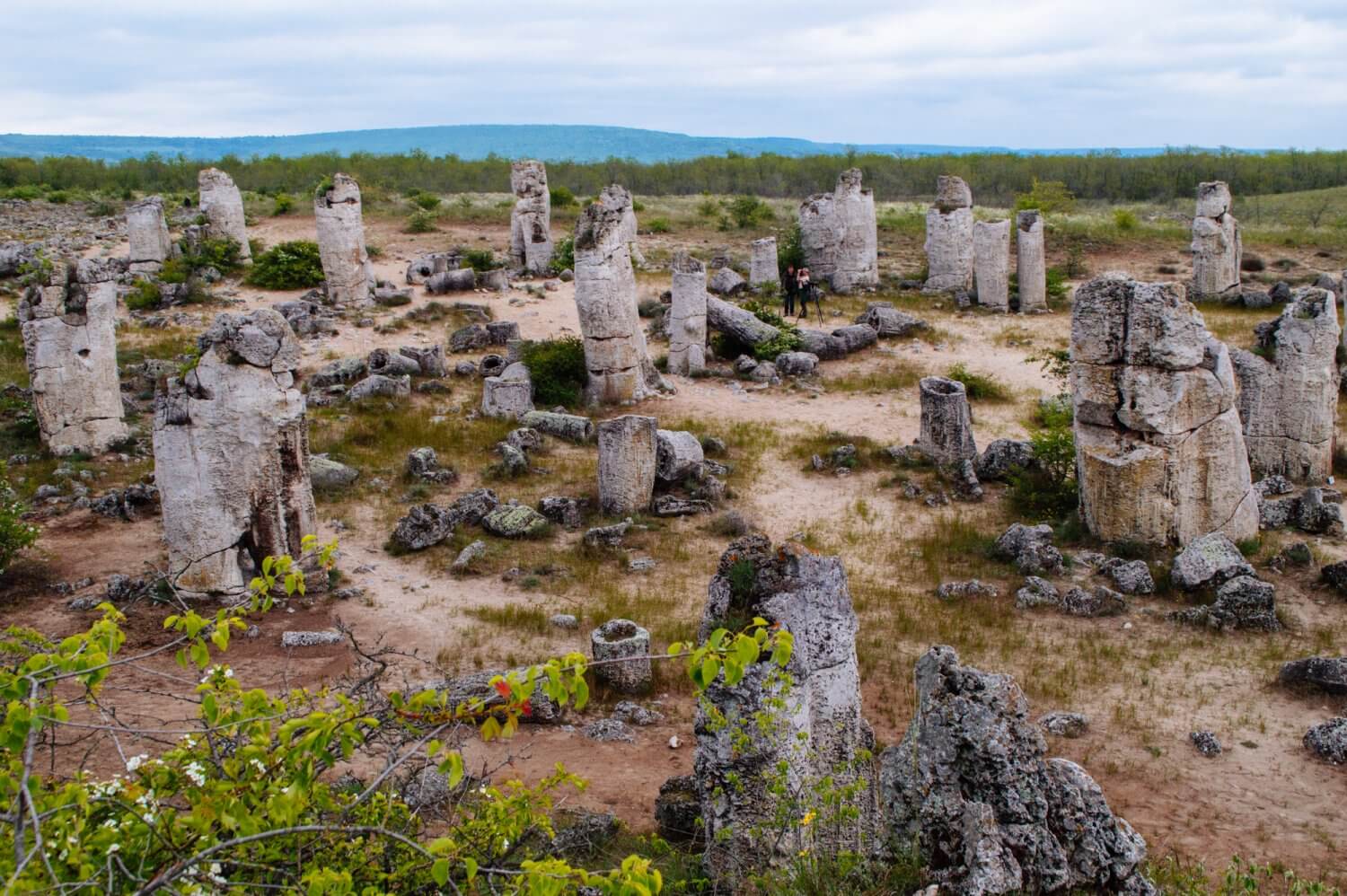
10. Stare at some emo Church frescos
When you visit Veliko Tarnovo, one of the top must-dos is a visit to Tsarevets Fortress, which dominates the city, and even hosts a cool projected light show on special holidays.
Besides the impressive fortress views though, one of the most underrated (and unspoken about) highlights is the fortress’ Patriarchal Cathedral of the Holy Ascension of God (Ascension Cathedral), which has some of the most interesting frescos you’ll ever see.
The modernist paintings inside the Ascension Cathedral are painted with dark, moody colours and bold, striking lines, earning it my personal title of “most emo Church frescos ever”.
Apparently, due to these frescos, the church hasn’t been consecrated and therefore remains inactive.
I’ve also heard that you can access the Church tower for an additional fee for amazing views, but I didn’t get a chance to do this on my visit!
RANDOM TIP: Veliko Tarnovo and the area around it is one of the best places to go hiking in Bulgaria. I did a hike at a nearby peak and the views were stunning.
11. Spend a night sleeping under truly spectacular frescos at a mountain-top monastery
And speaking of frescoes…
While a trip to Rila Monastery is one of the most common Bulgaria excursions, it’s a little known secret that you can actually spend the night there too.
Yes, think of it as a fun slumber party at one of the most iconic tourist attractions in Bulgaria.
While I sadly didn’t learn about this secret until I completed my lame non-overnight day trip, I’ve put it on my list for future trips. After all, how often do you get to snore away at one of the most historical places in Bulgaria?
You can read about one blogger’s experience sleeping at Rila Monastery here .
RANDOM TIP: People love this spot for hiking in Bulgaria too, so if you can find a way to combine your overnight stay with some hiking, I highly recommend you do it!

12. Take a walk across Devil’s Bridge
Last but not least, I present you Devil’s Bridge (Dyavolski most) , a sight that I unfortunately haven’t been able to see for myself, but is nonetheless so cool I had to include it.
This 16th century bridge looms ominously over the Arda River, casting perfect reflections over the water. Of course, the bridge is more than just a pretty sight – it’s an attraction steeped in dark folklore and mysterious tales (my personal favourite).
From rumours that the head builders’ wife died on site, trapping her shadow in the bridge, to theories that a footprint from the devil itself taints the bridge, this is an eerie yet beautiful spot to put on your Bulgaria bucket list.
Practical Bulgaria Travel Info
So, if my wordiness and fangirl enthusiasm have sold you, here are some practical tips to know before you visit Bulgaria for yourself.
Cheap Flights to Bulgaria
Based on my flight deal stalking, I’ve noticed there are always cheap deals to Bulgaria, especially with budget airlines like Wizz Air.
This is what brought me to Bulgaria in the first place! While Wizz Air is an okay airline if you’re prepared for it (click here to read my full, honest Wizz Air review ), there are also other airlines that fly to Bulgaria’s major airports (Sofia, Burgas, Varna, etc.)
Use Skyscanner to find cheap flights to Bulgaria.
Where to stay in Bulgaria
Bulgaria is an amazing travel destination for budget travellers. Accommodation options are seriously affordable, whether you’re looking to get hostels, hotels or apartment rentals.
If you’re looking for a more social atmosphere and easy access to packaged tours, I recommend staying in a hostel. I always use Hostelworld to book my hostels. During my first trip, I stayed at Hostel Mostel in both Sofia & Veliko Tarnovo. They’re great backpacker places because they provide free dinner as well, though the facilities aren’t super modern or clean.
Otherwise, if you’re looking for more privacy, I love using Booking.com to book places on the go, especially because they have very lax cancellation policies. AirBNB is another great choice if you’re on a budget ( click here for a coupon code on your first rental!)
Last but not least, if you really want a lot of options, use HotelsCombined to search a bunch of comparison sites at once.
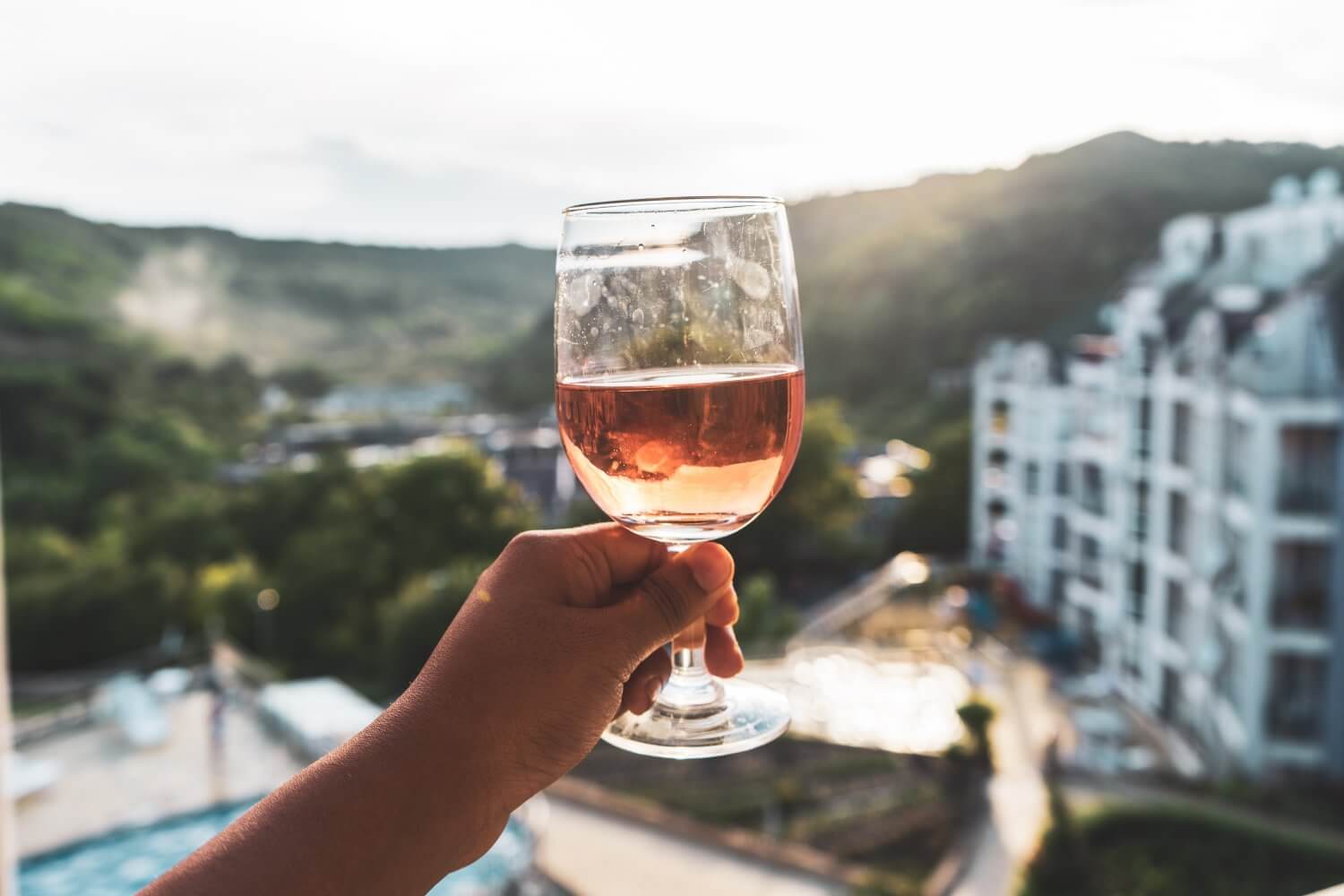
Visit Bulgaria Like a Smartie: Extra Bulgaria Travel Tips
Know that bulgaria is a pretty huge country.
A lot of people don’t realize how big Bulgaria is.
There are loads of beautiful places in Bulgaria so definitely don’t expect to do them all in a single trip. Even after two visits, my Bulgaria wish list just gets longer and longer.
Bulgaria is safe, but…
One of the biggest questions I got after my first Bulgaria trip was “is Bulgaria safe?”
As a solo female traveler on my first trip, I definitely felt safe, although in larger cities like Sofia, I experienced some “solo female woes” that are common in major cities, like unwelcome advances from men or airport taxi scams (seriously don’t just go with any random guy at the airport terminal – he’ll probably charge you 3x the price!)
These things are common everywhere though, so don’t let them put you off from visiting. So long as you take typical precautions (like not walking alone in dark areas at night), you’ll be fine.
Plus, once I was with friends (on my 2nd trip), I never once felt unsafe.
Learn the Cyrillic alphabet
My #1 regret during my first Bulgaria trip was not familiarizing myself with the Cyrillic alphabet, which is used in signage all around the country.
Navigating Bulgaria solo was really daunting at first because I wasn’t able to read any signs, which meant buying bus tickets was scary, finding the right bus was scary, and everything in general was mildly scary.
Don’t be dumb like me and take a few hours to learn it! It’s not too tough actually and only takes a few hours if you follow this guide.
Don’t expect to be catered to in English
One of the things you should know when you visit Bulgaria is that even areas considered to be “Bulgaria tourist places” are much less touristic than some of the major sights elsewhere in Europe.
Yes and no are confusing
Okay, I’m not joking when I tell you that Bulgarians shake their head when they want to say yes.
It’s like opposite land.
Similarly, “no” is indicated with a nod upwards. I mean, I can tell you this a million times but you still won’t get used to it. Just thought you’d like to know 😉
Last but not least, bring stretchy pants
This tip is only a half-joke. Bulgarian food is hearty, delicious AND affordable, which of course may lead to disastrous consequences on your waistline. Eat as much as you can.
One does not simply go to Bulgaria and not gain a terrifying amount of weight, you feel me?
Avoid feeling terrible about yourself by bringing some loose-fitting clothing 😉 You’ll thank me later.
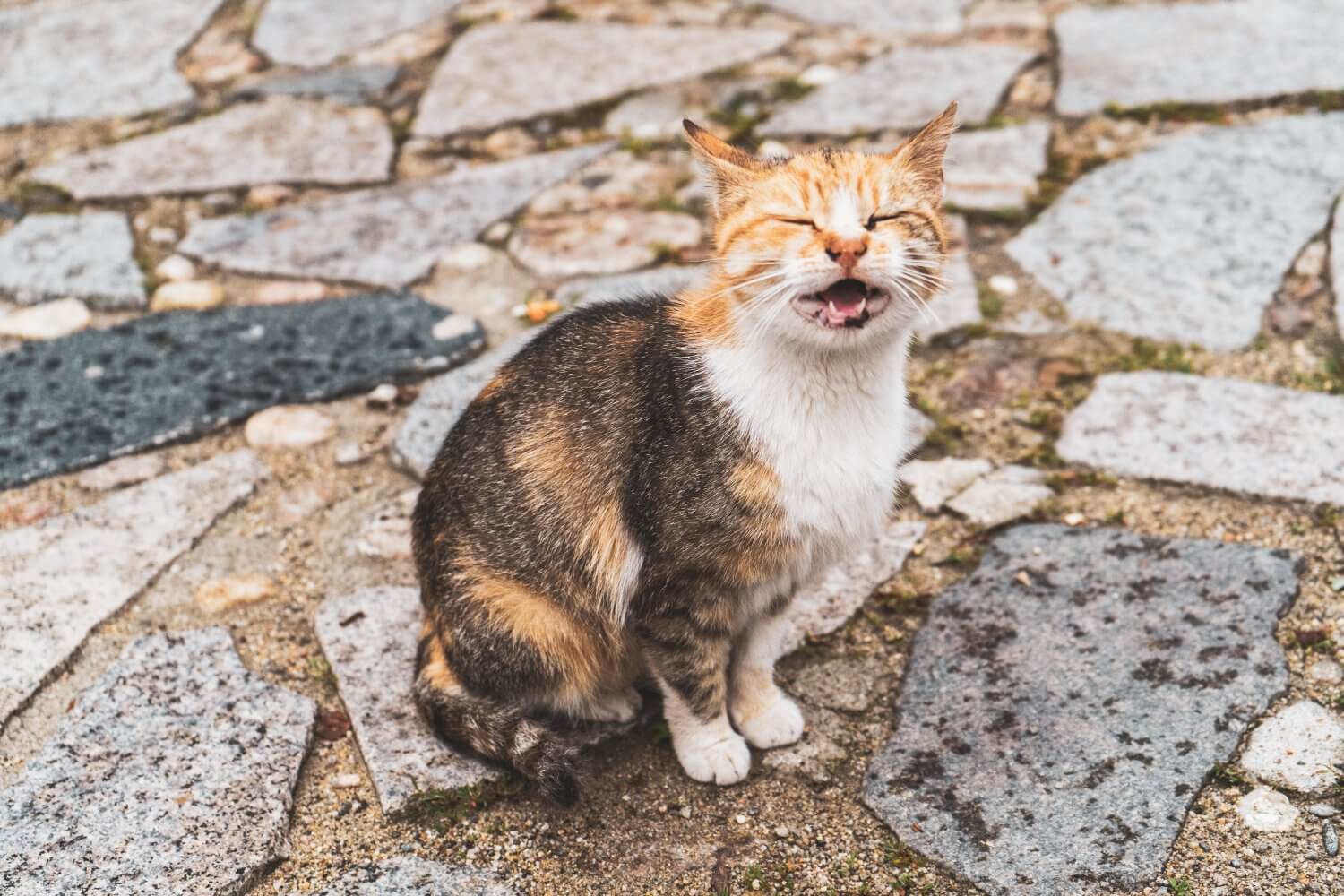
Additional Bulgaria Travel Resources
Feeling hyped up after reading this list of things to do and places to see in Bulgaria? Here are some additional resources for you to peruse.
Sofia Adventures: My expat friends Allison and Stephanie run this ridiculously thorough resource on travel in the Balkans, with detailed guides on Sofia, Bulgaria and beyond.
Travelling Buzz: My friend Maria is a native Bulgarian who lives in Sofia and is a WEALTH of knowledge about Bulgaria and travelling around the country. If you’re looking for a true locals’ POV, be sure to check out her blog.

So, what other Bulgaria travel destinations should I add to the list? Let me know in the comments!
BONUS: Best Places in Bulgaria Map
Eager to get going? Here are all the places mentioned in this article plotted for you on a map!
My Go-To Travel Favourites:
🧳 Eagle Creek: My favourite packing cubes
💳 Wise: For FREE travel friendly credit cards
🍯 Airalo: My go-to eSIM
🏨 Booking.com: For searching hotels
📷 Sony A7IV: My (amazing) camera
✈️ Google Flights : For finding flight deals
🌎 WorldNomads: For travel insurance
🎉 GetYourGuide: For booking activities
21 thoughts on “12 Unique and Fun Things to do in Bulgaria (That You Probably Didn’t Know About)”
Umm like wow. How was Bulgaria never on my radar? Like this country is STUNNING!! At least now it’s been added to my bucket list :).
Great post! I always love reading about destinations which are slightly off the radar. Hope we will have chance to explore it soon on our own!
The torches are my favorite! They look so neat! I love the juxtaposition of the lavender field with the sunflowers, too. So pretty!! <3
Christina, Bulgaria looks amazing! It’s one of those coountries I’ve meant to take to some time to research to decide whether to head there and whether Sofia might be a good city break. You’ve convinced me on both points!
I’m with you all the way Bulgaria is beautiful. We had a month tgere and parked up in our camper beneath the Buzludzha monument. Check our blog out as we have a host of other places for you to visit next time like Melnik, the Rhodope Mountains with the Devil’s throat and the Eagle’s Eye unforgetable 4×4 trip. Also Etar village up by Shipka is amazing. A few new places for our next visit too. Ty.
Obviously this is going to be my next trip after South America! Thanks for all the awesome info!!
You’re right! I never knew about any of this! Bulgaria looks like such a beautiful and interesting country. I shall add it to my bucket list immediately!
Wow, this mouthful of a post surely makes me want to go to Bulgaria! Sounds ideal for nature lovers like myself! Guess who’s pinning this! Not sure my head has room foe a 5th language, but hmm, maybe with some extra motivation i could squeeze one more! Lol!
All of these places look so awesome. Bulgaria was never really high on my list, more just on my radar. But seriously looks so cool!
Omg I totally want to go to Bulgaria now! I had heard about it from my friends who are from there but I never really knew what there was to see. I didn’t realize there were so many cool things to do! Free food tour?! Yes please! Abandoned UFO? So cool. Barbie’s dream church? Love! Thanks for begrudgingly sharing all these awesome places 😉
So happy to see someone who shares our love for Bulgaria! The first time we visited the country it was with very little information available in English. We honestly chose it as destination due to cheap flights, but we’ve been dreaming of going back since!
It really has everything that makes us fall in love with a country: friendly people, amazing nature, quirky landmarks and divine food! By the way, did you try parlenka? I’m obsessed!
We loved every second of our time in the Bulgaria, but our favorite part was hiking to see the Seven Rila Lakes – it was just incredible! We hope you get the chance to do it on your third visit =)
I have visited Bulgaria about a dozen times now and I would add the following tips: if you’re in the Western Rhodopes hike either from Borino to Yagodina through the Devil’s Bridge gorge or the other way round. If you are in the Eastern Rhodopes visit Madzharovo and its Vulture Centre and inform yourself about the best places to see these awesome creatures. You want more wildlife check the area south of Lake Studen Kladenets where animals like wolves, deers and bizons have found their home. Enjoy Bulgaria!
While I love your post and though I agree with almost everything you’ve written, I may be a bit biased, but you missed the best parts: Plovdiv, the nearby wine country (especially reds!) and the Rhodope mountains that run across the Greek border are simply magical. We’d be happy to show you around if you swing back through 😉
I just returned from Bulgaria. My boyfriend of 8 years finally took me and our 1 year old to his country and I was skeptical about visiting until my two hour drive from Sofiya to his village. I spent 16 glorious days experiencing Bulgaria not as a tourist but with family which will give you even more of a love for this county. When you go again there is a resort high up in the mountains that was INCREDIBLE. Somewhere near Baldevo, Goste Delchev. Because of this post we are going to Plovdiv on our next visit !
Wow, thanks for sharing all the awesome information! The country looks stunning! I love the photos you have taken for the flower field. It’s kind of like the one we saw in Hokkaido but it’s a lot more mature than there! Gonna put it in my bucket list!
Wooo!!! Hope you get to see the beauty of Bulgaria for yourself one day <3
Looking forward to travelling to Bulgaria in 2020. Thanks for the info. Would love more information on Varna and Burgas. Including a friendly local guide and hotel recommendations. Will be travelling by public transport.
After a week long holiday a few years ago we completly fell in love with this amazing country.We now live in the Targovishte region and our lives have changed for the better.I loved your post.thank you.xx
I first visited Bulgaria back in 2012 but was only there for a skiing holiday. Frankly at the time I wasn’t too impressed – surly waiters and lacklustre food were omnipresent. Also one of my biggest regrets is never having paid to do the day trip to Sofia that the tour company offered as an extra! I’ve since gone back to this region of the world many times and now feel like I “get it” but not yet to Bulgaria. As soon as I have the chance to spend some extended I cannot wait to do so and articles like this are just one of my inspirations….! Especially for that free food tour 😉
Thanks for sharing Christina, beautiful pictures you have there! We share your enthusiasm for the country as well, it’s just a pity that many have misconceptions about the safety situation there (e.g. crime, scams – really low and not major!), though it makes it less touristy for us to properly enjoy the place! 🙂
Great post Christina! Actually, one of the most detailed info for travellers in Bulgaria! Next time explore the Black Sea coast ( in summer 🙂 ) or why not join some of our trips?! Find excursions and trips on the Black Sea coast on our website 🙂 https://tours4you.online/
Leave a Comment Cancel reply
By using this form you agree with the storage and handling of your data by this website. *

The Perfect Bulgaria Itinerary: 5 to 10 Days (or More!)
Last Updated on February 14, 2024
by Maggie Turansky
Disclaimer: This article contains affiliate links. That means if you click a link and make a purchase, we may make a small commission. As an Amazon Associate we earn from qualifying purchases. For more information, see our privacy policy.
The Balkan country of Bulgaria has long been overlooked on standard European travel routes, where traditional tourists rarely travel farther east than Hungary or Croatia. However, for those more intrepid visitors keen to see the delights that southeastern Europe has to offer, planning a 5 to 10 days in Bulgaria itinerary is a fantastic idea.
Though relatively small in size, Bulgaria has a lot to offer visitors and really can appeal to almost every personality. Bulgaria boasts cosmopolitan cities and ancient metropolises, rugged mountains and pristine beaches, world-class skiing and incredible wine country — it can seem that wherever your interests may lie, Bulgaria will have it.
Table of Contents

When to Visit Bulgaria
You are likely going to want to know when is the best time of year to visit this European nation. Well, luckily for travellers, Bulgaria has its merits no matter what time of year you choose to visit so it all depends on what you’re after on your trip.
While it is located in southeastern Europe, don’t expect Bulgaria to have the same kind of climate as other southern European countries like Croatia , Portugal, Italy or Spain. Contrary to these countries, Bulgaria experiences a much more continental climate with very cold and snowy winters and hot, muggy summers. With this kind of climate, you can best bet to enjoy all of the seasonal activities that come throughout the year.
Winter in Bulgaria sees high temperatures averaging around freezing throughout most of the country, though it can certainly be colder high in the mountains or warmer in the coastal areas along the Black Sea.
With the winter freezes come a lot of skiing opportunities at some of the most affordable prices in all of Europe. Destinations like Bansko are incredibly popular in the wintertime, however, you can also easily combine a skiing holiday with a cosmopolitan city break without leaving Sofia by visiting Vitosha Mountain.
Summers, on the other hand, can get incredibly hot, with average temperatures soaring to well over 30°C (86°F) and humidity can be quite high, as well. The inland cities in the summer can be sweltering, however, the coast becomes a bustling mecca for sun worshippers and party seekers alike.
The mountains can also be a pleasant escape with ample hiking opportunities and mild temperatures in the high altitude. Summer is also, not surprisingly, when tourist crowds are at their peak, as are accommodation prices.
If you’re sensitive to either the cold or heat and want to avoid tourists as much as possible, then probably the best time to visit Bulgaria would be in the shoulder seasons.
The months ranging from March-May and September-October see some of the mildest temperatures, though you should be prepared for the occasional cold snap or frequent rains (especially in Spring). However, in the shoulder seasons, you are just as likely to have beautiful warm temperatures and sunny skies that steadfastly cling to summer.
No matter which time of year you choose to embark on your trip to Bulgaria, you are sure to be met with a beautiful country eager to welcome your exploration!

Getting To & Around Bulgaria
Now that you’ve figured out which season to travel to Bulgaria, we need to discuss how you plan to get around once you’re there.
First things first, it is likely that you will begin your Bulgaria itinerary by flying into Sofia airport, which has frequent connections from budget airlines like Ryanair and Wizzair to a number of cities throughout Europe. The affordability of reaching Bulgaria has made it an attractive option for travellers looking to explore a lesser-visited corner of Europe.
There are other international airports in the country besides Sofia, however, and you can just as easily begin your trip from any of these. The highest-trafficked airports after the capital include Burgas and Varna on the Black Sea and Plovdiv airport, which serves a couple of flights per week from destinations like Tel Aviv, Belfast, Manchester and Dublin.

If you’re visiting Bulgaria as part of a longer Balkans itinerary you will be happy to know that a few of the country’s major cities are fairly well connected with neighbouring countries. Travellers can easily reach Sofia from Thessaloniki in Greece, Belgrade or Nis, Serbia and also from Skopje , North Macedonia and Istanbul , Turkey, the latter of which will transit through Plovdiv.
You can also reach Sofia by overnight bus or train from Bucharest , Romania. It is also possible to find a direct connection to the northern city of Veliko Tarnovo to Bucharest as well.
Once you’ve arrived in Bulgaria, you need to know how you plan to get from point A to point B. Like elsewhere in the Balkans, if you’re relying on public transport for your Bulgaria trip, then your best option is going to be the bus.
While there is a train network in Bulgaria, it largely hasn’t been updated since the 1960s and can be incredibly slow, uncomfortable, and inefficient. The only time I would generally recommend using the train network in Bulgaria is if you have an affinity for communist-era railways.
In contrast, the bus system is quite comfortable and well-developed and they also tend to be much faster than the trains.
If you are only travelling between major cities, you will find that connections between transport hubs tend to be frequent and the system is easy enough to navigate, even if you have a language barrier. It can be helpful to know what the city you’re travelling to looks like spelt in the Cyrillic alphabet so you know which booth to buy your tickets from.
Most smaller city centres are easily navigable by foot, including cities like Plovdiv and Veliko Tarnovo, however, in Sofia, it might be necessary to use the public transportation system. The metro in Sofia is efficient and user-friendly, with everything written in both Bulgarian and English.
If you need to take a taxi in Bulgaria, make sure to practice the general precautions you would with taxis throughout the world as, unfortunately, Bulgaria is not immune to taxi scams. However, there are a number of taxi apps in various cities where you can call a reliable cab.
If you do hail one off the street, make sure to do some research on reliable taxi companies beforehand and ensure that the meter is running. Taxi rides are incredibly affordable in Bulgaria, especially when compared to some Western European countries.

5 to 10-Day Bulgaria Itinerary
Bulgaria has a lot to offer visitors and, therefore, travellers can easily spend a number of weeks or even months within the country and always find something new to explore. However, if you only can spend 5 days in Bulgaria, then the first five days of this itinerary is outlined to be a complete trip.
If you have a week, the same concept applies if you have 7 days in Bulgaria. And if you’re fortunate enough to have 10 full days to spend in this Balkan nation, then you can enjoy the entirety of the outlined route.
Days 1-3: Sofia
It is likely that you will begin your Bulgaria itinerary in the capital city of Sofia. Though Sofia may not have to best reputation among Balkan cities (when we first planned to visit, we were told to skip it by numerous people), we’ve found that it has a lot to offer visitors with great energy and many interesting things to do.
Though you could easily spend a week or more exploring Sofia , we recommend spending 3 of those days in the capital. Start off with a free walking tour of the city to get your bearings, a great way to get some context to the incredible history you’re going to see in the Bulgarian capital.
There are a number of things to occupy yourself during these three days in Sofia including visiting the top monuments like the ancient city of Serdika and the Alexander Nevsky Cathedral.
You can also take the time to visit some of Sofia’s many museums, enjoy its thriving culinary scene, and learn more about its communist history.
Though it may not be the most beautiful of cities, there is a very cool edge that Sofia holds and it can be worth also learning about its burgeoning street art scene.
If you only have three days, we do recommend that you spend all of them in Sofia as it will allow you to really get to know the city. However, if you want to see more of the countryside, it is possible to go on a day trip.
Rila Monastery – a UNESCO World Heritage Site – is one of the most popular day trips from Sofia, as is the nearby Vitosha Mountain, which you can reach by Sofia’s own public transport.
Where to Stay in Sofia
Art ‘Otel – This hotel is a great option if you’re after some luxury. They are well located within easy reach of all the major city sights and have a range of clean and comfortable rooms available. They also have a great breakfast included in the room rate.
Hostel Mostel – This hostel is your best bet if you’re travelling solo or on a tight budget. As one of the most popular and well-rated hostels in Sofia, they have a range of dorm and private rooms available, a friendly staff, and great common areas for you to meet other travellers.
Not quite what you’re looking for? Click here to browse more Sofia hotels!

Days 4-5: Plovdiv
After exploring Sofia, the final step on a 5-day Bulgaria itinerary should be the second-largest city of Plovdiv. As one of the European Capitals of Culture in 2019, Plovdiv is probably the most tourist-friendly city in Bulgaria and it has a lot to offer visitors.
Plovdiv is thought to be the oldest continuously inhabited city in Europe, with a history dating back over 6,000 years. Though Plovdiv is most famous for its incredible ancient amphitheatre. there is a lot more that the city has to offer, which is why we recommend spending two days in Plovdiv to really get to know the city.
Spend your first day in the city exploring its ancient monuments and Roman ruins like the aforementioned amphitheatre and the ancient stadium. Wander through the picturesque old town and enjoy the view of the city from the ruined fortress on Nebet Tepe.

You can also head into the trendy neighbourhood known as Kapana, which means “The Trap” in Bulgarian.
These windy, pedestrian streets have recently been refurbished by a lot of government investment and are now full of great restaurants, cafes, bars, and independent shops and have become a haven for local artists. If you’re interested in hipster culture or street art, this is the neighbourhood to visit.
You can also use Plovdiv as a base to go wine tasting in the Thracian Valley. The nearby town of Brestovitsa is home to several wineries and is only 20 kilometres from the centre of Plovdiv.
Though Bulgaria may not be the first country that comes to mind when it comes to wine tourism, it has one of the oldest viticultures in the world and produces some truly fine vintages.
Where to Stay in Plovdiv
Hotel Evmolpia – Situated in the Old Town, this charming boutique hotel is within easy walking distance of everything to see and do in Plovdiv, including the amphitheatre, Kapana district, and main pedestrian street. They have a number of clean and comfortable rooms available and a good breakfast.
Hostel Old Plovdiv – Located in the heart of the Old Town, this hostel is located in a traditional revival house and is one of the best places to stay in Plovdiv. They have a very welcoming a helpful staff, a range of comfortable dorm and private rooms available, and a great breakfast included in the room rate.
Not quite what you’re looking for? Click here to browse more Plovdiv hotels!

Days 6-7: Black Sea Coast
After spending the first five days in Sofia and Plovdiv, it’s time to head to the coast and enjoy the gorgeous Black Sea.
There are a number of great places to visit on the long coastline of Bulgaria and it really depends on what kind of experience you’re after. If you want a smaller, more sleepy seaside town, then head to lovely Sozopol. This town boasts a couple of fine sand beaches, beautiful cobbled streets, and a laid-back atmosphere.
If you want some more western amenities, a party scene, or a high-end beach resort, the head to Sunny Beach or Nessebar which are significantly more touristy and developed than Sozopol.
If you want a big city vibe but still some great beach time, then head to Varna or Burgas, the biggest cities on Bulgaria’s coast. No matter where you choose, you are sure to enjoy a couple of days enjoying the charms of the Black Sea.
Where to Stay on the Black Sea
Hotel Diamanti – If you’re looking for a more subdued seaside holiday on the Black Sea, then the perfect place to stay in Sozopol would be this hotel. They have a number of affordable rooms available, some with sea views, a restaurant on site, and a great breakfast included in the nightly rate. They are also located within walking distance of everything in Sozopol.
Nomado Hostel – As one of Varna’s highest-rated hostels, this is a great place to visit if you’re looking to see the Black Sea on a backpacker’s budget or as a solo traveller. They are centrally located, have a friendly and helpful staff, an included breakfast, and both dorm and private rooms available.
Not quite what you’re looking for? Click here to browse more Black Sea hotels!

Days 8-10: Veliko Tarnovo
If you’re fortunate enough to have 10 days to spend exploring Bulgaria, then heading to Veliko Tarnovo for the last two days is an excellent ending point.
Veliko Tarnovo, located to the north of Bulgaria, is a lively university town that once acted as the capital of Bulgaria. Today, it is famous for its mountain scenery and impressive fortress that commands spectacular views over the city and mountains surrounding.
Veliko Tarnovo is incredibly picturesque and well worth taking a day or two to explore on foot. It is also located very close to a number of great mountains, so it is possible to use the city as a base to go for a great day hike. As the former capital of Bulgaria and another ancient city, there is also a long and fascinating history here that is worth learning about.
As the home of one of Bulgaria’s best universities, there is also a lively, youthful energy which makes for a lot of good eateries, bars, and cafes along with some trendy shops and things to do.
Where To Stay in Veliko Tarnovo
Augusta Spa Hotel – This boutique hotel is centrally located and is a great option if you have a bit of a higher budget when visiting Veliko Tarnovo. They have a range of clean, comfortable, and air-conditioned rooms available, some commanding great views of the medieval fortress, and a great breakfast included in the nightly rate.
Hostel Mostel – This hostel, owned by the same people who run the branch in Sofia, is an excellent option for budget and solo travellers. They have both dorm and private rooms available, breakfast and dinner included, and great common areas to meet other travellers.
Not quite what you’re looking for? Click here to browse more Veliko Tarnovo hotels

Have More Time?
If you have more than ten days to spend in Bulgaria, or fancy getting a bit further off the beaten path, there are a few options you could take.
First, if you like nature, small towns, and wine, then heading to the lovely town of Melnik is a fantastic option. This tiny town is relatively easy to reach by public transport from Sofia and is an excellent stopping off point if you’re heading south to Greece after travelling in Bulgaria.
If you want to experience some of the best and most affordable skiing in Europe in the winter or visit a pristine hiking mecca in the summer, then the town of Bansko is also a great option to add to you Bulgaria itinerary.
Finally, the northwestern town of Belogradchik close to the Serbian border is a great offbeat destination in Bulgaria. Famous for its unique rock formations and imposing fortress, spending a day or two here will show you a different side to the country.
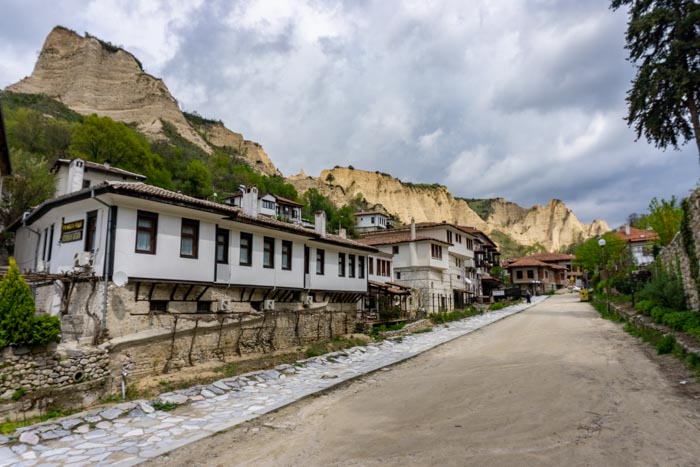
No matter how many days you have to devote to a Bulgaria travel itinerary, there is no denying that there are countless things to see and do in this underrated European nation.
Are you planning to visit Bulgaria? Have any questions? Let us know in the comments!

Related Posts:

My Perfect Plovdiv Itinerary For First-Time Visitors

Is Bulgaria Expensive? A Guide to Prices in Bulgaria

12 Things to Do in Veliko Tarnovo: A One-Day Itinerary

About Maggie Turansky
Maggie is a co-founder and writer for The World Was Here First. Originally from the US, she has lived in five different countries and has travelled to dozens more, both solo and with her partner, Michael. She particularly loves exploring Spain and spending time in the Caucasus and the Baltics. Read more about Maggie
great itinerary, lots of useful tips too. many thanks. marilyn
Thanks, Marilyn! Hope you have a great trip.
Hi. This looks like a very useful itinerary. Plan to visit next early June after an extended Turkey, Azerbaijan, Armenia trip. Was planning 5 days but I think 10+ will afford a much better flavor of Bulgaria. Thanks!
Hello, What is the best way to travel from Plovdiv to Varna? Bus? Return to Sofia and take a flight to Varna?
Best regards, Oliveira
You can take a bus directly from Plovdiv to Varna 🙂
How affordable and practical would it be to rent a car for places outside Sofia? Or is bus a better option than driving?
Renting a car can be a great option if you want a lot of flexibility and not to be beholden to bus timetables. Prices can vary depending on a number of factors.
How would you recommend getting to Plovdiv from Sofia? Could we take the local bus?
Yes, the bus is the best way if you’re using public transport 🙂
If I want to do a Bulgaria Greece trip. Start in Sofia then to Plovdiv. Can I fly into Greece next from Plovdiv? Or do I need to go back to Sofia to catch a flight?
Hi Dee Dee, Plovdiv airport is quite limited in its routes so I think your best bet would be to go to Sofia if you want to fly to Greece. Alternatively, I would recommend looking at taking the bus and going overland!
Another interesting old town is Koprivshtiza, on the road from Sofia to Black Sea, in high mountains and very picturesque. Also, there are many caves, waterfalls, natural wonders, and spa options to choose from.
Thanks for the tip, Lil!
Thanks a lot for this wonderful guide. I find it quite helpful.
Thanks, Gali! Hope you’re able to plan a great trip 🙂
Leave a Comment Cancel reply
- Search Please fill out this field.
- Manage Your Subscription
- Give a Gift Subscription
- Newsletters
- Sweepstakes
Go Off the Beaten Path in Bulgaria — and Find Historic Cities, Stunning Landscapes, and a Mix of Cultures
Bulgaria is often overlooked, but with historic cities and stunning landscapes, it makes for a fascinating European trip.
It was well past midnight when we arrived at Zornitza Family Estate , a rambling property in southwestern Bulgaria, near the Greek border. The country roads were unlit, our path illuminated by nothing but the moon and stars. Our only sense of place came from the smell of roses that hung heavy in the air. My husband, Nikos, and I stumbled into our room, exhausted and half-blind from the eye-straining drive, and immediately fell asleep.
"I think it's almost nicer to arrive here at night," Yavor Kirov, the property's general manager, told me the next morning with a smile. "Because then you are pleasantly surprised when you wake up."
In the pale morning light of May, this corner of Bulgaria is old-world bucolic. Zornitza, a member of the Relais & Châteaux hotel consortium, sprawls out across softly rolling pale-green hills that are striated with more than 100 acres of grapevines. (The estate has its own wine label.) Everywhere I turned there were roses, from tiny pink buds crawling up stone walls to giant tiger-streaked petals trembling in the breeze. There were organic orchards flush with early-summer sour cherries and apricots, herbs growing along a creek, beehives, a livestock farm, and a lake for fishing. Guests are encouraged to pick any fruit or flowers they find on the estate, mimicking the feel of a traditional rural Bulgarian childhood.
"This is really the concept," Kirov explained. "To create a place where guests are in full harmony with the great nature we have."
Long overshadowed by its southern neighbors and, for Americans, often associated singularly with its Communist past, Bulgaria is only now starting to be seen as a travel destination — boosted by a growing interest in Eastern Europe (and far enough removed from the war a few countries north in Ukraine). I first became enthralled with the country while reading Kapka Kassabova's extraordinary book Border: A Journey to the Edge of Europe. Kassabova, who left Bulgaria as a teen after the collapse of the Soviet Union, returned to her homeland 20 years later to explore the layered communities along its borders with Greece and Turkey. Her book highlights the natural beauty and mysticality of Bulgaria; instantly intrigued, I began plotting a trip from my home in Greece.
Everywhere I turned there were roses, from tiny pink buds crawling up stone walls to giant tiger-streaked petals trembling in the breeze.
Kirov was happy to indulge my curiosity. He took us for a hike in the nearby Pirin Mountains — a range that, as one story goes, derives its name from the Slavic god of thunder and lightning. (Neither, thankfully, was on display during our walk.) The area is known for its special energy: abundant mineral springs, thought to have healing properties, make this a popular wellness destination.
Our first stop was the Melnik Pyramids, a natural rock formation that looks like rust-colored sandcastles emerging, rather incongruously, from behind a forest. As we scrambled up a jagged ridge, Kirov pointed out a dormant volcano, Mount Kozhuh, in the distance. This, too, is revered for its energy — and for being the birthplace of Baba Vanga, the blind mystic and medium who holds a special place in Bulgarian culture. On our way back down, we stopped at the medieval Rozhan Monastery, resplendent with 16th-century frescoes and wood carvings.
Our appetites piqued, Kirov ushered us into the restaurant at Rozhenski Han, which has an open stone courtyard decorated with local ceramics. Before long, a steaming cheese-topped loaf arrived on a wooden plank. The chef, his belly generously protruding in pitch-perfect marketing for his cooking, sliced into the stuffed bread with surprising delicacy. Tender slices of meat and vegetables fell out of the loaf and onto the plate, and the smell of a typical Bulgarian spice blend, tsubitsa, wafted through the air. This was bohcha, a dish so good I didn't wait for the heat to subside before digging in. Luckily there was plenty of chilled rakia, the Balkan fruit brandy, to cool me down. The chef took a shot with us and, in a typical display of Bulgarian hospitality, sent us off with presents: a warm, fluffy loaf for Kirov, and a small bag of tsubitsa for me.
The next day, my husband and I left for the capital, Sofia, taking the longest possible route through the mountains. I rolled down the windows and breathed in the damp forest air as rivers and trees rushed past. We made a detour east to see the Rila Monastery, the largest and most important Eastern Orthodox monastic complex in the country and a UNESCO World Heritage site. Founded in the 10th century, the original structure burned down in the 1840s and was rebuilt in the National Revival style. Black-and-white-striped domes curve upward, the restored frescoes within painted in vivid colors. I could've stayed for days looking at each scene (and some devoted people do, sleeping in the old monks' cells), but a crack of thunder and subsequent downpour forced us back into the car.
Thracians, Greeks, Romans, Slavs, Ottomans, and, later, Russians have all left their imprints. Churches, mosques, and synagogues sit on the same street, and Ottoman-influenced food is served in the shadows of Baroque Revival buildings.
Bulgaria is almost obscenely fertile — right down to its name, that bulging B and those round vowels filling up the mouth. After just a few days in the countryside, I had gotten used to being surrounded by abundant nature. So entering Sofia, with its clogged streets and faded Socialist-era apartment buildings, was a shock to the system. Many post-Communist cities have a reputation for being drab — but as with most good things in life, their charm lies beneath the surface.
We checked in to the Hyatt Regency Sofia, where we were greeted by sleek lines and a subtle color scheme. It's one of the newest additions to a scene dominated by grand, if dated, hotels; the Hyatt is among the few energy-saving "smart" hotels in the city. It overlooks Vasil Levski Square, named for a hero from the Bulgarian revolution against the Ottomans in the late 19th century. The property is a stone's throw from all the major cultural sites (including St. Alexander Nevsky Cathedral, Sofia University, and the National Gallery), which I took in all at once from the hotel's rooftop bar with an expertly crafted negroni in hand.
"Sofia has existed for more than seven thousand years," general manager Laurent Schauder explained over a coffee in the light-filled lobby. Those centuries brought many different would-be conquerors to the city, all of whom left their imprints: Thracians, Greeks, Romans, Slavs, Ottomans, and, later, Russians. Churches, mosques, and synagogues sit on the same street, and Ottoman-influenced food is served in the shadows of Baroque Revival buildings.
Of course, Bulgaria's Communist past looms large in the imagination of Americans. Georgi Georgiev, a history student and guide who led us on a four-hour tour of Communist-era sites, feels similarly: "It is part of our history," he told me. "It was short, but it completely changed the lives and mindsets of Bulgarians." The architectural styles of the Eastern bloc can be found throughout the capital, but I was most touched by a somber monument tucked away in a corner of the National Palace of Culture park, where the names of thousands of victims of the regime are engraved in black marble.
These days, the leafy-green neighborhoods around the Hyatt, including Doctor's Garden and Zaimov Park, are a pleasant jumble of hip restaurants, record stores, and third-wave coffee shops. At Raketa Rakia Bar , we tasted our way through an extensive spirits list, accompanied by copious amounts of grilled meat and the buzz of happy diners.
Buteven Sofiates will tell you the most beautiful city in Bulgaria is Plovdiv. We drove east out of the capital and headed to the country's second most populous city, famous for being the oldest continuously inhabited settlement in Europe: a dizzying variety of people have passed through, and at one point, it was the Byzantine Empire's third-largest metropolis. The layers, of course, remain. Plovdiv's founders were the Thracians, an early Indo-European group who spread across the Balkans and to whom many Bulgarians still feel a historical and cultural connection.
"An early name for this city was Evmolpia," explained Hristo Gyulev, the owner of the Hotel Evmolpia , an Ottoman-style inn in the city's old town. "Evmolpus was a Thracian king and famous warlord who could talk with the gods." Ah — there's that Bulgarian mysticism again.
If Sofia was concrete, Plovdiv, built on seven hills (well, now six, after one was mined for cobblestones), felt totally green: fruit trees and bushes line the sidewalks, and mulberries and cherries fall onto the ground, leaving sticky traces underfoot. "Well, we are located in the middle of the most fertile lands in Bulgaria!" Gyulev told me. In June, the air smelled like flowers or apricots or, if the wind was blowing in a particular direction, both.
The entirety of Plovdiv, particularly the old town, exudes a kind of fairy-tale romance. The streets are narrow and cobblestoned, pastel churches hide behind towering elms and lindens, and the views from the hilltops are breathtaking, especially when you get a glimpse of the city's most famous landmark: a second-century Roman amphitheater, well preserved and still hosting performances. A gaggle of schoolchildren entered at the same time we did, shrieking with delight. "This isn't even the most impressive thing to see here," one blasé Plovdivite told us. "You should go to the Bishop's Basilica."
The entirety of Plovdiv, particularly the old town, exudes a kind of fairy-tale romance. The streets are narrow and cobblestoned, pastel churches hide behind towering elms and lindens, and the views from the hilltops are breathtaking.
Bulgaria has some of the most well-preserved Roman ruins outside of Italy or Greece. The government has made an effort to restore these monuments, but they are so numerous it can't seem to keep up. The Bishop's Basilica of Philippopolis is a notable exception. In 1982, roadwork accidentally unearthed stunning Late Antique mosaics dating back to the fourth through sixth centuries. They once covered the floor of this early Christian church — which was probably demolished in the Middle Ages — and were later hidden away under a parking garage. After years of restoration, a new museum built around the ruins of the Basilica opened to the public in 2021. We padded into the structure wearing protective slippers; an elevated glass walkway allowed us to roam without damaging anything. Exquisite geometric patterns and birds unfolded underfoot. The site is still being excavated — one bespectacled archaeologist sat in the middle of the floor, methodically sweeping dust with an almost religious devotion.
What to do in the face of so much beauty? I was reminded of something Kirov had explained to me back at Zornitza: Thracian people believed the person who got drunk first was the closest to the gods. I headed to Bandida, a hole-in-the-wall wine bar serving regional varieties, like Mavrud, for a quick aperitif before properly indulging in a full rakia-addled meal at Pavaj , where chef-owner Raycho Markov serves up Bulgarian comfort food with a modern twist. His dishes use traditional recipes and organic vegetables from his family garden: duck-stuffed grape leaves, local sausage, and tangy, crunchy salads.
But the real star was the rakia list, which features 50 varieties from across the Balkans, from a Serbian one made with raspberry to a Bulgarian one made from quince. It's something new for Plovdiv, but the nightly crowds would indicate that people can't get enough. "I'm just so glad to see all these people appreciating rakia and learning that this is a special Balkan drink," Markov told me over dinner. "You feel very proud, you know?" By that point, we had lost count of how many times we'd cheers-ed each other, but we raised our thimble-size glasses once more.
Plovdiv is the frontier between more densely populated Bulgaria and the country's famed Rose Valley, a fragrant expanse of rolling hills that's home to the flower-growing industry. The following morning, our heads only slightly pounding from an excess of rakia, Nikos and I drove on to Kazanlak, the area's main town and a center for rose-oil production. Colors flashed from pink to red, and the smell drifting through the car windows was intoxicating. We made it just in time for Kazanlak's ceremonial rose-picking festival , held each year in early summer, complete with Bulgarian folk music and village girls dancing in traditional outfits. No one spoke English, but that didn't impact their generosity. One woman handed me a bag of rose petals with a smile, while another passed me a jar of rose-petal jam.
"Dionysus was Thracian," said Peyto Nikolov as he poured yet another glass of homemade natural wine. We had stopped at Hotel Gela , the inn Nikolov owns in the village of Gela, for lunch at its standout restaurant. The liquid sparkled in my glass like a ruby. "I'm sorry to say that, since you are coming from Greece, but it's true." He smiled and shrugged good-naturedly. We had left the Rose Valley and were now deep in the Rhodope Mountains — an unspoiled range that felt so mystical and timeless that the idea that Greek gods could have settled there didn't seem far-fetched. Behind us, fog rolled over the pine-covered mountains; the daily drizzles during our stay also yielded daily rainbows.
More Trip Ideas : 25 Under-the-radar European Villages
We polished off our plates of boiled nettle, soft cheeses, and roasted pork with perfectly caramelized skin. The last sips of wine were drunk at a speed that would have made Dionysus proud. We had important business to attend to after lunch: a trip to the entrance of Hades, otherwise known as Devil's Throat Cave. As we drove through the Gorge of Trigrad, steep walls of rock loomed above us and the forest seemed to shake its leaves with anger. The weather was mythologically on point — thunder rumbled in the distance, and the sky turned a steely gray. Our encyclopedic host, Alexander Bachvarov, deftly shifted gears through the switchbacks as conversation flowed from the Bulgarian economy and pre-Egyptian alphabets to psychotherapy.
Devil's Throat is known locally as a portal to the underworld: the Trigradska River rushes through the cave, but no object that floats in ever seems to float back out. Bachvarov warned that the place has a particularly deadly allure. In the 1970s, two Bulgarian divers set out to solve the mystery of the river's course. Their bodies were found days later, along with their still-functional scuba tanks. The coroner determined they had both suffered heart attacks. (They may have been lovers, a slightly reassuring point — at least they died together.) Since then, no one has properly spelunked the cave's full depth. As we entered through a damp tunnel and were greeted by a roar of water, Bachvarov and I agreed that some mysteries are better left unexamined.
This place is also associated with another doomed couple: Orpheus, who made an infamous descent into the underworld, and his dead lover, Eurydice, whom he tried and failed to retrieve. Orpheus was given permission by Hades to lead Eurydice back to the mortal world, provided he not look back until they were out of the cave. But unable to control himself, he turned around to catch a glimpse of his beloved, only to lose her forever. The spot where this happened, according to Bulgarian legend, is marked with a small statue, and a lump formed in my throat as we ascended a terrifyingly steep stone staircase and re-emerged into the lichen-filled forest.
When he's not taking guests to the edge of the underworld, Bachvarov runs the mountaintop Villa Gella , a bright and airy restored farmhouse exquisitely decorated with his personal art collection. "We don't want a hotel atmosphere," he told me as we relaxed on a cream-colored sofa in the living room with a glass of Bulgarian wine. "We want people to have this home-away-from-home feeling." There are six rooms and a small health center with an indoor pool; Bachvarov's mother, Dimka, cooks two or three meals a day, flavored with herbs her husband, Ivan, picks from the garden. Within just a few hours, I felt like I had moved in.
The walls of the chapel were covered in iconography, the colors astonishingly bright, almost psychedelic.
Villa Gella also operates as a bespoke travel agency, able to curate whatever Bulgarian experience your heart desires. A pancake breakfast on Thracian ruins? A six-hour tasting of Bulgarian wine varieties? It's all possible.
I had written to Bachvarov expressing my desire to experience "Rhodopean spirituality," an annoyingly open-ended request that turned out to yield the most magical moments of my stay. Bachvarov, keen to show off the beauty of the area, took us on a hike to visit the 19th-century Chapel of St. Ilya perched on the mountainside. A thin man, his cheekbones carved inward and his hands clasped, was waiting for us on the porch. He introduced himself as Nikola Beevski before quietly opening the door and inviting us inside.
The walls of the chapel were covered in iconography, the colors astonishingly bright, almost psychedelic. Beevski, the artist, told us he had lived in the village of Gela his whole life. He explained that he had never been particularly religious and had never created art, until one day a deep gentle voice told him, "Do you see this chapel? It is waiting for your hands." He felt an otherworldly urge to rebuild the crumbling structure and later painted the icons with professional precision. No one in the village questioned his devotion. "This kind of spirituality is accepted here," Bachvarov told me as we continued walking.
Back at Villa Gella, there was a fire in the hearth and another glass of rakia in my hand. The conversation turned to music — did I know that the bagpipe was originally from the Rhodopes? I didn't ?! Then in walked Dimitar, a local musician and friend of Bachvarov, resplendent in his traditional clothes and blowing into his gaida, a Balkan bagpipe made of a goatskin. A deep, warm sound emerged: OMMM.
Dimitar took the reed out of his mouth and smiled at me. "This is the sound of the universe." All I could do was nod my head in agreement.
Road-Tripping in the Balkans
Zornitza Family Estate : This Relais & Châteaux hotel, spa, vineyard, and farm has its own wine label (plus golf).
Rozhenski Han : A rustic spot for Bulgarian farm cooking — and plenty of rounds of rakia. Call 359-89-827-2757 to book.
Hyatt Regency Sofia : This modern hotel is already a favorite for its stylish rooftop lounge.
Raketa Rakia Bar : Communist-era toys, televisions, and other artifacts make this space memorable.
365 Association Tours : Walking tours in the capital with themes like Communist history or Jewish heritage.
Plovdiv and The Rose Valley
Hotel Evmolpia : Comfortable rooms inside an Ottoman-style building in the old town.
Pavaj : Locals love this cozy spot for its updates on traditional recipes and impressive rakia list. entrées
Bendida : A bottle shop and tasting room that focuses on wines from the region.
Kazanlak Rose Festival : The center of Bulgaria's rose industry is in full bloom over several weeks in May or June, depending on the harvest.
The Rhodope Mountains
Villa Gella : A sleek six-bedroom chalet near the hamlet of Gela with luxe amenities, home-cooked meals, and unbeatable views.
Hotel Gela : Rhodopean culinary traditions are the focus of this small hotel's stellar restaurant.
How to Book
Jay Ternavan : An Eastern Europe specialist on the T+L A-List, Ternavan can curate a countrywide itinerary similar to the writer's, with visits to museums and monasteries — plus the option to extend into Romania or Serbia. [email protected]; 914-500-8984.
A version of this story first appeared in the July 2022 issue of Travel + Leisure under the headline Days of Wine & Roses.
Related Articles

Bulgaria Travel Guide
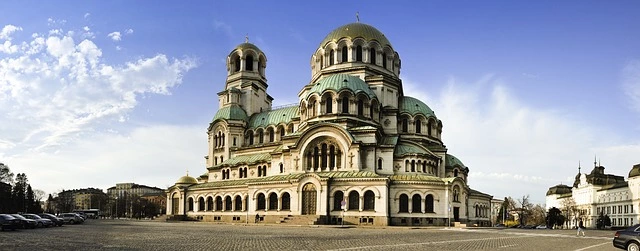
Soul-stirring mountains are rivaling sandy beaches while towns are buzzing with nightlife and art. Unforgettable experiences are guaranteed within Bulgaria’s beguiling mix of nature and culture.
Everything about this country is a win. Because it’s under the radar, you’ll find few crowds and plenty of affordable activities.
The long history of Bulgaria is visible everywhere, from ancient Neolithic settlements to enigmatic Thracian graves to fortifications left behind by influential tsars.
Also some of the smallest, most unwritten churches inside have intricate religious works of art, including portraits of saints and colorful murals.
Every summer long sandy beaches and fine weather reel vacationers join the Black Sea resorts of Bulgaria . Bulgarian inlanders are attracted helplessly to the fresh sea breeze and turquoise water miles away. International tourists are also wise towards the coast of Bulgaria, thanks to beautiful seaside resorts like Primorsko.
Only the two major towns on the coast, Varna and Burgas, have beautiful beaches just minutes from their urban cores. And while Sunny Beach, Sozopol and other favorites are thoroughly established, north and south of the major hubs are still plenty of undiscovered coves.
Bulgaria is amazing and we can’t say enough of its praises. Don’t hurry through the area. Lots of things to see and do here ! Take your moment.
This Bulgaria travel guide will help point the way by providing you with tips on what to see, prices, suggested budgets, and ways to save money.
Tourist Information
Bulgarian is the official language and the Cyrillic alphabet is used – Bulgaria is the only EU nation to use it.
BGN is the currency code for the Bulgarian lev.
Climate and Recommended Time to Visit
If you want hot weather and lots of time on the Black Sea coast, summer (from June to the end of August) is the best time to visit. Temperatures average between 27-35°C daily, and the water is ideal for swimming. Throughout the area, these temperatures are relatively consistent although mountain regions may be cooler.
The weather in Spring and Fall will vary from day to day. Temperatures range from 5 to 25°C, and are sometimes cloudy. Nevertheless, if you want less lines and lower costs, your best time to come is this. The fall months (especially September and October) are best for hiking in the cooler temperatures and as shown by the autumn foliage.
Winter can be frigid, falling temperatures as low as -5°C, bringing plenty of snowfall. At this season, the snow-capped mountains are breathtaking, and many people come over here to reach the slopes.
Bulgaria Travel Highlights
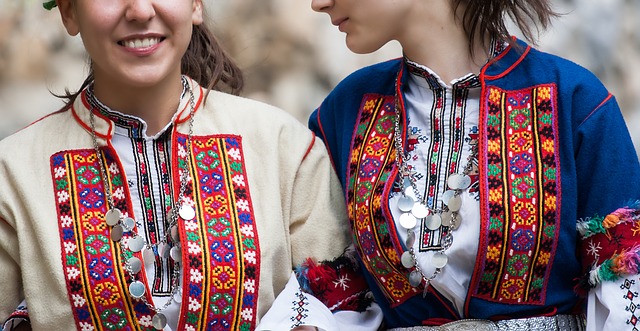
Visit Sofia
Sofia is the vibrant capital city of Bulgaria, full of museums, Eastern Orthodox churches, communist architecture and fashionable galleries, restaurants and clubs. Discover various architectural styles in Sofia, from Greek , Roman, Byzantine to Ottoman. The most famous sight is the magnificent gold-leaf domed Alexander Nevsky Cathedral.
Relax in Varna
A big seaside resort on the Black Sea coast of Bulgaria, Varna draws both sun worshipers and cultural enthusiasts. During the summer, Varna is a major tourist destination, when its beaches are filled with visitors. Roaming around the streets, visit the Roman Baths, walk through the wide central park and sit by the beach.
Explore Plovdiv
Plovdiv is Bulgaria’s second-largest city, and Europe’s oldest continuously inhabited city. Plovdiv was founded across seven hills, and boasts stunning ancient ruins. Make sure to visit the Roman Amphitheater, see the Archeological Museum, or relax in the Tsar Simeon Central Park, under the leafy trees.
Veliko Tarnovo
Visit the former museum town of Veliko Tarnovo, capital of the Second Bulgarian Empire (1185-1396), situated on three hills surrounded by the Yantra River. This includes remarkable collections of ancient art objects, including relics from churches.
Explore the Rila Mountains
Rila Monastery, credited with safeguarding Bulgarian civilization during the dark centuries under Ottoman rule, and a lightning rod for 19th century revolt, remains the most storied spiritual treasure in Bulgaria. The monastery arose out of the hut of a hermit of the 10th century; after a fire, the breathtaking mixture of elegant archways, towering domes and apocalyptic frescoes dating mainly from the 19th century today.
The Rila Mountains are the Balkans’ highest mountain range with Mount Musala towering to nearly 10,000 feet. On a day-hike, you can trek to the top, or take on some of the less challenging mountain hikes. Other highlights to explore around Rila include the Cirque of Seven Lakes, the Waterfall of Skakavitsa and the ancient Rila Monastery.
Museum of Socialist Art
The new Sofia museum displays art from the period when the country was Communist (1944-1989). A large outdoor sculpture park features everything from a massive Lenin statue that once stood in the middle of the city to the red star that surmounted the headquarters of the communist party.
Within you can find paintings for propaganda, videos for films, photo galleries and more. Admission is 6 BGN and it’s available daily from 10 am to 5:30 pm (except Mondays).
Hike the Balkan Mountains
This mountain chain is in the middle of Bulgaria, and it is part of the epic European Long Distance Route (E3) following the main ridge of the chain to the Portuguese seaside, covering a distance of 4,320 miles (6,950 km).
Choose a base town like Apriltsi and trek from there for shorter day-hikes. The summit of Mount Botev and the hike to Vodnite Dupki are two common choices.
Black Sea Coast
Bulgaria has more than 370 km of beautiful sandy beach coastline. Busy resorts include Sunny Beach and Golden Sands, picturesque Albena, historic Nesebar, Varna’s cultural and historic center, and port center Bourgas’ Mediterranean ambience.
Balchik is a tiny Black Sea coastal city. The area used to serve as Queen Marie of Romania’s summer residence. On the seaside promenade you can visit her palace and appreciate the fascinating blend of gothic and Islamic architecture.
There are not many rooms but all of them contain original Queen Marie furnishings and paintings. Currently there is a botanical garden with over 600 plant species. Admission is BGN 10.
The 3 largest resort towns in Bulgaria are Bansko, Borovets and Pamporovo. Many people like Bankso because it has the longest ski runs in its area, and it is doable as a day trip from Sofia. Otherwise there are many hotels and budget lodging inside Bankso and close to the ski lifts base (although Bankso is not the most beautiful of cities.
Bulgaria is one of the world’s largest producers of rose oil, and since 1903 the town of Kazanlak hosted the Roses Festival. The local community organizes this international event during the first weekend of June to draw thousands of tourists and guests to celebrate the rose valley.
Rose-picking activities, gatherings to learn about the method of rose distillation, a street parade, acapella choirs, folklore performances, art exhibits, displays, and even wine degustations.
Visit Varna Archaeological Museum
Varna Archeological Museum is home to the Varna Necropolis – a 7,000-year-old prehistoric archeological site that holds the world’s oldest mined gold. The gold was mined from 62 graves (at the time it was customary to bury people with gifts). You will find delicately made jewellery and other objects on display, and odds such as Roman surgical instruments and ancient Hellenistic headstones.
Explore Stara Zagora
Stara Zagora is a smaller town located in southern Bulgaria, famous for its annual linden-tree bloom (the whole town smells amazingly floral — like a mixture of honeysuckle and jasmine. Yet, the main draw is the historical value of Stara Zagora.
Apart from once being an important crossroad for the Romans, Ottomans, and Thracians, Stara Zagora still holds some impressive prehistoric artifacts, including ancient burial mounds dating back to 8,000 years. The Neolithic Dwellings Museum sits near the ruins of a house on one of these ancient mounds.
Belogradchik
Visit Belogradchik, an age-old town nestled in the foothills of the Balkan Mountains in northwestern Bulgaria, near the border with Serbia. The main attractions are the medieval Belogradchik Fortress and the Belogradchik Rocks, a marvelous expanse of bizarrely shaped, colorful rock formations named by the Bulgarian government as a natural landmark. Also deserving of diversion is the nearby Museum of History ( www.muzeibelogradchik.com ).
Trigrad Gorge
Spectacular Trigrad Gorge is situated in the Rhodope Mountains near the town of Trigrad in southern Bulgaria, flanked by 300 m (980 ft) of vertical marble rocks. It is a popular hiking, biking, birdwatching, and fishing spot.
The Devil’s Throat Cave is a popular tourist destination with water from the Trigrad River feeding massive waterfalls down its ‘throat’ before cascading down 42 m (138 ft) into the lower abyss. Nearby is the famous Haramiiska Cave, where archaeologists discovered evidence of more than 4,000 years of human habitation.
Veliko Târnovo
Bulgaria’s long history of warring tsars and epic battles in its former capital, Veliko Târnovo is extraordinarily vivid. Toped with a beautiful medieval castle, this city of Soviet temples, paved lanes and scarcely modified handicraft shops makes a unforgettable trip into the history of Bulgaria.
Home to Bulgaria’s second-largest university, the town also has a lively nightlife; a vibrant and multicultural population of expats adds to the fun. Set above the ribboning Yantra River, Emen Canyon is also a great base for local hiking, mountain biking and day trips.
Thracian Tombs
The Valley of Thracian Kings is dotted with fine tombs, between Shipka and Kazanlâk, and more are uncovered each year. Yet one of the most gorgeously preserved examples is the Unesco-listed Sveshtari Thracian Tomb in northeast Bulgaria. Within its three chambers, the tomb dates back to 300 BC and harbors lovely artwork and reliefs including 10 beautiful female figures.
The rare discovery was made in 1982 but there are few visitors. A visit needs private transport but the effort to play Tomb Raider within its evocative limits is worth the effort.
Getting Around
Inside Bulgaria there are only two domestic flights, both operated by Bulgaria Air. There is one road between Sofia and Varna and there is another between Sofia and Burgas. A one-way trip between Sofia and Varna costs about BGN 65 (US$ 37), while a one-way trip between Sofia and Burgas costs about BGN 60 (US$ 34).
The most reliable transport links between cities are by bus. Bulgaria has plenty of private and public minibuses and coaches to drive you through the smaller towns and cities and along the coast. Some of the bus companies which are most famous include:
- Biomet – With routes between Sofia and Veliko Tarnovo, and Varna and Burgas
- Etap-Grup – Runs routes between Burgas, Varna, Sofia, and Veliko Tarnovo (as well as other smaller towns in between)
- Union-Ivkoni Links – Runs between most major towns and some smaller ones
Check the schedule on the company websites, or use Busbud to research routes. Though it isn’t exhaustive, many bus and train schedules can be accessed at www.bgrazpisanie.com .
The best way to travel around Bulgaria – especially when visiting remote villages, monasteries and national parks – is to hire a car or motorbike. The Union of Bulgarian Motorists is the main national organisation for motorists, though little information is available in English.
You will need to purchase and display a highway toll sticker – a ‘vignette’ – on the passenger (right-side) windscreen of the car before you can drive on motorways. While within Bulgaria, vignettes can be purchased at border crossings when entering the country for the first time, or at post offices and large gas stations. Inside Bulgaria rental cars should already have a vignette.
To rent a car in Bulgaria you must be at least 21 years of age and have had a licence for at least year. Rental outlets can be found all over Bulgaria, but are most common in the bigger cities, at airports, and at Black Sea resorts.
Taxi & Ridesharing
In addition to short journeys within cities, hiring a local driver is a decent way to hit day-trip destinations without the hassle of unusual buses; make sure to decide on a fare before setting off.
Train travel in Bulgaria is often cheaper than taking the bus, but a lot slower. You can use the Bulgarian State Railways website to plan your trip.
The Bulgarian State Railways has more than 4,000 kilometres of tracks throughout the country, linking the most important cities and towns, although some are on a spur track and are only linked by rare services to the main railway line.
Most trains tend to be old, shabby and not especially comfortable, and travel times are usually slower than buses. At the other side it is possible that the scenery will be more satisfying.
Two of the most scenic train journeys are along Iskâr Gorge, from Sofia to Mezdra, and along the narrow-gage line between Septembervri and Bansko. Railway enthusiasts sometimes go on such trips for no other reason than the travel itself.
The only domestic sea transport in Bulgaria consists of a seasonal service between tourist towns on the Black Sea Coast. During the summer months the high-speed Fast Ferry operates from Nesebâr’s passenger ferry port to Sozopol and Pomorie.
Best Hotels In Bulgaria
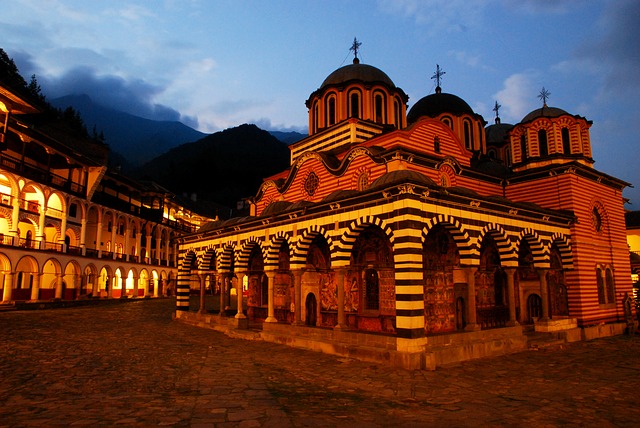
Rosslyn Dimyat Hotel Varna
With a central location and next to the Sea Garden, the Rosslyn Dimyat Hotel Varna is perfect for making the most of your stay in Varna, whether on a business trip, a city break or a long stay.
The hotel offers 95 elegant, lively, and very spacious rooms and suites, complete with all the facilities for a special seafront stay. Most rooms provide a panoramic view of the sea garden and Varna Bay.
Additional services include a restaurant, lobby bar with a wide terrace, six conference rooms and a ballroom. Guests can also enjoy a gym, a thermal zone, a range of treatments and a swimming pool at the Maya Vita centre.
Rosslyn Thracia Hotel Sofia
Perfectly situated on a quiet street in the heart of Sofia, the Rosslyn Thracia Hotel welcomes you to explore Bulgaria’s capital’s most stunning historical and cultural sites, as well as the vibrant restaurants and cafes only a few steps away.
Rosslyn Thracia Hotel provides luxurious and fashionable accommodation with a range of facilities complemented by super breakfast and genuine hospitality.
The hotel is within easy reach from Sofia airport.
Personal valet underground car park, meeting facilities and a business center are accessible on site. The lobby bar’s green terrace provides a relaxed and calming ambience for a morning coffee or evening cocktail!
InterContinental Sofia
At the top of every Bulgaria resorts guide stands The InterContinental Sofia is the largest luxury hotel in the capital, overlooking Narodno Sabranie Square and offering breathtaking views of Alexandar Nevski Cathedral. This iconic location will give you a veritable sense of the destination. Relax in one of the spacious rooms before dining at the Floret Restaurant and Bar for an unforgettable meal.
Hotel Arte SPA & Park
Located at the foot of the forest, Arte Spa&Park Hotel embraces a view of the wilderness as well as beautiful nature. The region is characterized by heavily ionised fresh air. With its catchy alpine styling and architectural beauty the hotel can captivate your gaze. In your senses the serenity and peacefulness will prevail to bathe you in comfort and luxury.
Hotel Priyateli provides pet-friendly accommodation in Veliko Trrnovo with free Wi-Fi and a barbecue.
The rooms come with a TV. Some units have a seating area to unwind after a busy day. Other rooms have a terrace or balcony.
The property boasts a 24-hour front desk.
Tryavna is 26 km from the Priyateli Hotel, and 3.5 km from Arbanasi.
Kempinski Hotel Grand Arena
Discover the beauty of unspoiled nature, magnificent landscapes and endless relaxation at the footsteps of the majestic Pirin Mountain – a UNESCO World Heritage environment.
As soon as you set foot in the hotel, you will be surrounded by a caring ambiance created with the genuine desire to make you feel most welcome.
International Hotel Casino & Tower Suites
The newly renovated, 5-star INTERNATIONAL Hotel Casino & Tower Suites is located just meters from Golden Sands beach, Bulgaria and 17 km from the city center of Varna. The property offers a combination of 325 deluxe rooms and superior suites with breathtaking views of the park and the sea.
Guests can enjoy our extensive Spa services, 24-hour Casino Access and Entertainment, dedicated Concierge Team, Shopping Center, Children’s Club, Wi-Fi and complimentary Car Parking facilities, guaranteed to make your stay amazing and memorable one. Enjoy the All Inclusive package which includes 24/7 drinks.
Best Restaurants In Bulgaria
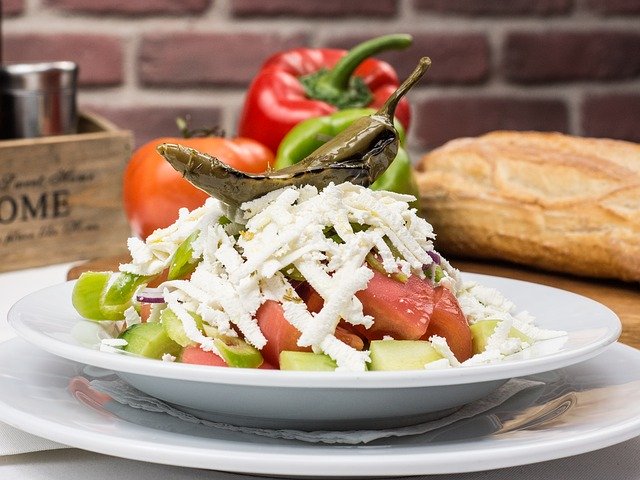
Skapto started in 2013 with a simple idea in mind – comfort. To make you feel comfortable; to transport you into a state of physical & soulful ease. Pure, stripped of anything unnecessary, of anything pretentious. Ease.
“We are Skapto. We do burgers, we do beers, we do buddies. We do comfort just right. Nothing generic, nothing lame.”
For the celestial food made especially for you at the restaurant, you can rely on a whole universe of flavors, positive energies and a lot of inspiration coming to you. Across time and space, the Cosmic team flies to collect moments of vivid emotions and turn them into culinary delight for the senses and soul-touching experience for food lovers.
The goal has been to delight guests with fantastic culinary experiences for 10 years now, and get them out of the everyday routine.
Once you’ve come to one of their restaurants, you know you’re in a special location! Incanto is a taste-and-feel compilation. Food for the soul that memorably makes every meal! You are intrigued by the setting, the good music and the attitude and you fall in love!
You’ll find over 100 world cuisine dishes in our menu for every mood, occasion and lifestyle! Balanced between yummy and safe. Their love for you is reflected in the product’s high quality and attention to every dish prepared on the spot.
In the city centre, on a quiet street near the Roman Odeon. The bohemian décor mixes beauty and comfort that blends in with the old bookshelves in some way. During summer, the tiny tables on the pavement remind you of the comfort of Parisian cafés and bistros.
The scent of delicious food and freshly baked bread floating in the air draw you in for a glass of wine. And the customer feels at home, and is always coming back for more.
They have taken care of providing diverse menus for lunch and dinner, the wine list is a collection of classy Bulgarian and imported wines and they aim to maintain a high standard of service. Because Hemingway BBQ Bar & Grill is the place to be, whether you want to grab a bite or have fun with colleagues and friends.
How to Stay Safe in Bulgaria
As you read in our Bulgaria travel tips, this is a very safe country. Scams and small-scale crime such as pick-pocketing are the most common danger that you face when you’re traveling the country. Taxi drivers are usually scammed to tell you their meter is broken. Insist on getting a taxi with a working meter, or negotiating the cost up front.
If you take one thing from this Bulgaria travel guide it should be that you need to buy good travel insurance. This is the most valuable piece of advice we can give you. Travel insurance will guard you against disease , injury, theft and cancellations. In case something goes wrong it’s extensive security. For it I never go on a bus, because I had to use it several times in the past.
Our articles may contain affiliate links. We may get paid a small commission when you use our links with no additional cost of your part! See our Privacy Policy page for more details.
You will be redirected to your dashboard shortly. We will also call you back in 24 hrs .
- 21 Beautiful Places To Visit In Bulgaria In 2024 That Are A Treat To Your Eyes
23 Mar 2023
Bulgaria is a country with picturesque landscapes, along the coast of Black Sea. With mountains and rivers on one side and sun-kissed beaches and azure sea on the other, Bulgaria boasts of beautiful cities and resort towns, which fascinate each and every traveler with their own charm and aura. From castles to forts, museums to amusement parks; there are innumerable places to visit in Bulgaria. Make sure to check them out on your trip to Bulgaria for an exquisite time with your family and friends.
Places To Visit In Bulgaria
Bulgaria is adorned with many spectacular places. To make up for an exciting holiday, you must cover most of these beautiful places to visit in Bulgaria that we have listed below:
- Rila Monastery
- Veliko Tarnovo
- Koprivshtitsa
- Sunny Beach
- Belogradchik
- Pobiti Kamani
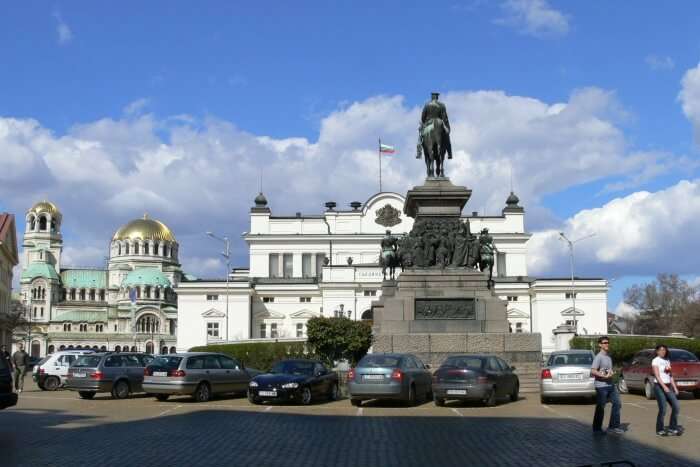
Image Source Sofia, the capital city, is one of the most gorgeous top places to visit in Bulgaria . There are various places to visit in Bulgaria, Sofia . Presenting a flawless amalgamation of old city and modern township, Sofia is home to 2000 years old churches, municipal buildings, and cathedrals on one hand and modern museums, art galleries, city parks and boulevards on the other. Nestled at the foothill of Vitosha mountain, this largest Bulgaria city is flocked by tourists around the year.
Must see: Boyana church, Alexander Nevsky Cathedral, Ivan Vazov National Theatre, Saint Nedelja Church and National Museum of Military History and South Park
Suggested Read: 7 Days In Spain: Witness The Splendid Sceneries Of The Second Largest European Country!
Europe Holiday Packages On TravelTriangle
Explore the most beautiful places to visit in Europe, from Paris to the Venice canals and from the Greek islands to the Swiss alps. Book customized packages by expert agents on TravelTriangle. Inclusive of airport transfers, cab, resort, sightseeing and meals. Best holiday experience Guaranteed. Book Now

Magnificent Switzerland Holiday 6D/5N Package @ Rs 69,999
Plan your trip today!

Magnificent Europe Tour 7D/6N Package @ Rs 70,975
Get quotes from multiple travel experts.
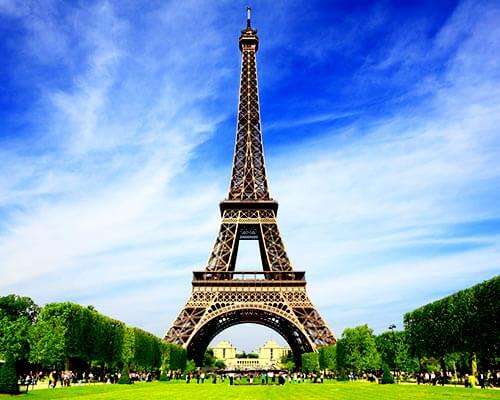
France & Switzerland Tour Package 8D/7N @ Rs 90,000
Compare & customize quotes before booking.
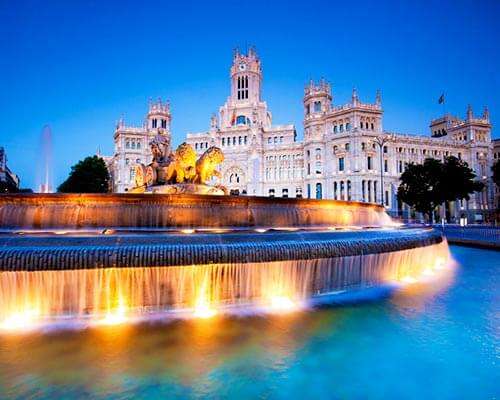
Scintillating Spain & Portugal Tour 11D/10N @ Rs 101,150
Have Questions? Talk to our travel experts today.
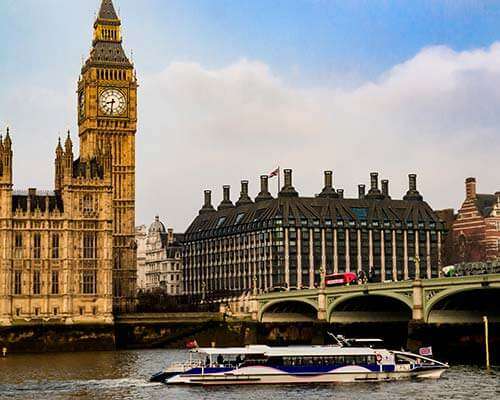
6 Country Europe Tour Package 12D/11N @ Rs 118,650
Best prices guaranteed. EMI option available.

See more at TRAVELTRIANGLE.COM
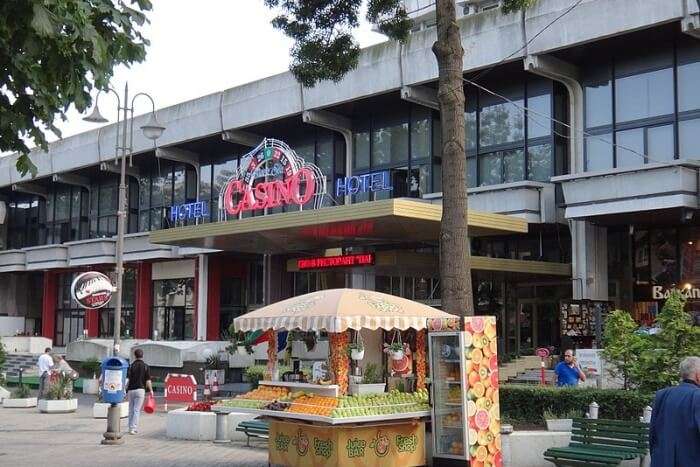
Image Source Overlooking the Black Sea, Varna is one of the significant places to see in Bulgaria. Showcasing history and heritage of the bygone era, this serene resort town comprises of Roman baths, ancient cathedrals, and museums. Varna beaches are vibrant and happening and lined with shacks and bars, where people can hang out, sunbathe and unwind and indulge in water sports.
Must see: Roman Bath, Dormition of the Mother of God Cathedral, Baroque Opera House and Cathedral of the Assumption of the Virgin
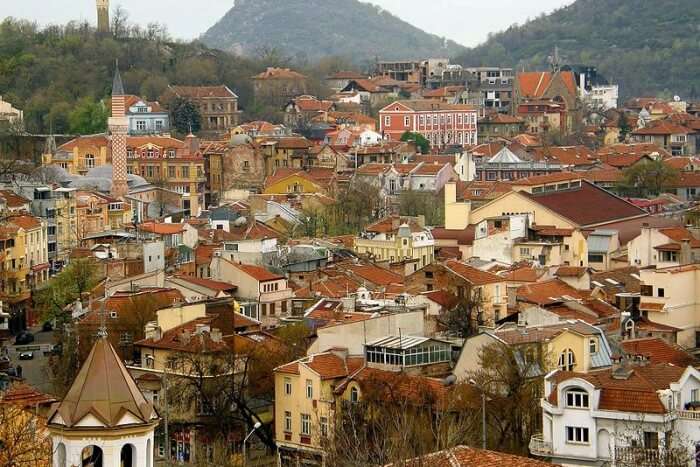
Image Source As one of the historical cities in Bulgaria, Plovdiv is mostly visited by history lovers and anthropologists. This is one of the ancient Bulgaria places, built around 7 hills, along with the course of Maritsa River. Featuring fortresses, amphitheaters, churches, cobbled stone roads, and vintage houses; Plovdiv offers utmost holiday charm, like none other.
Must see: Plovdiv Roman stadium, Roman amphitheater, Staria grad, Park Tsra Simeon and Alyosha Soviet Army Memorial and Ethnographic Museum
Suggested Read: Paragliding In Austria: Head To These Amazing Destinations In The Heart Of Europe!
4. Rila Monastery
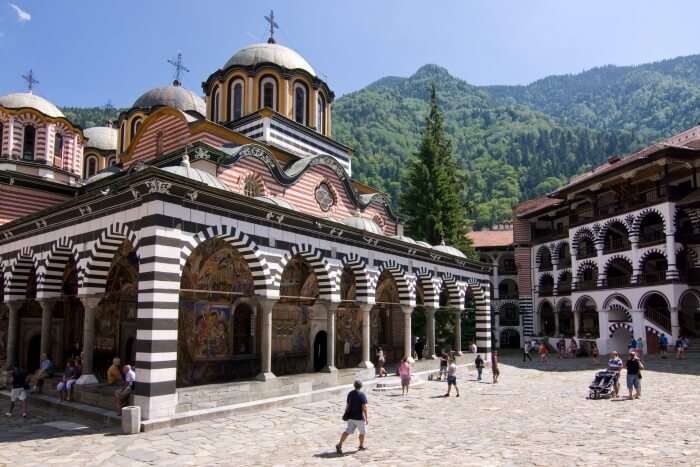
Image Source Nestled amid Rila Mountains; this is the largest monastery in Bulgaria. Much famed as Monastery of Saint Ivan of Rila, this is the most popular Eastern Orthodox Monastery and one of the top tourist attractions in Bulgaria. Founded in the 10th century by St. John of Rila- this stunning monastery is visited by thousands of pilgrims every year. This UNESCO World Heritage Site is built in Mamluk, arabesque, Byzantine and Romanesque pattern. It looks stunning and magnificent with the wooden staircases, black and white arches, domes and colorful mosaics, while the 250 well-preserved manuscripts and paintings are things to admire.
Must see: Other than the monastery and its in-house museum and gallery, one can also explore Rila National Park, Rila Mountains, and Medi Valley Winery
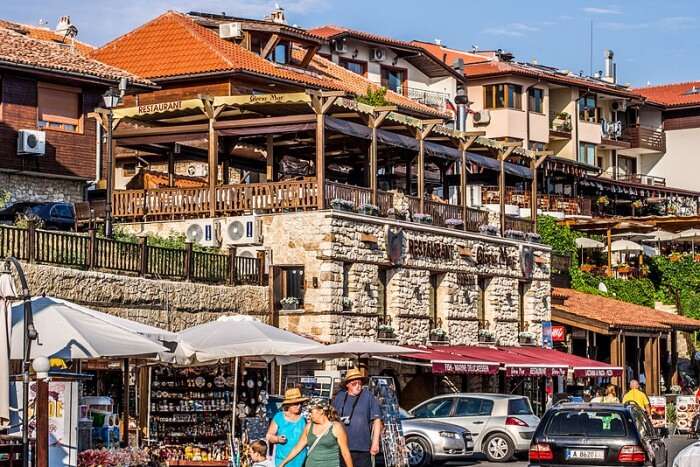
Image Source Next in the list of best places to visit in Bulgaria in summer is Nesebar. This is another pretty town, located by the Black Sea coast, known for its ancient ruins, edifices, and stunning beaches. The old part of Nessebar, comprising of Byzantine-era fortifications and Roman baths are located on an island, which is bridged with the mainland by a man-made walk away. You can also visit the famous 11th century St. Stephen church, located there, which houses an ornamented altarpiece and many of mural paintings. Apart from this, one can sunbathe on the beaches, enjoy water sports and relish seafood or spend some crazy fun-filled moments at the beachfront water park.
Must see: St. Stephens Church, Winery Messembria, Church of Saint Sophia, Church of the Holy Archangels Michael and Gabriel, Aquapark
Suggested Read: Museums In Austria: 8 Amazing Storehouse Of History And Art In The Heart Of Europe
6. Veliko Tarnovo

Image Source Renowned as ‘city of Tsars’, Veliko Tarnovo is a small and quaint city in central Bulgaria. This is a 7000 years old town, located by the Yantra River and surrounded by three hills, namely; Tsaravets, Trapezitsa, and Sveta Gora. Veliko Tarnovo was once the capital of the second Bulgarian empire. As a fortified city, the place is walled on all sides and offers superb panoramic views of the surrounding. With more than 30 monasteries, cobblestone streets, mythical homes, and churches; Veliko Tarnovo looks surreal and a visit to this place during Bulgaria holiday is worth in every sense.
Must see: Tsaravets Fortress, Monastery of the Holy Transfiguration of God, Forty Martyrs Church and Asen’s Monument
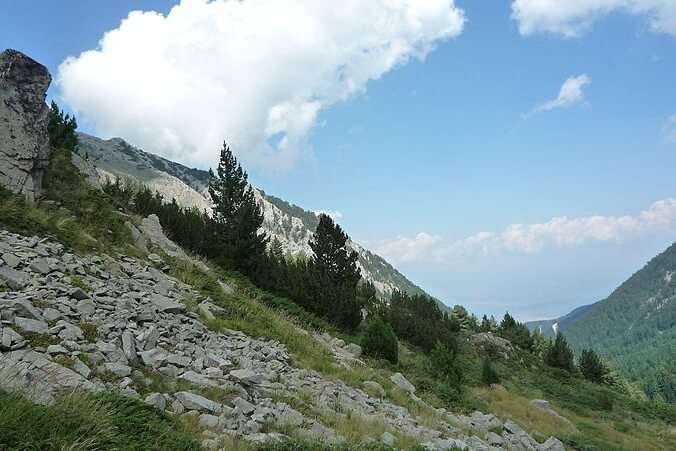
Image Source Bansko is the most buzzing skiing destination of Bulgaria and one of the best places to visit in Bulgaria in winter. Nestled at the foothills of Pirin Mountains, Bansko welcomes all winter sports lover with wide arms. One among the must-see Bulgaria places; this ski resort town boasts of numerous ski and snowboard areas on Todorka Peak like Tomba Run and offers longest skiing season in Bulgaria. Apart from this, Bansko is also famous for ski restaurants, nightlife, and spa and hosts the Bansko Jazz Festival every year.
Must see: Vihren Peak, Todorka, Kutelo, and Bansko Gondola Ski lift
Suggested Read: Sweden In March: 10 Eye-Catchingly Beautiful Places To Visit In Europe’s Svedala
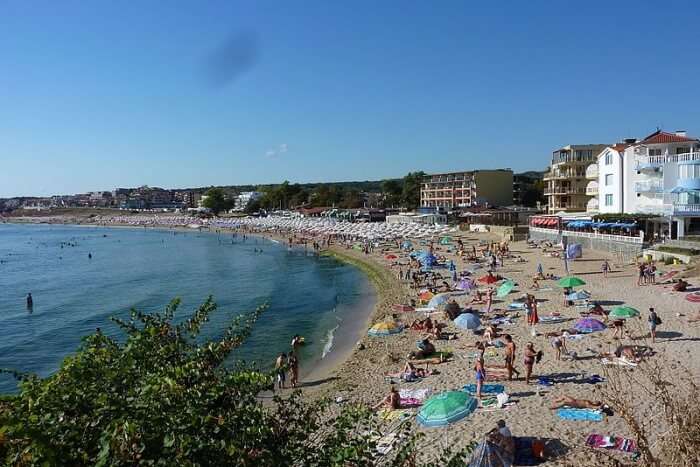
Image Source One of the ancient coastal towns to see in Bulgaria; Sozopol exhibits relics and remnants of the Bronze Age. Perched at the Black Sea coast; there is an ancient fortress overlooking the sea and archaeological evidence of a sprawling Christian complex. Best known for splendid beaches and nightlife; Sozopol attracts travelers of all kinds, throughout the year. It is one of the significant cultural centers of Bulgaria and hosts Apollonia Art and Film Festival every year.
Must see: St. Thomas Island, St. Ivan Island and The Castle of Ravadinovo
9. Koprivshtitsa

Image Source Colorful houses, cobblestone streets, buzzing public squares and markets pretty much sum up what you can experience at Koprivshtitsa- one among the popular tourist places in Bulgaria. With the backdrop of Sredna Gora mountains; this historic town is perfectly set on the banks of Topolnita River and is famous for its folk festivals and carnivals.
Must see: Oslekov House, Topalova House, Dimcho Debelyanov House, and Lyuben Karavelov Museum
Suggested Read: 17 Spots For Snorkeling In Europe Every Underwater Enthusiast Must Visit

Image Source Bordered by sea and several lakes, Burgas is another name in the group of best places to visit in Bulgaria . Though this is an industrial city but the beaches, restaurant and shacks remain crowded with tourists and locals. During summer, the main promenade hosts summer theatre performances, which enhance the charm of the place, manifold.
Must see: Church of Saint Cyril, Sea Garden, Lake Burgas, Lake Atanasovsko and St. Anastasia Island
11. Sunny Beach

Image Source The discussion on places to visit in Bulgaria is half-hearted if you do not include Sunny Beach in it. Adorned with nightclubs, beach shacks, restaurants and water sports; Sunny Beach allures and tempts, travelers of all kinds. The beaches look dazzling and vibrant with loungers, umbrellas, yachts, go-cart track and water park.
Must see: Action Aquapark, Winery Messembria, Sunny Beach Luna Park and karting track
Suggested Read: Bulgaria In Winter: 10 Things To Do To Make Your Vacation Memorable
12. Belogradchik
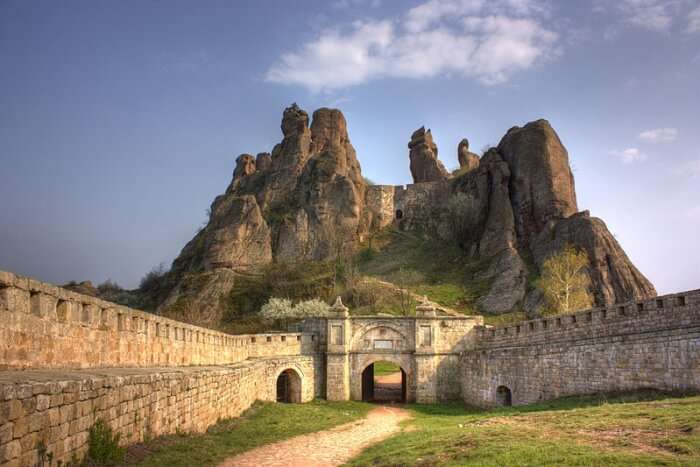
Image Source Located on the northern slopes of Balkan Mountains, Belogradchik is another place to see in Bulgaria. Also known as Kaleto, this place is famous for unique sandstone and limestone rock formations, monoliths and hoodoos. Certainly, a place to wonder, Belogradchik also has an ancient fort, caves, and museums.
Must see: Magura Cave, Baba Vida, Kaleto Fortress and Belogradchik rocks, Museum of Nature and Science
13. Pamporovo

Image Source Another popular ski resort in Bulgaria, Pamporovo is set on the foothills of Rhodope Mountains. Lined with pine forests, the skiing area looks surreal and leaves everyone in awe. One can indulge in skiing and snowboarding during winter months, while summer is ideal for hiking and camping. Make sure you book a spot for skiing. We promise it will be worth the time and money.
Must see: Pamporovo Ski resort, Spree Skiing School and Fun Park.
Suggested Read: Top 12 Bulgarian Restaurants That Will Leave You Spoilt For Choice
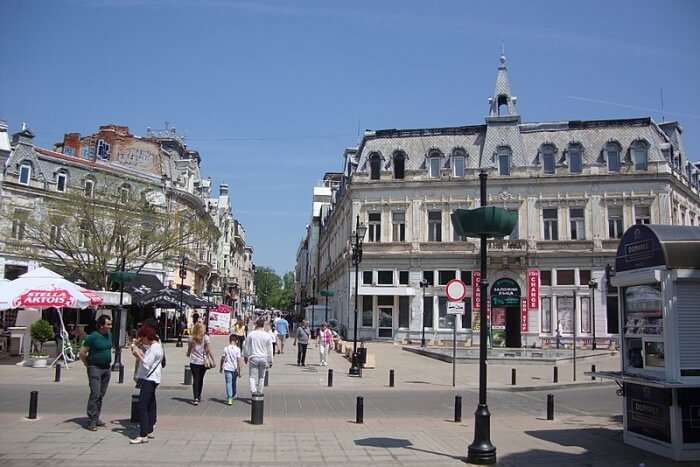
Image Source Nestled on the right bank of Danube; Ruse is an important river port and a quaint Bulgarian city. Housing more than 300 Neo-Baroque and Neo-Rococo buildings, Ruse is also described as ‘Little Vienna’. This is the only place to visit in Bulgaria, that comprises of Bulgarian-Romanian bridge, known as Ruse-Giurgiu Friendship Bridge.
Must see: Svoboda- Liberty Square, Profit-Yielding Building, Friendship Bridge, Freedom Square, Sveta Troitsa Cathedral, Eco Museum, and Orlova Chuka Cave
15. Hisarya
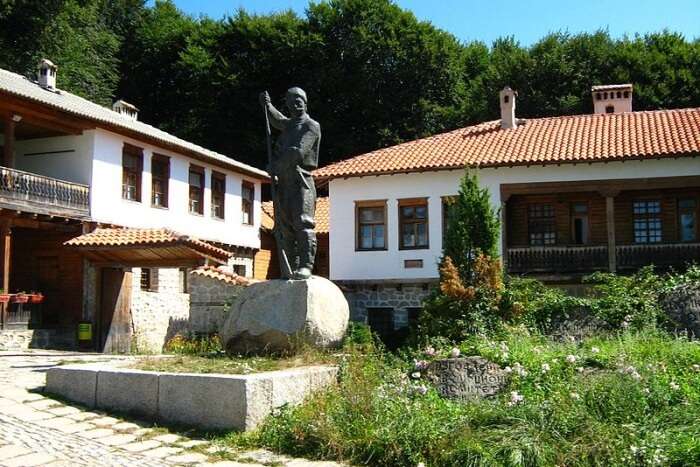
Image Source Hisarya lies at the edge of Sredna Gora mountain range and best known for relics of Roman walls, gates, baths, and theatres. The name was derived from the word Turkish word Hissar or Hisar- which means Fort or Castle. It is located at a distance of 44 kms from Plovdiv, hence can make up for a great day trip option.
Must see: Thracian temple, Mineral Spring Momina Banya and Horseback Riding Camp Ezdun
16. Arbanasi

Image Source Arbanasi is a quaint village perched on a hill about 5 kilometers away from Veliko Tarnovo. Besides the amazing views of Veliko Tarnovo and Tsarevets, the village also offers a plethora of streets and old houses surrounded by high National Revival style buildings. It is one of the oldest places to visit in Bulgaria among the locals. Make sure to stop by here.
Must see: Nativity Church and Konstantsalieva House
17. Pobiti Kamani
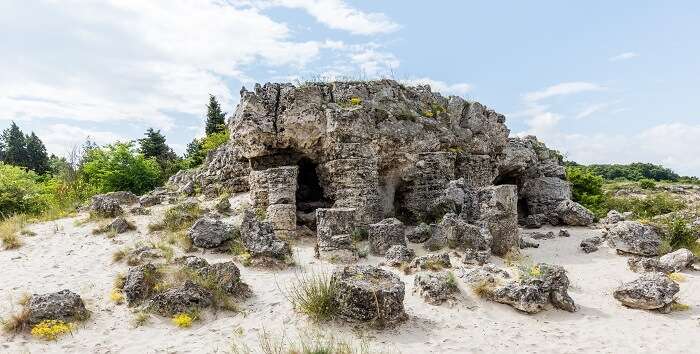
Image Source Bulgaria’s only desert, Pobiti Kamani is one of the most fascinating places to visit in this country. It is located 20 km west to varna and is home to a variety of flora and fauna. The sand dunes and rock formations that goes up to 7 m high in this desert are fascinating. Guess what, these rock formations are hollow from inside and looks as if they are stuck in the sand.
Must see: The Stone Forest, Quarry in Beloslav, Bulgarian Black Sea Coast
18. Kaliakra
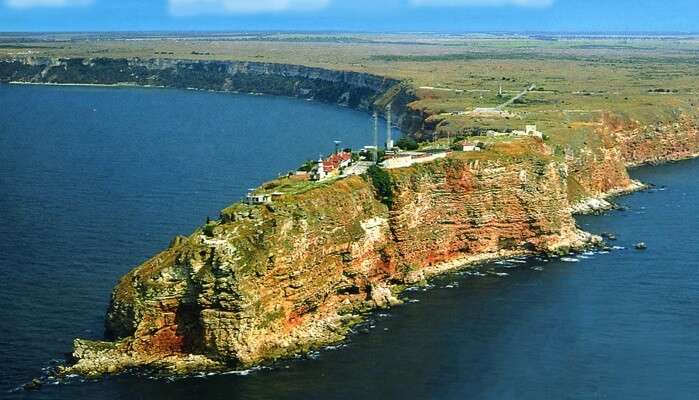
Image Source If you are wandering along the Black Sea Coast in Bulgaria, you will come across Kaliakra, one of the historical places to visit in Bulgaria . The legend has it that forty people jumped from the cliff with their hair tied together. They thought that it was a better option than being captured by the Ottomans in the 14th century. The medieval fortress against the stunning backdrop will take your breath away.
Must see: Cape Kaliakra, Castello di Kaliakra
19. Balchik

Image Source One of the most popular places to visit in Bulgaria for families , Balchik is absolutely worth the visit. This small town is located near the northern part of Black Sea Coast in Bulgaria. It has so many places to visit like the summer residence of Romanian Queen Marie of Edinburgh and the famous botanical gardens.
Must See: The Palace of Balchik, Botanical gardens, Balchik Beach
20. Kazanlak

Image Source Also known as the ‘Valley of Roses’, Kazanlak is an attractive tourist destination in Bulgaria where you will find tombstones of Thracian kings. It is one of the UNESCO World Heritage Site in Bulgaria which is why it must be on your list of all the places to visit.
Must See: Museum of Roses, Thracian Tomb of Kazanlak, Koprinka Dam, Tomb of Tsar Setv
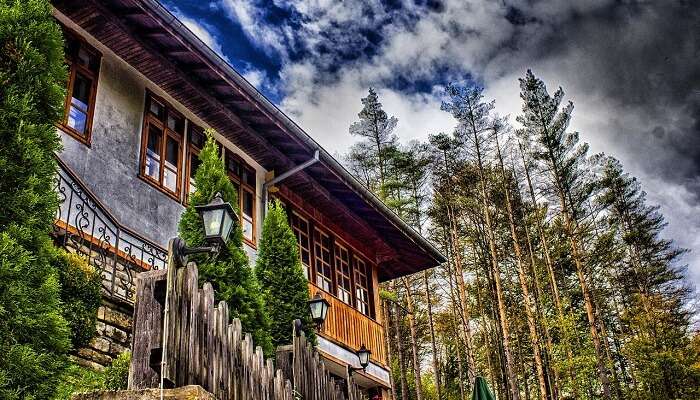
Image Source An open-air museum in Bulgaria, Etara is a one-of-its-kind place that you ought to visit on your holiday. It is located on the northern edge of the Bulgarka Nature Park and has Bulgarian customs, craftsmanship, and culture on display. You will also find numerous restaurants outside the museum where you can taste the finest Bulgarian cuisine.
Must see: Karadzica water-mill, Sokolski monastery
Further Read: 13 Frolicsome Beaches In Europe For All The Excited Beach Bums Across The Globe
With this list of popular places, now you can plan a foolproof trip to Europe . Ensure you cover most of these places to visit in Bulgaria and have a memorable trip that you will cherish forever. We promise that you’ll have the time of your life and will not be disappointed by everything that Bulgaria has to offer you.
Frequently Asked Questions About Places To Visit In Bulgaria
Is Bulgaria an expensive country?
Bulgaria is an affordable destination as compared to other European countries. Accommodation and travel costs here are quite affordable and ideal to plan a budget trip.
Is Bulgaria safe for tourists?
Yes, Bulgaria is a safe country for tourists. The crime rate here is very low and tourists can easily travel around without worrying about a robbery or any crime.
Is it safe to visit Bulgaria, given the covid situation?
Yes, it is safe to visit Bulgaria given that you follow all guidelines and take all the necessary precautions. Make sure to get yourself vaccinated before planning a trip, also wear masks at all times, maintain social distance at public places and sanitize your hands regularly to avoid the spread of the virus.
Why is Bulgaria so famous?
Bulgaria is famous worldwide for its folklore, opera singers and musicians. It is also home to many great sightseeing points and attractions.

Trip to Sri Lanka at Rs 13,500/-
Plan Your Vacation Today!

Trip to Singapore at Rs 20,499/-
Get Quotes From Local Experts

Mauritius Holiday Starting at Rs 65,000/-
Talk to Our Experts Today

Maldives Honeymoon Trip at Rs 39,800/-
Pay with easy EMI Option

Europe Trip at Rs 89,999/-
All Inclusive Deals

Vacation in Dubai at Rs 27,499/-

Hong Kong Holiday at Rs 24,999/-
Money Safe Guarantee

Thailand Holiday at Rs 7,999/-
Flights Excluded
People Also Read
Places To Visit In Belgium Places To Visit In Cyprus Places To Visit In Turkey
Recent Posts

Discover The 6 Most Offbeat Places In Ladakh That Will Leave You Awestruck
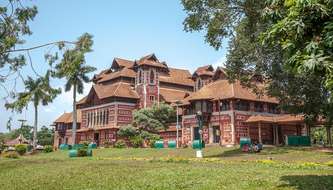
Kochi To Trivandrum Road Trip – A Journey Through Stunning Views

Munnar To Thekkady Road Trip: Adventure Calling!
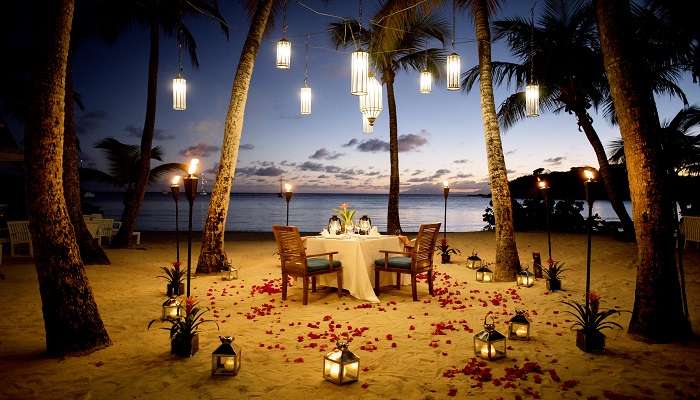
Romantic Resorts In Bali To Embrace Love For Couples

Lakes In Vietnam: A Gateway To Serene Retreats
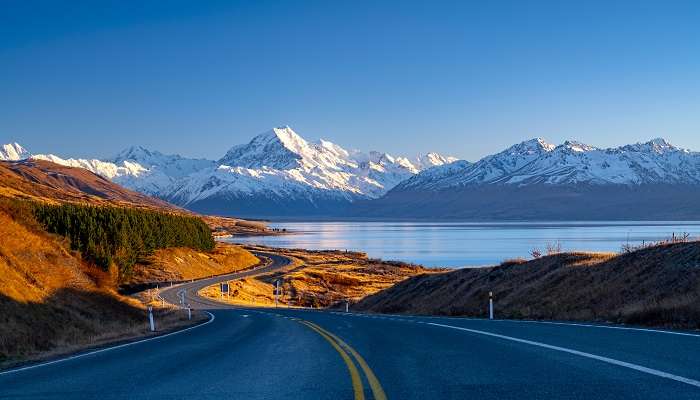
Famous Landmarks In New Zealand – A Journey Through Time And Culture
Trending Blogs

20 Mysterious Places In India To Visit In 2023 More Bizarre Than The Bermuda Triangle

10 Scariest Roads In India That Are A Driver’s Nightmare

101 Places To Visit In India Before You Turn 30 in 2024

35 Exotic Places To Visit In December In India 2024 To Enjoy A Surreal Vacation

60 Best Honeymoon Destinations In India In 2024

95 Best Honeymoon Destinations In The World In 2023 For A Romantic Escape!
Best Places To Visit In India By Month
Best places to visit outside india by month.
- TravelTriangle
- International
- Places To Visit »
- Tour Packages
- Honeymoon Packages
- Family Packages
- Budget Tour Packages
- Luxury Tour Packages
- Adventure Tour Packages
- Group Tour Packages
- Maldives Tour Packages
- Bali Tour Packages
- Dubai Tour Packages
- Singapore Tour Packages
- Thailand Tour Packages
- Europe Tour Packages
- Sri Lanka Tour Packages
- Tour Packages From Delhi
- Tour Packages From Mumbai
- Tour Packages From Bangalore
- Tour Packages From Chennai
- Tour Packages From Kolkata
- Tour Packages From Hyderabad
- Tour Packages From Ahmedabad
- Thailand Tourism
- Bali Tourism
- Singapore Tourism
- Maldives Tourism
- Mauritius Tourism
- Dubai Tourism
- Europe Tourism
- Hotels in Thailand
- Hotels in Maldives
- Hotels in Mauritius
- Hotels in Bali
- Hotels in Dubai
- Hotels in Singapore
- Hotels in Sri Lanka

- Destination Guides
Bulgaria Travel Guide | Itineraries and Highlights
Personally, I love traveling to Europe . Whether for history, architecture or gastronomy, it’s always a safe bet. This summer, I was looking for an affordable destination to spend ten days or so, and my choice fell on Bulgaria . Little known to Quebecers, it has a lot to offer. I’ll guide you through this land of mountains, seashores, ancient monasteries and picturesque villages.
Travel to Bulgaria - Get there with the stand-alone connection trick
There is no direct connection between Montreal and Sofia, the Bulgarian capital. As the destination is not very popular with Quebecers, flights are expensive and involve stopovers. When I did my research for September, I found prices around $1800 with one stopover or $1600 with multiple stopovers.
It’s always possible to use credit card points or Aeroplan points to cover the costs, but if you’re saving your points for another project or haven’t yet accumulated enough, there’s another option. I chose the trick of stand-alone connection . The trick is quite simple: you search for the cheapest ticket to Europe in a search engine and then search again from that destination to your chosen vacation destination. So we have two reservations that are not linked together.
How to do this? On the big flight comparison sites, you can enter “Europe” or “World” in the search bar. You then choose the cheapest option, which is usually Paris or London for departures from Montreal.
In my case, I found a round-trip flight to Paris for $795. From Paris, I then booked a round trip to Sofia at $250 via Munich. A total of $1,045 , a nice saving considering the initial price of $1,600. What’s more, the reservations were among my eligible expenses to apply the $100 travel credit , which comes annually with my ® Mastercard ® " href="https://milesopedia.com/en/go/hsbc-world-elite-mastercard-qc/" rel="noindex">HSBC World Elite MD Mastercard MD . I was therefore able to bring the cost of the ticket under the $1,000 mark.
Since we had to make a stopover anyway, we might as well choose a destination we like and decide how long we want it to be. However, you should allow plenty of time between bookings, because since they are not linked, the airline is not obliged to rebook you on another flight if you miss your connection. So it’s wise to spend the day or night on site to avoid stress. Warning: major cities have several airports, so check airport codes before booking to avoid having to make transfers.
Thanks to the National Bank’s World Elite Mastercard ® , I was also able to take advantage of the National Bank’s lounge with my guest at no extra charge when we left Montreal.
Then, as I was traveling on an economy flight in Europe, the baggage allowance was only 7kg per person. So I used my $150 annual travel credit to reimburse the cost of checked baggage.
Travel in Bulgaria - Getting around
To get around between the major cities, there’s a bus and train network service. It is also possible to pay for day tours from Sofia. However, if you’re comfortable driving a manual vehicle, I suggest you rent a car . Prices are ridiculously low and infrastructure is in good condition. For example, it cost us $85 for an 8-day rental, including liability insurance and unlimited mileage.
By paying for the booking with a travel credit card like the ® Mastercard ® " href="https://milesopedia.com/en/go/hsbc-world-elite-mastercard-qc/" rel="noindex">HSBC World Elite ® Mastercard ® , you’re covered for damage and collision. Simply refuse the rental company’s insurance. What’s more, to avoid paying unnecessary conversion fees when spending abroad, the ® Mastercard ® " href="https://milesopedia.com/en/go/hsbc-world-elite-mastercard-qc/" rel="noindex">HSBC World Elite ® Mastercard ® is the perfect ally to accompany you.
The Bulgarian toll road system works by scanning the number plate. Afterwards, the user must go to the service station and pay the bill. However, we found it convenient to pay a fixed price for the road tax sticker, so we didn’t have to worry about it. This option was available at the rental center.
When it comes to parking, only Sofia will cause you headaches, as on-street parking is limited to 2 hours during the day, and must be paid for by text message and then charged to the phone account. However, it is impossible to pay with a prepaid SIM card. You will then need to use the 24h parking.
Things to do in Bulgaria
In winter, it’s ski tourism that draws people to the country.
With over 600 thermal springs scattered across the country, it’s a great place to relax after sport, whatever the season.
In summer, the coastline is swamped with tourists from Russia and Western Europe. Several seaside resorts have sprung up along the coast, and there’s no shortage of activities for the whole family. In the west of the country, the mountains attract hikers and other mountain sports enthusiasts.
70% of rosewater is produced in Bulgaria. So, if you go there in spring, you’ll see the rose fields in bloom and can visit a rosewater distillery to learn about the making of this product.
What’s more, Bulgaria’s wine production is second to none in terms of quality. Each region cultivates its own typical grape varieties, and it’s a pleasure to discover them, and to move away from the traditional grapes that are found internationally.
In terms of historical sites, you can visit numerous monasteries , museum villages and ancient ruins .
Travel in Bulgaria - The country's cities :
Chances are you won’t be spending most of your trip here. The austere Bulgarian capital is a good starting point for refueling before hitting the road. In just a few hours, you’ll surely have covered all the main attractions, which are all within walking distance. The Free Sofia Tour is a good option for seeing the city’s points of interest, accompanied by explanations and anecdotes about the country.
I can’t leave out the gastronomic experience at Secret by Chef Petrov . If there was only one thing I could recommend, it would be this. Just a dozen guests a night, a 22-course tasting menu, and nothing less than a three-hour culinary show, packed with stories of ancient cooking techniques and molecular cooking experiments hosted by the chef himself.
If you’re only here for 2-3 days, you can reach the Rila Monastery from Sofia by public transport or with a tour operator. Perched in the mountains, it’s the country’s number-one attraction. Another popular day tour is the magnificent Seven Lakes Hike .
Often referred to as the country’s most beautiful city, Plovdiv is a must-see . Take a stroll through the old town, or marvel at the colorful buildings of its bustling downtown. Even on a Monday evening, the terraces were full. You’ll also appreciate the green parks and hills that give you a view of the city. There are several vineyards around Plovdiv.
As Bulgaria’s smallest village, it is known not only for its wine production , but also for the extraordinary landscape of rock and sand formations that surround it. The center is within walking distance, and is full of restaurants and B&Bs. You can go hiking in the Melnik pyramids , or visit historic houses.
A ski village that turns into an outdoor base for hikers storming the Pirin National Park . The popular ascent of Mount Vihren is accessible from Bansko, as is the spectacular traverse of the rocky Koncheto ridge. There are trails for all levels, suitable for family outings and thrill-seekers alike. To reward yourself after the effort, end the day in one of the many thermal baths in the nearby village of Banya .
The country’s second-largest city, Varna sits enthroned on the Black Sea coast. A university town , it is lively beyond the summer season. From culture to magnificent monuments, offering beaches right in the city center, this is a destination that can’t disappoint. Move away from its center if you prefer quieter beaches and apartments with sea views at ridiculously low prices. It’s the perfect place to go out and find a good little café or quality restaurant after spending the day relaxing on the beach.
For nearby excursions, stop off at the Petrified Forest to observe 50-million-year-old rock columns, unless you’d prefer to visit Baltchik Palace and taste Bulgarian wines.
Coastal town for holidaymakers. It is built on a peninsula in the same way as the town of Nessebar . Both have an old part with traditional wooden fishermen’s houses.
Nessebar has made a name for itself in UNESCO, but in my eyes, Sozopol is prettier. Wander through the stone streets and enjoy the cliffside terraces overlooking the turquoise-blue sea. You’ll probably end up with your feet in the sand at the nearby beach.
Veliko Tarnovo
If you like the look of multi-storey villages, you’ll love Veliko Tarnovo. The meandering Yantra River completes the magnificent picture of the city. The main attraction of this town, which is one of the oldest in the country, is its magnificent medieval fortress built in the 12th century. Imposing, it is surrounded by ramparts onto which a sound and light show is projected a few days a week.
Bottom Line
In conclusion, Bulgaria is a safe and easy destination to travel to. The variety of activities and freshly-prepared cuisine means there’s something for everyone. Economical : you won’t have to tighten your belt because everything there costs half as much as it would here. If you dare to venture off the beaten track, you’ll be in for a real treat.

All posts by Corine Tran
Suggested Reading
50 Things you should know before traveling to Bulgaria
So, you are thinking about traveling to Bulgaria? Don’t worry we have you covered!! Here you’ll find all the things you should know before traveling to Bulgaria.
This is a 50 Bulgaria travel tips list where we cover all about the Bulgarian people and the most interesting facts about it! You’ll also discover all the top destinations , what to eat in Bulgaria , how to travel around the country, and how much this will cost you!
This is the ultimate Bulgaria travel guide, with 50 things to know before traveling to Bulgaria!
Page Contents
Bulgaria and the Locals
#1 Bulgaria is located in southeastern Europe, in the Balkans Region. It is bathed by the Black Sea, and it is bordered by Romania to the north, Serbia and Macedonia to the west, and Greece and Turkey to the south.
#2 Bulgaria has been an EU member since 2007, however, it isn’t part of the Schengen treaty. Together with Romania, they are the only EU countries that aren’t part of it yet!
This means that even if you are from the EU, you’ll need your ID to enter Bulgaria. Anyway, the visa requirements for Bulgaria are similar to other EU countries; check here for further details!

#3 Bulgaria is the poorest country in the EU. Although it has been growing fast in more recent years, it still really shows in some parts and infrastructures. Furthermore, we can see some visible poverty, like beggars and homeless people.
There are some elderly people selling flowers and other things in the streets, which is heartbreaking. It isn’t as bad as in Georgia or Armenia , but still surprising to see it in an EU country.
#4 The climate in Bulgaria is similar to Central European countries, with cold, wet winters and hot and dry summers. The seasons in Bulgaria are very distinct; while in the Winter, there are regular snowfalls, particularly in the mountains, in Summer the temperatures go well beyond 30º making the Black Sea a great beach destination .

#5 Nearly one-third of Bulgaria is covered in forests which isn’t a surprise because the country is very mountainous with over 40 mountains on its territory.
Needless to say, they are great for skiing, mountaineering, and hiking. On the other hand, the rest of the territory is made up of vast plains which are used to produce corn and sunflowers.

#6 Bulgarian is perfectly unintelligible to almost anyone outside the country. However, that’s not the worst… Bulgarians use the Cyrillic alphabet, making everything even more difficult for us Westerners.
We can’t really read or understand anything if it is written only in Bulgarian, not even the name of places or towns.
#7 Even though most Bulgarians speak very little English, particularly the older generations, It is still probably the best language for you to get around. On the other hand, in the more touristy areas, more people speak English, and you’ll communicate better.
#8 Although communication is often difficult you will quickly notice that Bulgarians are usually very nice and attentive to tourists and travelers. They take their time to explain correctly and give good information. They want you to like Bulgaria, which makes us feel very welcome.

#9 While visiting Bulgaria, you will certainly notice one thing very quickly… Bulgarians are good looking! Both men and women are easy on the eyes, and they really know how to present themselves.
#10 Modern-day Bulgaria stands in the region where the ancient Thracian civilization (famed for their gold-making, fierce warriors, and the gladiator Spartacus) lived before the Roman Empire conquered them and later the Ottoman. You can still find over 15 000 Thracian tombs spread through Bulgaria.

#11 Bulgaria is the biggest producer of Rose oil in the World. In fact, it produces more than 80% of the world’s Rose Oil and Rose Water. All the oil is produced in only one region, called Rose Valley, and it is regarded as the best in the world.
The Rose Water also makes an excellent souvenir or gift to someone back home, as it is one of the things Bulgaria is famous for.
#12 Is Bulgaria Safe to Travel? In one word, YES! Bulgaria is a very safe country to travel around. Like in any other touristic country, unfair individuals want to take advantage of distracted tourists, hence the most common crimes are pick-pocketing, bag snatching, and other financially driven offenses…
Violent crime is rare but exists. However, we never experienced this, and furthermore, we always felt perfectly safe in Bulgaria.

#13 One thing Bulgaria needs to improve is littering. We particularly noticed cigarette buts all over the place, particularly on the beaches. I’m not sure if it’s the tourists, the locals, or both, but it really needs to be improved. The country is absolutely gorgeous, and there’s no reason not to take good care of it!

Travel in Bulgaria and top tourist attractions
#14 Bulgaria is home to 10 UNESCO Heritage Sites, 7 of them are cultural, and the other 3 are natural sites. Click here to find out more about them!

#15 Bulgaria has been growing as a tourist destination in the last few years. The coast has always been a hotspot, particularly for Eastern Europe vacationers. However, lately, there are more and more Westerns in Bulgaria.
#16 Along the Bulgarian coast, there are several beaches to choose from, but luckily they aren’t that far away from each other, and you probably can do many of them in the same vacation! There are two major beach destinations, one around Varna and the other around Burgas.
#17 Varna is the 3rd biggest city in Bulgaria, and it has some good urban beaches around it. It is a good place to stop for a day or two on a road trip.
However, if you are looking for beach resort vacations, you’ll want to go to golden sands beach, a few km north. There you have a great beach, full of people and restaurants, bars and everything you’ll need!

#18 On the other hand, Burgas contains a quaint waterfront, nice parks, and a pedestrianized city center. We found the urban beach in Burgas to be superior to the ones in Varna and surprisingly uncrowded. I mean, it has tourists, but we thought it would be much, much more.
Furthermore, Burgas has one big advantage over Varna, it is significantly closer to Nessebar and Sozopol.

#19 Both Nessebar and Sozopol are ancient port towns built in a beautiful setting in rocky peninsulas, with the black sea around. While Nessebar is right next to the huge beach resort of Sunny Beach and is very, very touristy, Sozopol is a few Km south of Burgas and is a bit quieter. Both are nice!

#20 While the beaches of Bulgaria are pretty amazing and deserve at least a few days of relaxing, swimming, partying, and people-watching, we strongly suggest you also give the interior a shot! It has marvelous old towns, fortresses, monasteries, waterfalls, lakes, and mountains that you won’t forget easily!
#21 Veliko Tarnovo is one of those places… It was the capital of the Second Bulgarian Empire, and it was built in a unique canyon.
The setting of Veliko Tarnovo is incredible, and the cobbled, steep streets give this small town an irresistible charm, but what makes it a must-do destination is the Tsarevets, a medieval fortress & palace built on a hill.

#22 Plovdiv is one of the oldest cities in the world, with a history spanning nearly 8 Millenium! The old town of Plovdiv is very pleasant, with narrow streets full of historical buildings.
However, it is a much bigger city (the second in Bulgaria) with many things to do, and it’s the European Capital of Culture in 2019.

#23 Both Plovdiv and Veliko Tarnovo make an excellent base for a day trip to the Rose Valley and some of Thracians Tombs, which are located in Karlovo or close to it.
The Thracian tomb of Karlovo is a UNESCO site, but there are others close to the Valley. Also, you can’t visit the original tomb, which has been sealed forever! You can only visit the exact replica next to it.
Note that the Rose Valley is only worth it during Rose Season between May and June. During the rest of the year, you won’t see many Roses. Apart from this, Karlovo doesn’t really have anything else interesting.

#24 Sofia is located in the east part of the country, and it’s the capital and biggest city in Bulgaria.
Sofia isn’t the most exciting capital city in Europe, but it has some impressive tourist attractions like the Alexandar Nevski Cathedral, the Synagogue, the Market Hall, and the ancient Boyana Church, only 5km from central Sofia.

#25 Believe it or not, we left our favorite part of Bulgaria to the end… Rila National Park with its two main attractions, the Rila Monastery and the 7 Rila Lakes.
Rila Monastery was our biggest surprise in Bulgaria. We knew it was good; we had high expectations but still managed to surpass them… The 7 Rila lakes and the chairlift to them are just a great way to enjoy the mountains and their beauty. If you have time, this is one of the best hiking areas.

What to eat in Bulgaria
#26 If there’s one thing Bulgaria is above the average, really above the average is its food. The ingredients used are just incredibly good! The tomatoes, cucumbers, cheese, yogurt, and fish are some of the best we have ever tried!
#27 Besides being very tasty, Bulgarian food can be healthy! There’s a huge variety of salads!
Our favorite (and almost everyone’s) is the Shopska Salad, made from tomatoes, cucumbers, onion/scallions, raw or roasted peppers, sirene (white brine cheese), and parsley. It’s as simple as it’ great! The Shopska Salad is available in every restaurant you’ll go to.

#28 Besides the Salads, you can also go for a variety of soups! There are many ordinary soups, but among the soups, we need to highlight Tarator and the Shkembe, mainly because they are so different one has to try them!
Tarator is a yogurt and cucumber soup… Yap, you read it right! Think of it as a watered-down version of the Greek sauce tzatziki… It’s very fresh and a Summer favorite among the locals.

Shkembe is a tripe soup with a strong, spicy flavor. It’s usually combined with salt, garlic, and vinegar in a separate cup.

#29 Bulgarian Yogurt is smooth, creamy, and delicious! It’s sometimes said to be the best in the world because it only uses a combination of two strains: Lactobacillus Bulgaricus and Streptococcus Thermophilus.
Yogurt is a staple food in Bulgaria, it’s used everywhere and eaten with almost everything… (even soups…:) ) It’s definitely something you need to try.
#30 I wasn’t expecting to eat much fish in Bulgaria… I love great fresh fish but only if it’s really good, so I don’t really experiment much with fish. However, I gave a try at the trouts in Rila National park, and they were very good!
After that, I discovered that If you like fish, you are in for a treat! The grilled sea bass, sea bream, fried scat and red mullet, the calamares , it only ranged from good to exceptional!

#31 One of the most famous Balkan (and Bulgarian) food is the Kebapche, which is grilled minced meat with spices in a cylindrical form (like a hot dog, I guess).
The meat used is pork or beef, and the preferred spices are black pepper, cumin, and salt! If you like cumin, you’ll love this! Note that Kyufte is very similar to Kebapche but it’s rounded (like meatballs…?) and includes onions and parsley.

#32 Finally, we get to the banitsa… the famous Balkan pastry! We had already tried the Croatian version, and it didn’t disappoint in Bulgaria. You’ll recognize banitsa quickly due to its unique spiral form.
Banitsa is made with eggs, filo pastry, filled with eggs, and baked in the oven. The filling has many variations: salty (spinach, leeks, cabbage) and sweet (apple, pumpkin with sugar, walnuts).

#33 Bulgarians must love coffee! I mean, they can’t live without it… I don’t think I have ever seen so many coffee vendor machines! They are everywhere, so you won’t have trouble finding coffee in Bulgaria. Furthermore, it was very, very cheap!
#34 One thing I liked about Bulgarian restaurants is that they disclose how much the dish weighs.
This is very useful for tourists, as you can have an idea of how much food you are ordering! Particularly because it’s always so cheap, you may assume that the portions are small… Usually, you would be very wrong 🙂
Money and Costs of Traveling to Bulgaria
#35 The official currency of Bulgaria is the Lev (code BGN). Many businesses have prices in Euro and may even accept Euros at a nice rate, however, ask politely beforehand.
The Lev is pegged to the Euro at a rate of 1.95583 Leva = 1 Euro! You can easily withdraw money from an ATM or change it in any of the hundreds of bureau de change .
#36 Is Bulgaria cheap to travel to? Bulgaria is the cheapest country in the European Union and the cheapest country we have ever traveled to in Europe! A couple can easily spend less than 40 Euros per day!

#37 This is possible because Bulgaria is an all-around inexpensive country . Actually, I can’t think of anything that’s priced above the average.
Food and accommodation are extremely cheap, petrol is less expensive than in any developed country. Even most tourist attractions are free (Rila monastery, for example) or very cheap.
#38 Usually we advise people to buy some supermarket foods and try to cook, but in Bulgaria, it really isn’t necessary! Restaurants are really cheap, however, if you still want to cook some meals, note that supermarkets are even cheaper. 🙂

#39 Most shops, restaurants, and bars will accept credit and debit cards; however, we strongly suggest you always carry LEV with you! Surprisingly, the exceptions are the tourist attractions, as many wouldn’t accept cards…
Furthermore, there aren’t ATM costs in Bulgaria, but be aware you may have to pay your home bank fees, particularly the foreign currency fee.
#40 Finally, we found Bulgaria so cheap that we would tip and round up bills regularly, as we thought it was too cheap. Note that we are budget travelers. This doesn’t happen very often! That’s how cheap we found it.

How to travel in Bulgaria
#41 Public transportation is reasonable, particularly if you consider that this is the poorest country in the EU.
The railway network is big and can take you to every major (and smaller) city, and you can even reach the nearby countries through it. However, they are very slow! If you have the time, it’s a cool option, if you don’t, you are better off using your own car and buses.
Important note: Smaller train stations don’t sell international tickets, only national!

#42 Within Sofia you can easily use only public transport, an occasional taxi and walking. However, if you have a car, Sofia is probably one of the easiest big cities we have ever traveled to. Note that Uber and other ride shares don’t work in Bulgaria.
#43 If you don’t have enough time, you want to travel around Bulgaria, particularly to the more remote locations, then a car is the way to go! It’s fairly cheap to rent, and fuel costs are as low as possible in an EU country! You can rent a car for 160 Euros a week, insurance included.
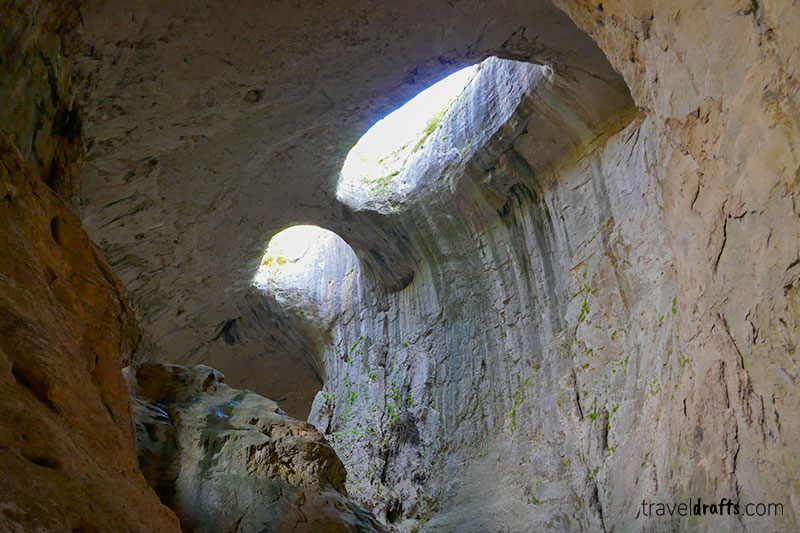
#44 Renting and driving a car in another country can be stressful, but our experience in Bulgaria was very smooth. Drivers in Bulgaria drive reasonably well, very different from Georgia and Armenia for example. They are slightly in a hurry in the bigger towns, but that happens almost everywhere nowadays.
Furthermore, we never had big traffic jams in Bulgaria, not even in Sofia, Plovdiv, or close to the beach. Maybe we are very lucky, but that’s definitely a big plus!

#45 One of the things you need to know before traveling to Bulgaria is that the roads are pretty bad. Not as bad as Armenia, but if that’s the term of comparison, it’s a very bad sign :). But seriously, be careful because you can get into potholes anywhere.
Are you enjoying this guide? Check the 50 things you need to know before going to Armenia!
#46 Nonetheless, while driving in Bulgaria, you should note a few important things:
- Many roads don’t have any markings, which is weirder than anything else.
- Even rare than Road markings are the speed limit signs… you can spend hours driving without seeing one 🙂
- If you travel by your own car, a road vignette is mandatory not at motorways but on all main roads too. It costs €8 for 7 days, and you can purchase it at the border or gas stations. It can’t be purchased online. You’ll see tons of signs advising about this.
- There aren’t highway tolls in Bulgaria, apart from the two bridges − New Europe Bridge and Danube Bridge, both at Danube border crossings to Romania.
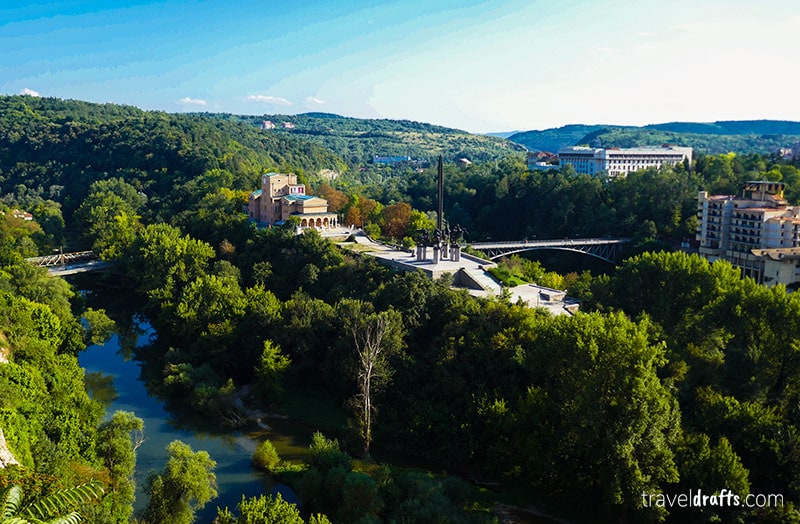
#47 Parking is usually a nightmare when traveling by car, particularly in city centers and highly touristy zones. However, in Bulgaria, it was fairly easy and/or inexpensive.
Most places had free parking, and when it wasn’t free it was cheap. Furthermore, finding a parking spot was always very easy.
Other useful information about traveling in Bulgaria
#48 You won’t have any problems getting WIFI in Bulgaria. Most restaurants, bars, and hotels have it for free. Also, if you have an EU sim card, you can use it for free, so you’ll also have a data sim card.

#49 Which vaccines do I need to go to Bulgaria? There is no mandatory vaccination to enter Bulgaria, but some are recommended. The CDC and WHO recommend vaccination against hepatitis A, hepatitis B, rabies, and influenza.
#50 Our final Bulgaria travel tip is: Buy local! It’s cheap, and you’ll help the locals. One of the best ways to buy locally in Bulgaria is from road vendors in the countryside. You’ll see people selling fruits, veggies, honey, nuts, and so on…
Do you remember what we said about the ingredients? They are crazy good! Believe me, you won’t regret it!
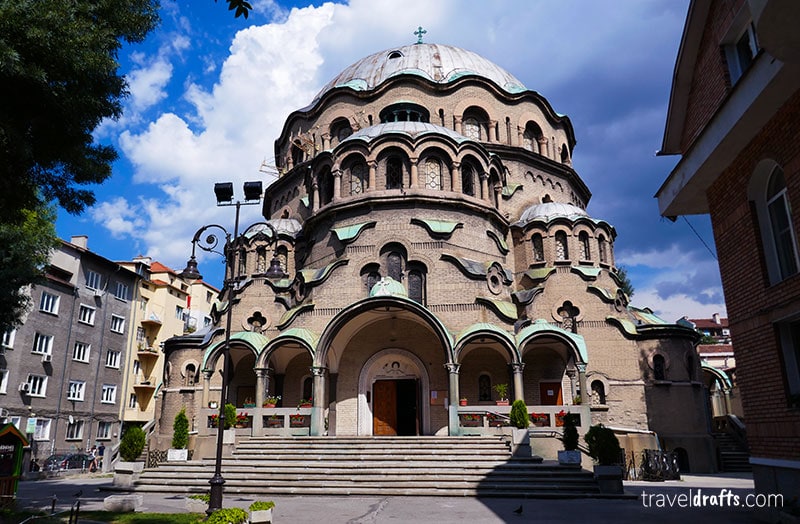
Our Recommended Travel Guide Books For Bulgaria
Our recommended Bulgaria travel Guide is the Bulgaria and Romania guide from Lonely Planet , which is particularly useful if you are visiting both Bulgaria and Romania.
Pin for later

Sharing is caring!
- Europe Tours
- Bulgaria Tours
Bulgaria Tours and Trips 2024/2025
Bulgaria is a diverse country, featuring a sweeping coastline along the Black Sea and a mountainous interior. The country is also home to a mix of Greek, Ottoman and Persian influences. Take a bicycle tour of Sofia to see landmarks like the impressive Vrana Palace, or head to seaside Varna to stroll its enchanting waterfront. If you love skiing and trekking, Bansko simply can’t be missed.
- Bulgaria Travel Guide
- Best Time To Visit Bulgaria
45 Trips in Bulgaria with 90 Reviews

- Starts Sofia, Bulgaria
- Ends Sofia, Bulgaria
Best of Balkans (4 Star Hotels)
- Best price guaranteed
- No booking fees
- Tour Type Group Tour
- Activities Sightseeing Tours & Art and architecture Sightseeing Tours , Art and architecture & Cultural, religious and historic sites 'data-more-tripid='17754'>+1 more
- Accommodation Hotel
- Transport Bus, Coach & Boat
- Age Range 18-39 yrs
- Operated in English
- Brochure Price: US$ 2,175
- Special Deal (45%): - US$ 979
- Total Price from: US$ 1,196
- Jul 06 10+ seats left
- Jul 13 10+ seats left
- View More Jan 1, 2019 Jan 2, 2019 Jan 3, 2019

Balkan Discovery (4 Star Hotels)
- Activities Sightseeing Tours & Art and architecture Sightseeing Tours , Art and architecture & Cultural, religious and historic sites 'data-more-tripid='17755'>+1 more
- Brochure Price: US$ 2,263
- Special Deal (45%): - US$ 1,018
- Total Price from: US$ 1,245

Bulgaria: Rodopi Mountains
- Tour Type Small Group Tour
- Activities Wildlife & Trekking and Hiking Wildlife , Trekking and Hiking & Safari 'data-more-tripid='7834'>+1 more
- Transport Bus & Minibus
- Age Range 16-95 yrs
- Brochure Price: US$ 2,098
- Special Deal (15%): - US$ 313
- Total Price from: US$ 1,785
- Jun 08 Only 2 seats left
- Jul 27 Only 8 seats left

Bulgaria: Realm of the Brown Bear
- Activities Wildlife & Bird watching Wildlife , Bird watching & Safari 'data-more-tripid='7962'>+1 more
- Transport Bus
- Sep 07 Only 1 seat left
- Oct 12 Only 8 seats left

Balkan Cycling
- Trip customizable
- Activities Bicycle tours & Museum and gallery visits Bicycle tours , Museum and gallery visits , Cultural, religious and historic sites & Countryside and village visits 'data-more-tripid='44348'>+2 more
- Accommodation Guest House & Hotel
- Age Range 14-80 yrs

Balkan Explorer
- Activities Food tours & Local culture Food tours , Local culture , Cultural, religious and historic sites & Trekking and Hiking 'data-more-tripid='9523'>+2 more
- Transport Boat
- Brochure Price: US$ 2,773
- Special Deal (5%): - US$ 133
- Total Price from: US$ 2,640
- Jun 07 Only 1 seat left
- Sep 13 Only 7 seats left

Bulgaria on Foot
- Activities Walking tours & Trekking and Hiking
- Accommodation Hotel, Hut & Resort
- Transport Private Vehicle
- Age Range 18-99 yrs
- Jun 22 10+ seats left

Highlights of Bulgaria by Bicycle
- Activities Bicycle tours
- Accommodation Hotel & Resort
- Age Range 18-95 yrs
- May 26 10+ seats left
- Jul 21 Only 10 seats left

- Starts Bucharest, Romania
- Ends Istanbul, Turkey
Eastern Europe Express
- Activities Sightseeing Tours & Art and architecture Sightseeing Tours , Art and architecture , Museum and gallery visits & Trekking and Hiking 'data-more-tripid='3670'>+2 more
- Transport Train, Bus, Private Vehicle & Taxi
- Age Range 15-99 yrs
- Brochure Price: US$ 1,690
- Special Deal (25%): - US$ 422
- Total Price from: US$ 1,268
- May 27 Only 3 seats left
- Jun 03 Only 7 seats left

Ancient Macedonia
- Activities Active and outdoor & Cultural, religious and historic sites
- Accommodation Hotel, Villa & Resort
- Transport Boat, Ferry & Bus
- Jun 02 Only 2 seats left
- Jul 21 Only 3 seats left

- Ends Athens, Greece
All About Balkans (4 Star Hotels)
- Activities Sightseeing Tours & Art and architecture Sightseeing Tours , Art and architecture & Cultural, religious and historic sites 'data-more-tripid='17753'>+1 more
- Brochure Price: US$ 2,497
- Special Deal (45%): - US$ 1,124
- Total Price from: US$ 1,373

Balkans Uncovered Luxury Tour
- Activities Explorer & Cultural, religious and historic sites Explorer , Cultural, religious and historic sites & Luxury 'data-more-tripid='31315'>+1 more
- Transport Coach, Boat & Yacht
- Age Range 18-80 yrs
- Brochure Price: US$ 4,846
- Special Deal (35%): - US$ 1,696
- Total Price from: US$ 3,150
- May 24 10+ seats left
- Jun 21 10+ seats left

Go Local: Best Of Bulgaria, Self-drive
- Tour Type Private Tour
- Activities Self-drive or vehicle rental & Art and architecture Self-drive or vehicle rental , Art and architecture & Food tours 'data-more-tripid='36382'>+1 more
- Age Range 6-99 yrs
- Brochure Price: US$ 1,205
- Special Deal (15%): - US$ 181
- Total Price from: US$ 1,024
- Jun 03 Only 4 seats left
- Jun 04 Only 4 seats left

- Starts Varna, Bulgaria
- Ends Varna, Bulgaria
Secrets Of Bulgaria, Private Tour
- Activities Art and architecture & Food tours
- Transport Train
- Age Range 10-99 yrs
- Operated in English, French, German
- Brochure Price: US$ 3,609
- Special Deal (15%): - US$ 541
- Total Price from: US$ 3,068
- May 28 Only 2 seats left
- May 29 Only 2 seats left
Traveling to Bulgaria? Chat with a local travel specialist in Bulgaria who can help organize your trip.
Bulgaria Tour Reviews
- Ilse Van Heerden
- Scott Jones
Bulgaria - Tour Highlights and Travel Tips
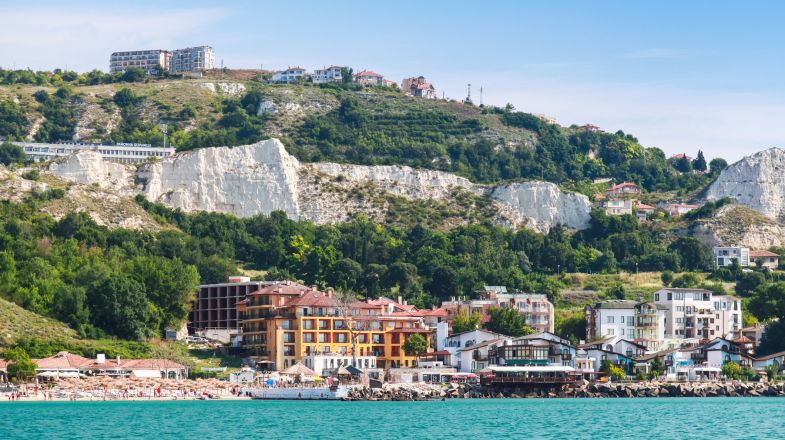
A trip to this Balkan nation offers attractions as diverse as its geography. With mountains and rivers calling out to the hiker and sunny beaches along the Black Sea luring the sun-bathers to its shores, this country truly offers something for everyone who is looking for an amazing vacation. Bulgaria’s cultural history is as varied as its attractions, with a history that includes the Greek, Ottoman, Slavic, and Persian peoples it is no wonder that a colorful history has produced such a fun-loving culture where the nightlife is as vibrant as any you could ask for along these Black Sea shores.
Tour Highlights
- Sunny Beach is the place to be, with over 130 restaurants, and 800 hotels boasting of 300,000 rooms, as well as some of the most beautiful beaches, and beach goers, along the Black Sea coast.
- Visit during the first week of June and take part in the Rose Festival, watch the rose parade, and maybe even meet the Rose Queen herself.
- Want to see a cathedral that can accommodate 10,000 people at a time? Visit the St. Alexander Nevsky Cathedral in Sofia!
- Smaller in size, but rich in history, the Bulgarian Orthodox Church features frescos that date to the 10th century for your consideration.
- Take a hike to see the Seven Rila Lakes in the Northwestern Rila Mountains. Visit in July or August for the most favorable weather conditions.
- For winter fun, try skiing or snowboarding in Bansko, just outside of Sofia. With ski season running from December to March there is plenty of time to schedule a vacation.
Travel Tips
- For a change of pace, try taking a bike tour of Sofia, it is an active way to enjoy the beautiful scenery.
- Public transportation is substandard, private busses, or taxis are a safer bet to get you where you need to be, when you need to be there.
- Trains are available to get you from village to village along the Black Sea coast, but be prepared for delays.
- Though slow, the trains can be comfortable. For a longer trip, try a sleeper car and travel in true comfort along the coast.
Bulgaria has seasonal weather so please do check up on the best time to visit Bulgaria before planning your tour. And if you’re still hunting for more things to do and places to explore in Bulgaria, do check out our Bulgaria Travel Guide for more information.
- Bulgaria budget tours
- Eco tours in Bulgaria
- Bulgaria guided tours
- Bulgaria family tour packages
- Bulgaria private tours
- Bulgaria small group tours
- Bulgaria solo trips
- Bulgaria tours for senior citizens
- Bulgaria tours for young adults
- Bulgaria group tours
- Bulgaria last minute deals
- Bulgaria travel deals
Popular Destinations
- Sofia Tours
Popular Activities
- Art and architecture tours
- Explorer tours
Upcoming Departures
- Spring 2024/2025
- Summer 2024/2025
- Winter 2024/2025
- August 2024
- September 2024
- October 2024
- November 2024
- December 2024
- January 2025
- February 2025
- August 2025
- September 2025
- October 2025
Best price guaranteed - No booking fees
Sign-in to unlock instant trip discounts. Create wish lists and save up to USD 1,500.

10 Highlights of Bulgaria
- December 7, 2016
- nvisiontravel
In Bulgaria you can spend at least 10 days and they will not be enough. All beautiful landmarks and interesting sites are located all over the country. You need to cross mountains and the transportation is not so fast. Per day you can visit not more than 2 – 3 sights. But if you have only the weekend, let us help you with some of the highlights of our country.
1) Buzludzha monument

One of the most famous abandoned buildings in Europe. It was built in 1981 with the money of the people and destroyed after the end of Communism in Bulgaria again by the people. Today it is located on a hill close to the town of Kazanlak and you can see it from outside.

The smallest town in Bulgaria, Melnik is famous with its red wine and the natural sand pyramids around the town. You can visit Melnik as part of your wine tour in Bulgaria. Near the town is located Rozhen monastery and many private wineries.

The second biggest city in Bulgaria will be the European capital of culture in 2019. The Old town of Plovdiv and Kapana art area are must visit. Enjoy a lunch there and taste some Bulgarian craft beer.
4) Rhodope Mountains

If you have more time, go deep to the South Bulgaria and enjoy a visit and overnight in some local village. The Rhodope Mountains are magical place where you will experience the authentic life of the local people and go back in time to the 19 century. This is one of the places for rural tourism in Bulgaria.
5) Rila monastery

The most famous monastery in Bulgaria is Rila monastery. Built in the 10 century, it still keeps the spirit of all Bulgarians. You can visit the monastery all year long.
6) Rose valley

At the central part of Bulgaria we keep our rose fields. The Bulgarian gold is hidden between two mountains. Each year (end of May – beginning of June) you can take part in the rose festival in Kazanlak and Karlovo area and learn more about the rose oil production in Bulgaria. If you stop in Kazanlak, visit some of the ancient Thracian tombs and learn more about the civilization, which used to live here before Christ.
7) Seven Rila lakes

For the summer we love to go for a day trip to hike to the Seven Rila lakes in Rila mountain. This is a way to recharge our batteries and enjoy the beautiful nature. Once per year all followers of Petar Danov are meeting there. They are dressed in white and are dancing the Panevritmia dance, they connect with the sun and Mother Nature.

You will not regret, if you choose Sofia for a weekend trip. The city will surprise you with a lot of culture, history, tasty food, cool bars and night clubs. It will be your starting point of a longer trip too.
9) Surva festival

If you visit Bulgaria at the end of January, you can go to Pernik. Each year there is a Surva festival. People are wearing costumes, dancing and trying to scare the bad spirits. The next festival will be 27 – 29.01.2017.
10) Veliko Turnovo

The Old capital of Bulgaria is located on a hill next to Yantra river. Walk in the old town, learn more about the Bulgarian crafts. Visit Tsarevets fortress and if you are lucky, enjoy the Sound and Light show in Veliko Tarnovo.
Share this post with your friends and follow our trips on Facebook and Instagram . Subscribe to our channel on YouTube and let us show you our beautiful country.
About Author
Stay connected to Cal.
Subscribe to our monthly email newsletter, The Cal Connection.
- Savings & Discounts
- Update Contact Info
- Membership FAQs
Benefit of the Week
The graduate wine collective.
- History & Tradition
- Our Programs
- Distinguished Alumni
- Diversity, Equity, Inclusion & Belonging
- Alumni House
- Shop CAA Gear
Stay Connected to Cal
- Career Services
- Alumni Chapters
- Student Resources
- Scholarships
Cal for All: Building an Inclusive STEM Pipeline: From Education to Industry
Special guests include Dr. Tsu-Jae King Liu , Dean of the UC Berkeley College of Engineering and Colette Patt ’85, Ph.D. ’95 , Assistant Dean for DEIBJ, UC Berkeley College of Computing .
- Make a Gift
- Give Scholarships

- Cal Discoveries Travel
- Destinations
- Experiences
- Tour Lecturers
- Travel News

Upcoming Tour
Southwest national parks 2024 [on request].
- Camps & Experiences
- Accommodations
- Group Rentals & Weddings
- Year-Round Cabins
Your Lair summer adventure is calling.
A great family vacation value.
- All Stories
- The Edge Podcast
- California Live!
- Class Notes
- About California Magazine
- Submission Guidelines

Latest Issue
2023 fall/winter.
- Get Involved
- Camp at the Lair
- California Magazine

Grand Danube Passage: Sofia to Prague 2025
October 15 - 30, 2025, from $6,245 (before special savings), tour highlights.
- Experience the timeless heritage and cultures of eight distinct countries while sailing the Danube River!
- Bookend your cruise with stays in Sofia, Bulgaria, and Prague, Czech Republic.
- Visit cathedrals, synagogues and fortresses that spring from the pages of storybooks, and stroll through medieval towns brimming with hallowed history.
- Explore Vienna, Bratislava and Belgrade, and feast your eyes on an illuminated Budapest on an evening cruise.
- Discover beauty around every bend, from the picturesque Wachau Valley to Melk Abbey and the Iron Gate Gorge to idyllic villages.
- Taste delicacies in Croatia’s Slavonia region and enjoy a folk show and Viennese waltz performance.
- Along the way, get a deeper look at select destinations with special “Personalize Your Journey” excursions that focus on cuisine, architecture and local life.
- There is no single supplement for solo travelers!
- If you are interested in more information about this trip, please click on the “Reserve Now” button to be taken to the AHI website.
* Cal lecturer’s participation cannot be guaranteed and is contingent upon a minimum number of paying travelers.
AHI Program Terms and Conditions. -->
Grand Danube Passage - Sofia to Prague | Oct. 15 – 30, 2025
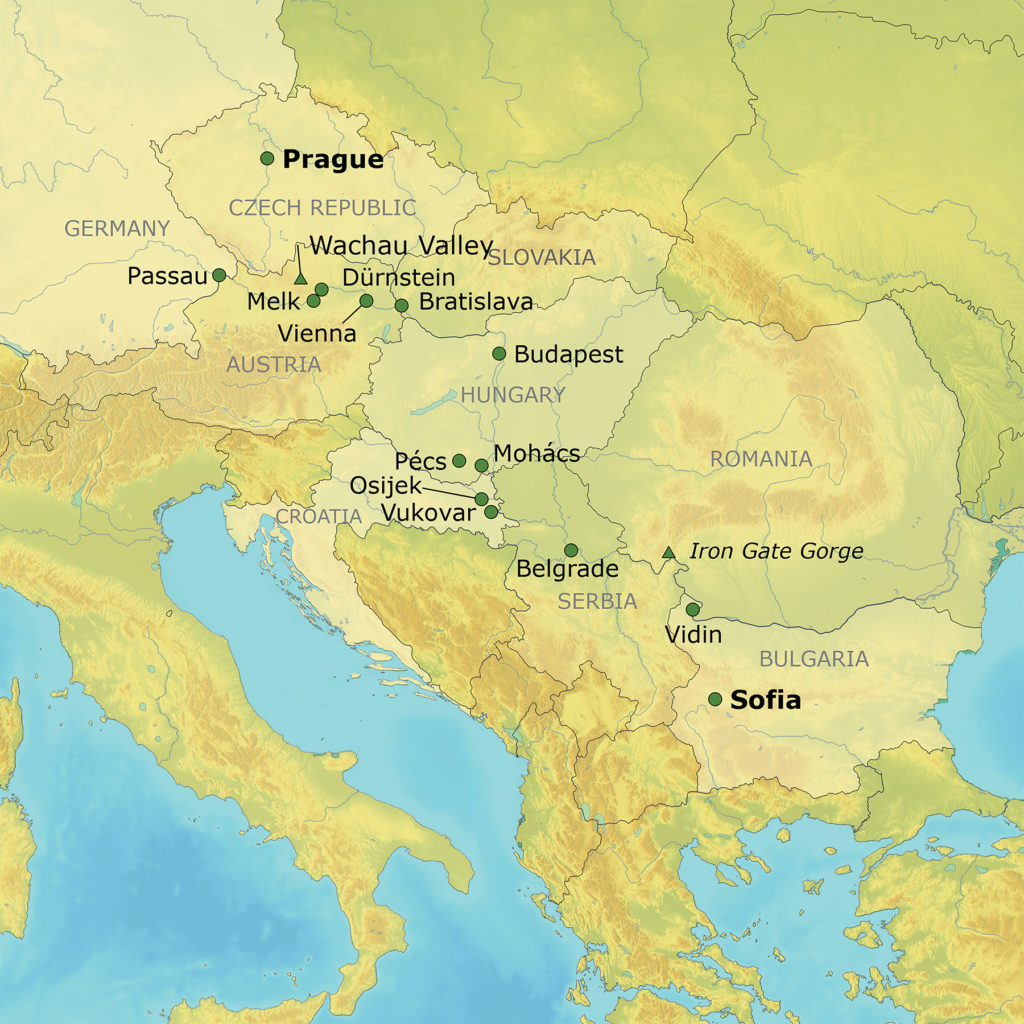
Explore More Tours

May 22 - May 30
U.S. & Canada
Spring 2024
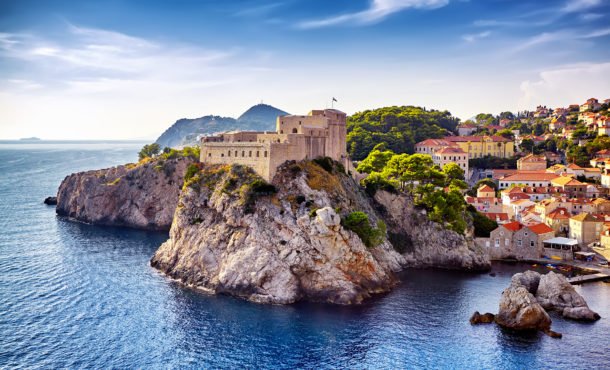
Croatia & Cruising the Dalmatian Coast 2024 [on request]
May 24 - Jun 04

Normandy: Honoring D-Day 80th Anniversary
May 25 - Jun 02
Spring 2024 , Summer 2024

Paris, featuring the African American Experience [on request]
Summer 2024
Travel Resources
- Activity-Level Ratings
- Travel FAQs
- Eligibility
- Reservations
- Travel Insurance
Our Tour Lecturers
Meet the faculty lecturers that accompany our trips and provide informative local lecturers to enhance your vacation.
- 510.900.8222
- [email protected]
- Subscribe to Our Newsletter
Our Partners

You are currently browsing
- Go to ETC Dashboard
More results...
- Our Structure
- Annual Reports
- Climate Action Plan
- Full Members
- Associate Members
- History of ETC
- Cooperation with the EU
- Requests for Proposals
- Publications
- Visual Content
- Market Intelligence Group
- Digital Channels
- Marketing Group
- Visa Facilitation
- Sustainability
- Connectivity
- Chapter Earth
- Tourism Manifesto
- Press Centre
07.05.2024. News
European tourism recovery continues into 2024, with travel expenditure expected to hit record numbers

- Foreign tourist arrivals and nights exceed 2019 levels in the first quarter of 2024.
- Recovery is steady but uneven across regions and source markets due to ongoing risks.
- Sporting events, high travel demand and inflation to drive tourist expenditure to record levels.
Europe’s tourism industry is experiencing a robust recovery in the first months of 2024 . Based on data from reporting destinations, foreign arrivals (+7.2%) and overnights (+6.5%) in the first quarter of the year surpassed 2019 figures. This continues the upward trend observed in 2023, which recorded foreign arrivals 1.2% below 2019 levels, and nights just 0.2% below. The recovery is largely driven by strong intra-regional travel fuelled by Germany, France, Italy, and the Netherlands. This is coupled with demand from the US, which continues to be Europe’s most important long-haul source market.
This is according to the latest edition of the ‘ European Tourism Trends & Prospects ’ quarterly report released today by the European Travel Commission (ETC). This report monitors the performance of European tourism in the first quarter of the year and the macroeconomic and geopolitical factors impacting the industry’s outlook on the continent.
Commenting on the report’s publication, Miguel Sanz, ETC’s President , said: “The early figures for 2024 reveal a positive outlook for European tourism this year. Consumer travel spending is set to rise notably across Europe, hitting record numbers in the coming months. This boost will support the travel and tourism businesses heavily impacted by the pandemic years and ongoing economic instability. Still, high prices and geopolitical risks remain key hurdles for tourism, as the sector as a whole also strives to adopt more responsible practices to benefit the locals and preserve the environment.”
Strong rebound for European tourism, but disparities remain
Year-to-date data shows that destinations in Southern Europe are leading the recovery in terms of international visitor numbers compared to 2019 levels, including Serbia (+47%), Bulgaria (+39%), Türkiye (+35%), Malta (+35%), Portugal (+17%), and Spain (+14%). These destinations offer competitively priced holiday experiences, often combined with milder winter temperatures. Nordic countries are also witnessing an uptake in tourist activity, as overnight stays grew above pre-pandemic levels. This increase is particularly evident for Norway (+18%), Sweden (+12%), and Denmark (+9%). This high interest is partially driven by winter sports tourism and the allure of the Northern Lights.
Meanwhile, countries in the Baltic region continue to lag behind due to challenges caused by the war in Ukraine, with Latvia registering the lowest post-pandemic international arrivals (-34%), followed by Estonia (-15%) and Lithuania (-14%).
Data from the first few months of 2024 also shows an uneven long-haul source market performance. The US and Canada continue to dominate, mirroring trends from 2023. There was also an increase in travellers from Latin America, particularly Brazil, during the first quarter of the year. Conversely, though the APAC region shows signs of improvement compared to last quarter, recovery remains modest and uneven. While Chinese travellers are beginning to return to Europe, recovery from Japan is still slow.
Despite challenges, consumer demand remains strong
Inflationary pressures and geopolitical uncertainties remain significant concerns for the European tourism industry. The war in Ukraine continues to impact tourism flows, particularly in Central and Eastern Europe. Meanwhile, the war between Israel and Hamas now significantly affects travel from Israel to Europe, with Israeli arrivals down 54% on last year in Q1 across reporting destinations. For tourism industry professionals, accommodation costs (59%), business costs (52%) and staff shortages (52%) are seen as the biggest challenges.
Conversely, online social conversations surrounding travel in Europe have overwhelmingly positive tones, surpassing discussions about other global regions such as the Americas, Africa, and Asia-Pacific in early 2024. Highlights include praise for seasonal beauty, outdoor adventures, and unique cultural events like Carnival celebrated across European countries.
Consumer data also shows that travel remains a top priority in 2024. Both intra-European and long-haul tourist spending increased in early 2024. Forecasts indicate that travellers will spend €742.8 billion in Europe this year, a 14.3% increase compared to 2023. This can be attributed to both inflation and evolving travel preferences, with travellers potentially opting for longer stays or more diverse experiences. Germany will be a main source of traveller expenditure, accounting for 16% of total spend in Europe in 2024.
Paris Olympics and Euros 2024 expected to drive demand in France and Germany
This summer will bring two major sporting events to Europe: the Olympic Games in France and the UEFA European Football Championship in Germany. The Olympics are expected to attract a surge in domestic and international tourists, with the impacts extending beyond the city of Paris itself. Inbound spending growth is projected at 13% for Paris and 24% for all of France on 2019 levels. The Euros will be less concentrated in the German capital, with games taking place across ten cities. This is expected to offer a more dispersed benefit, with all participating cities poised to experience a significant rise in tourism revenue.
Full report can be downloaded here
Press release.

European tourism draws close to pre-pandemic levels in 2023

International travellers to Europe prioritise safe destinations and affordable prices in 2024

Europe’s tourism displays a strong rebound, but remains uneven across the regions

Financial pressures shape Europeans’ travel plans in late 2023 and early 2024
Advertisement
Supported by
For Bulgarian Voters, It’s Groundhog Day, Again
The nation faces its sixth general election in three years. “I’ve done this so many times people have started to feel pity for me,” one legislator said about campaigning.
- Share full article

By Andrew Higgins
Reporting from Burgas and Sofia, Bulgaria
For citizens of the United States, Britain, India and dozens of other countries around the world, 2024 is a big, high-stakes election year .
For Dimitar Naydenov, a Bulgarian member of Parliament and restaurant owner, it offers only yet another Groundhog Day: Bulgaria in June holds its sixth general election in three years with a vote for a new Parliament. The total number of elections in those years is even higher — eight — if those for president and European Parliament are included.
“The same thing over and over. I’m very tired,” Mr. Naydenov said, shuddering at the thought that he will soon be back doing what he does before each Election Day — pitching a campaign tent in the central square of Burgas, a port city on the Black Sea, and standing for hours each day pleading with passers-by for their votes.
“I’ve done this so many times people have started to feel pity for me,” he said.
But pity Bulgarian voters, too. They keep casting ballots only to discover that the politicians they choose cannot form a stable government. So back to the polls, they go. Again and again.
Bulgaria is part of a wider problem shared across much of Europe, particularly former communist lands to the east: deep disillusionment with politicians and even the democratic process. But, as the poorest country in the European Union and also one of its most corrupt , Bulgaria has developed an unusually acute case of democratic dysfunction and disinterest.
On the surface, little divides Bulgaria’s two main political parties in their stated ideology. With the exception of the ultranationalist Revival party, support for which has surged during three years of constant elections, all profess strong support for Bulgaria’s membership in NATO and the European Union and hostility to Russia over its full-scale invasion of Ukraine .
But they are sharply divided on how to tackle corruption, which they each blame on their rivals, and how to purge state institutions of its influence.
Voter turnout has plummeted to 40 percent in the last general election , held less than a year ago, from 83 percent in the first post-Communist vote f or Parliament in 1991.
The low turnout, however, has been fairly constant throughout the recent spate of voting, suggesting that while a majority of voters see little point in elections, the public’s disillusionment has plateaued and that many have not yet given up.
“We have a highly volatile electorate looking for a savior,” said Ruzha Smilova, a professor of political science at Sofia University in the Bulgarian capital.
After the turmoil that followed the collapse of communism, Bulgarians looked to their former king, Simeon Saxe-Coburg-Gotha, who, after a half-century in exile, returned to form a political party. He was elected prime minister in 2001 on promises to transform the country in just 800 days.
He did not do that, though he did get Bulgaria into NATO in 2004. He lost electoral support and retired from politics.
“Messianic figures,” Ms. Smilova said, “usually only create disappointment and lead people to look for another savior.” Alternatively, they lead people to lose faith in the system and check out from politics.
Only 27 percent of Bulgarians, according to a survey last year by Globsec, a research group, trust their government. That was down from 35 percent in 2020 and below the 39 percent of people who trust the authorities in neighboring Romania, another often troubled former communist country.
Romania has recently seen a surge in support for a far-right party ahead of parliamentary and presidential election later this year. But its government, a shaky coalition of leftists and center-right liberals, has, unlike Bulgaria’s, managed to stagger on for four years.
The use of elections to try, so far in vain, to break Bulgaria’s political deadlock is at least a sign that the country has broken with the artificial stability of the communist era, when the same party always won and ruled unchallenged from 1946 until 1989.
But some fear that voters, fed up with constant churn, could opt for a would-be strongman leader promising an iron hand and order, a s voters in Slovakia did in a September legislative election.
“I worry that after so many elections people will be ready to say: ‘Great, we finally have a strong, stable leadership,’” said Vessela Tcherneva, who was a foreign policy adviser to a short-lived Bulgarian coalition government and is now deputy director in Sofia of the European Council on Foreign Relations.
When the European Union in 2006 approved Bulgaria’s membership application, its prime minister at the time, Sergei Stanishev, declared: “This is the genuine and final fall of the Berlin Wall for Bulgaria.”
In many ways, however, the wall is still standing thanks to one of communism’s most noxious and enduring legacies — the capture of state institutions by entrenched political and business interests.
“The post communist transition is still not finished. It is not about communism as an ideology anymore but about whether institutions should be independent,” another former prime minister, Kiril Petkov, said, referring to courts, regulatory agencies, prosecutors and state companies.
Mr. Petkov, a Harvard-educated leader of a party that says it wants to break the grip of vested interests on law enforcement and the judiciary, became prime minister in 2021 for what was supposed to be a four-year term at the head of a coalition government united under the slogan “zero tolerance for corruption.” He lasted seven months.
“The system is very resilient as we have discovered over the past few years,” said Dimitar Bechev, a Bulgarian lecturer at Oxford University’s School of Global and Area Studies. “It generates corruption and clientelism so there is no critical mass for reform of the status quo,” he added.
The U.S. Treasury Department last year imposed sanctions on five current and former Bulgarian officials from across the political spectrum, including two former ministers, over “their extensive involvement in corruption,” including what it said was the bribery of judges and officials.
Announcing the unusual move to freeze the assets of influential figures in a member of the European Union, Treasury said the five men’s “diverse profiles and longstanding prominence in Bulgarian politics illustrate the extent to which corruption has become entrenched across ministries, parties and state-owned industries and demonstrate the critical need for the political will to implement rule of law reform and to fight corruption.”
An earlier round of American sanctions in 2021 targeted Delyan Peevski, a former media mogul and a leader of a Bulgarian political party that ostensibly represents the interests of the Turkish minority. Mr. Peevski , according to the U.S. Treasury , “has regularly engaged in corruption, using influence peddling and bribes to protect himself from public scrutiny and exert control over key institutions.”
A plethora of upstart populist parties promising a new start have come and gone over the years, diluting support for more mainstream forces. Attack, a party led by a far-right television presenter, briefly surged but has now been replaced on the ultranationalist flank by Revival, which, according to opinion polls, has gone from being a tiny fringe outfit in 2021 to become the country’s third most popular party.
Bulgaria’s most enduring would-be savior is Boyko Borissov, a three-time prime minister and former bodyguard who first rose to prominence as the mayor of Sofia, presenting himself as Bulgaria’s Batman — a tough, no-nonsense avenger who would rid Gotham of corruption and instability.
Instead, he struggled with a long series of corruption scandals involving himself and his close allies. One of the most embarrassing erupted in 2020 after a photograph appeared in the news media showing the prime minister asleep naked in his official residence next to a night stand with a handgun. Other photographs showed the drawer of the night stand stuffed with 500-euro notes and gold ingots.
Mr. Borissov said that he typically kept a handgun nearby but that the photographs had been doctored, dismissing them as a politically motivated smear. He said voters, not leaked images, would decide on his fate, boasting that “nobody can beat me in elections.”
He lost the next election, eventually ceding power to Mr. Petkov, a founder of “We Continue the Change,” a party that rallied voters by vowing to break corrupt ties between politicians and business and free the judiciary and other state institutions from the influence of politics and money.
But, with Mr. Petkov’s party trailing the polls, Mr. Borissov could well be back, at least for a time, when voters again go to the polls in June.
Now facing his fifth election since he left office and short of money to fund yet another campaign, Mr. Petkov in an interview said he was losing hope that the June vote would break the political deadlock and give a clear mandate for change.
“I’m exhausted,” he said.
Boryana Dzhambazova contributed reporting from Sofia, Bulgaria.
Andrew Higgins is the East and Central Europe bureau chief for The Times based in Warsaw. He covers a region that stretches from the Baltic republics of Estonia, Latvia and Lithuania to Kosovo, Serbia and other parts of former Yugoslavia. More about Andrew Higgins

COMMENTS
Within Bulgaria's beguiling blend of nature and history, unforgettable adventures are guaranteed. Attractions Must-see attractions. Thracian Tomb of Sveshtari. Bulgaria. The highlight at this Unesco-protected Thracian settlement is a nearly perfectly preserved three-chamber burial tomb from about 300 BC. The high quality…
The Belogradchik Rocks, named in 2009 as Bulgaria's candidate to be selected as one of the New Seven Wonders of Nature, is a stunning arrangement of strange-shaped sandstone and conglomerate rock formations. 8. Lake Atanasovsko. Lake Burgas is a beautiful bright pink lake just west of Burgas.
Here's a look at the top tourist attractions in Bulgaria: 12. Alexander Nevsky Cathedral [SEE MAP] Situated in the heart of the stunning city of Sofia is the iconic symbol of Bulgaria: the Aleksander Nevsky Cathedral. Paid for by the people of the city and built between the years 1882 and 1912, the cathedral was constructed to honor the lives ...
3. Public Transport in Bulgaria. One of the biggest challenges of travelling in Bulgaria is getting around. The country's mountains tend to get in the way a lot, especially since so many popular things to do in Bulgaria are found in or near them. There are also drawbacks to public transport in Bulgaria.
Other highlights include the Seven Lakes route, Skakavitsa Waterfall, and the Rila Monastery. The monastery is the largest in Bulgaria and was established in the 10th century by Saint John of Rila. It's also a UNESCO World Heritage Site. ... Train - Train travel in Bulgaria is often cheaper than taking the bus, but it's a lot slower. For ...
Lake Atanasovsko, photo via Sofia Adventures. 5. Take a dip in a free seaside infinity pool. Bulgaria's Black Sea coast is one of THE preferred "wellness" getaway destinations in the Balkans, thanks to all its mineral water springs (and rock bottom prices compared to other wellness hotspots in Europe).
The Balkan country of Bulgaria has long been overlooked on standard European travel routes, where traditional tourists rarely travel farther east than Hungary or Croatia. However, for those more intrepid visitors keen to see the delights that southeastern Europe has to offer, planning a 5 to 10 days in Bulgaria itinerary is a fantastic idea.
In the pale morning light of May, this corner of Bulgaria is old-world bucolic. Zornitza, a member of the Relais & Châteaux hotel consortium, sprawls out across softly rolling pale-green hills ...
Bulgaria Travel Highlights. Visit Sofia. Sofia is the vibrant capital city of Bulgaria, full of museums, Eastern Orthodox churches, communist architecture and fashionable galleries, restaurants and clubs. Discover various architectural styles in Sofia, from Greek , Roman, Byzantine to Ottoman. The most famous sight is the magnificent gold-leaf ...
Bulgaria has little trouble enticing people to its beach resorts, but the eastern European country has much more to offer with the natural wonders of its Black Sea coast, towering mountain ranges ...
Image Source Sofia, the capital city, is one of the most gorgeous top places to visit in Bulgaria.There are various places to visit in Bulgaria, Sofia.Presenting a flawless amalgamation of old city and modern township, Sofia is home to 2000 years old churches, municipal buildings, and cathedrals on one hand and modern museums, art galleries, city parks and boulevards on the other.
In my case, I found a round-trip flight to Paris for $795. From Paris, I then booked a round trip to Sofia at $250 via Munich. A total of $1,045, a nice saving considering the initial price of $1,600.What's more, the reservations were among my eligible expenses to apply the $100 travel credit, which comes annually with my HSBC World Elite MD Mastercard MD.
Day 2: Three Monasteries in one day. This morning, visit of Dragalevtzi Monastery, situated at the foot of Vitosha Mountains Nature Park. There's an optional two-hour hike available in the surrounding area. Next, stop at the famous Boyana Church, a UNESCO World Heritage Site, with well-preserved valuable frescoes from the year 1259.
Plan your next travel and visit Bulgaria. Discover Bulgaria's rich history, stunning landscapes, and vibrant culture. Start your journey today!
We truly believe that Bulgaria is one of the most exciting countries in Europe, a hidden treasure in the heart of the Balkans. Our goal is to provide useful travel guides and practical information for visitors of the country, and in the same time, to highlight the beauty and values of Bulgaria.
12 Best Places To Visit In Bulgaria | Bulgaria Travel Guide#bulgaria #sofia #bulgariatravel #traveldestinations Embark on an extraordinary journey through th...
Sofia - Bansko: 2 hours Sofia - Plovdiv: 2.5 hours Plovdiv - Burgas (Black Sea): 2.5 hours Sofia - Rila Monastery: 2 hours. Give us a call. Written by Chris Owen. Bulgaria map & highlights. See our honest & easy to read Bulgaria map and highlights with sample itineraries and driving times. Read on in our Bulgaria map and highlights guide.
Thracian Tomb, Things to know before traveling to Bulgaria. #11 Bulgaria is the biggest producer of Rose oil in the World. In fact, it produces more than 80% of the world's Rose Oil and Rose Water. All the oil is produced in only one region, called Rose Valley, and it is regarded as the best in the world.
Bulgaria - Tour Highlights and Travel Tips . Summer cityscape view of Balchik beach. A trip to this Balkan nation offers attractions as diverse as its geography. With mountains and rivers calling out to the hiker and sunny beaches along the Black Sea luring the sun-bathers to its shores, this country truly offers something for everyone who is ...
The official tourism portal of Bulgaria's channel. Visit the official tourism portal - bulgariatravel.org!
5) Rila monastery. The most famous monastery in Bulgaria is Rila monastery. Built in the 10 century, it still keeps the spirit of all Bulgarians. You can visit the monastery all year long. 6) Rose valley. At the central part of Bulgaria we keep our rose fields. The Bulgarian gold is hidden between two mountains.
Tour Highlights. Experience the timeless heritage and cultures of eight distinct countries while sailing the Danube River! Bookend your cruise with stays in Sofia, Bulgaria, and Prague, Czech Republic. Visit cathedrals, synagogues and fortresses that spring from the pages of storybooks, and stroll through medieval towns brimming with hallowed ...
Highlights include praise for seasonal beauty, outdoor adventures, and unique cultural events like Carnival celebrated across European countries. Consumer data also shows that travel remains a top priority in 2024. Both intra-European and long-haul tourist spending increased in early 2024.
For Bulgarian Voters, It's Groundhog Day, Again. The nation faces its sixth general election in three years. "I've done this so many times people have started to feel pity for me," one ...